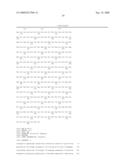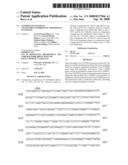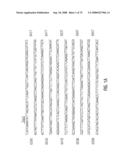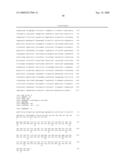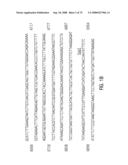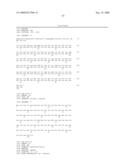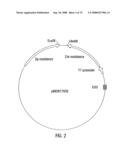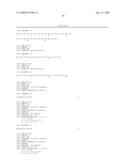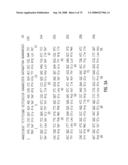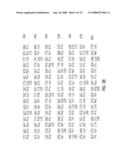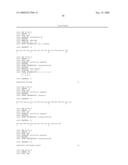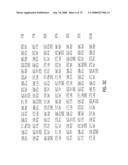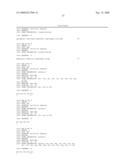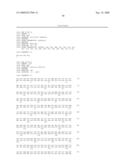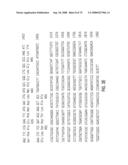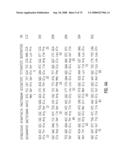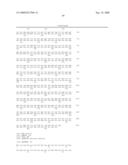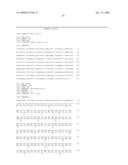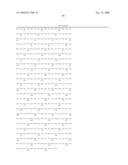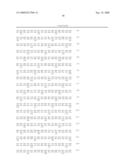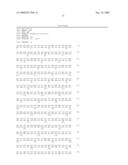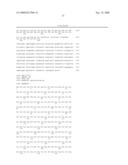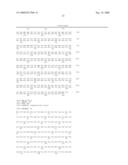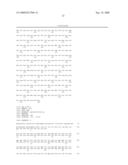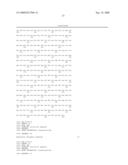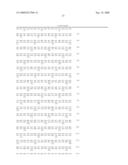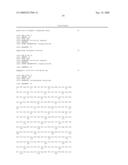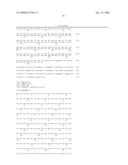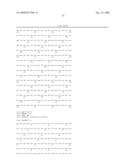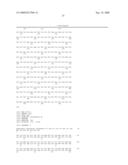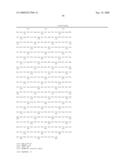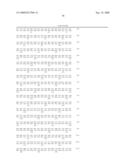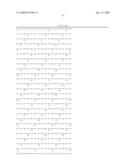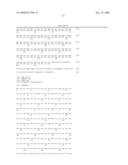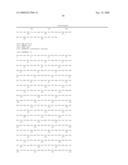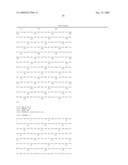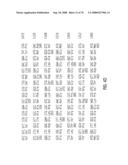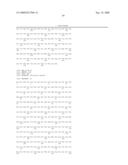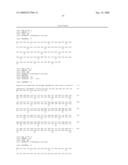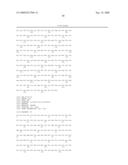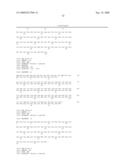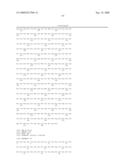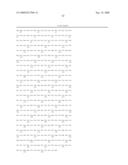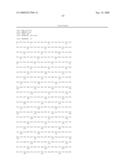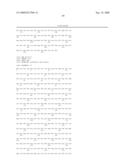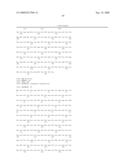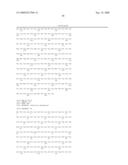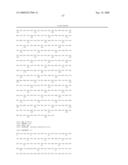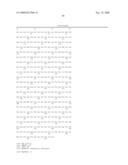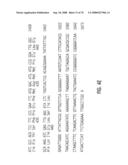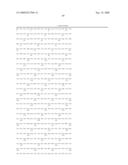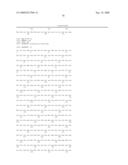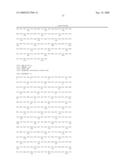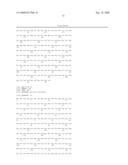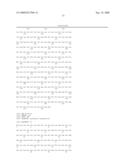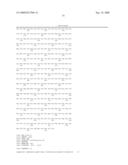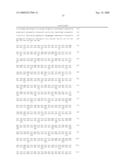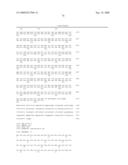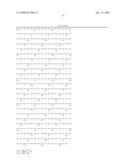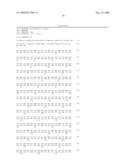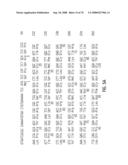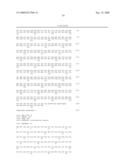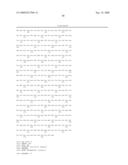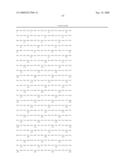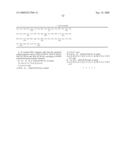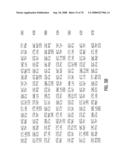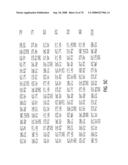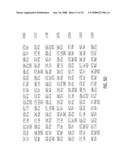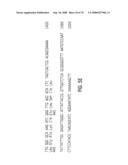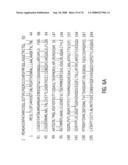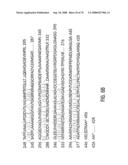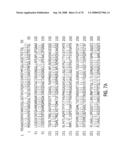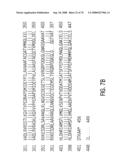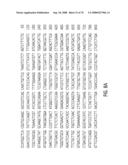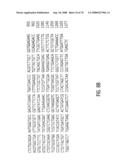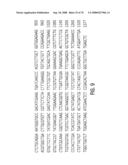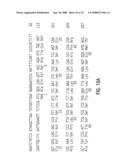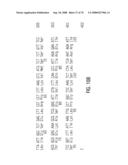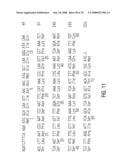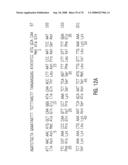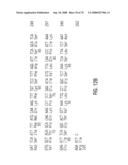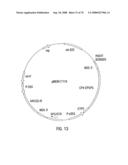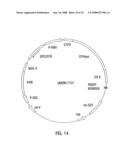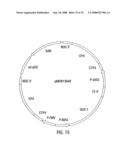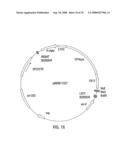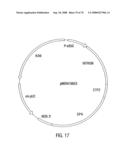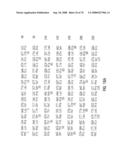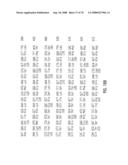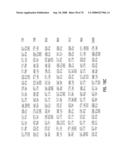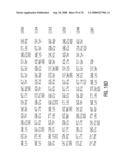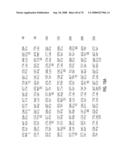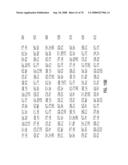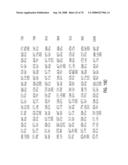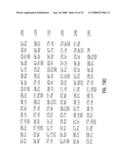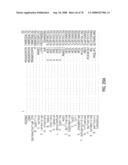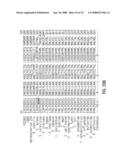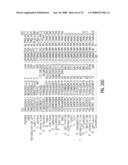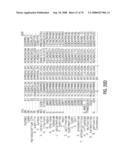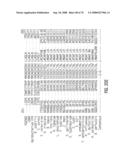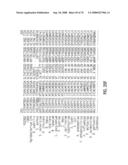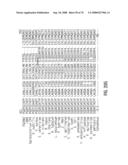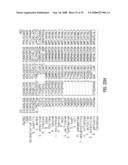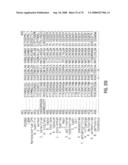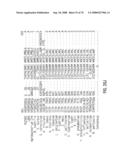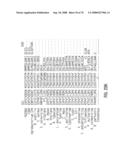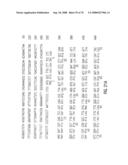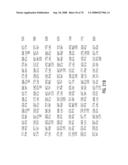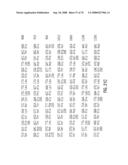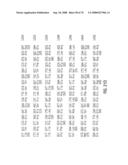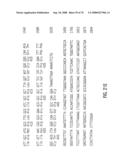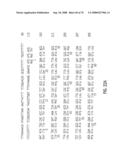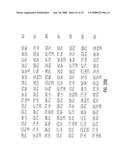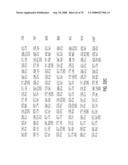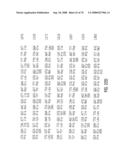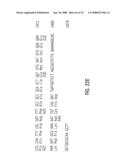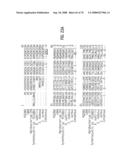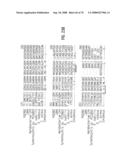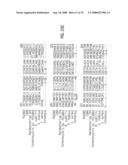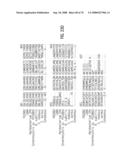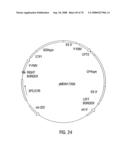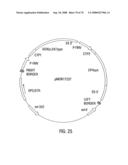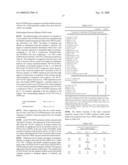Patent application title: Glyphosate-tolerant 5-enolpyruvylshikimate-3-phosphate synthases
Inventors:
Gerard Francis Barry (St. Louis, MO, US)
Ganesh Murthy Kishore (Creve Coeur, MO, US)
Stephen Rogers Padgette (Wildwood, MO, US)
William Carlton Stallings (Wildwood, MO, US)
Assignees:
Monsanto Technology LLC
IPC8 Class: AC07H2104FI
USPC Class:
536 232
Class name: N-glycosides, polymers thereof, metal derivatives (e.g., nucleic acids, oligonucleotides, etc.) dna or rna fragments or modified forms thereof (e.g., genes, etc.) encodes an enzyme
Publication date: 2008-09-18
Patent application number: 20080227966
Claims:
1. An isolated DNA sequence other than the structural coding sequence
listed in SEQ ID NO:41, SEQ ID NO:43 SEQ ID NO:66 and SEQ ID NO:68,
encoding an EPSPS enzyme having the sequence
domains:--R--X1--H--X2-E- (SEQ ID NO:37), in whichX1 is G,
S, T, C, Y, N, Q, D or E;X2 is S or T; and-G-D-K--X3-- (SEQ ID
NO:38), in whichX3 is S or T; and--S-A-Q-X4--K-- (SEQ ID
NO:39), in whichX4 is A, R, N, D, C, Q, E, G, H, I, L, K, M, F, P,
S, T, W, Y or V; and--N--X5-T-R-- (SEQ ID NO:40), in whichX5 is
A, R, N, D, C, Q, E, G, H, I, L, K, M, F, P, S, T, W, Y or V.Description:
[0001]This application is a continuation of copending U.S. patent
application Ser. No. 09/464,099; which is a divisional of U.S. patent
application Ser. No. 09/137,440, filed Aug. 20, 1998, now issued as U.S.
Pat. No. 6,248,876; which is a continuation of U.S. patent application
Ser. No. 08/833,485, filed Apr. 7, 1997, now issued as U.S. Pat. No.
5,804,425; which is a continuation of U.S. patent application Ser. No.
07/306,063, filed Sep. 13, 1994, now issued as U.S. Pat. No. 5,633,435;
which is a continuation-in-part of U.S. patent application Ser. No.
07/749,611, filed Aug. 28, 1991, now abandoned; which is a
continuation-in-part of U.S. patent application Ser. No. 07/576,537,
filed Aug. 31, 1990, now abandoned.
BACKGROUND OF THE INVENTION
[0002]This invention relates in general to plant molecular biology and, more particularly, to a new class of glyphosate-tolerant 5-enolpyruvylshikimate-3-phosphate synthases.
[0003]Recent advances in genetic engineering have provided the requisite tools to transform plants to contain foreign genes. It is now possible to produce plants which have unique characteristics of agronomic importance. Certainly, one such advantageous trait is more cost effective, environmentally compatible weed control via herbicide tolerance. Herbicide-tolerant plants may reduce the need for tillage to control weeds thereby effectively reducing soil erosion.
[0004]One herbicide which is the subject of much investigation in this regard is N-phosphonomethylglycine commonly referred to as glyphosate. Glyphosate inhibits the shikimic acid pathway which leads to the biosynthesis of aromatic compounds including amino acids, plant hormones and vitamins. Specifically, glyphosate curbs the conversion of phosphoenolpyruvic acid (PEP) and 3-phosphoshikimic acid to 5-enolpyruvyl-3-phosphoshikimic acid by inhibiting the enzyme 5-enolpyruvylshikimate-3-phosphate synthase (hereinafter) referred to as EPSP synthase or EPSPS). For purposes of the present invention, the term "glyphosate" should be considered to include any herbicidally effective form of N-phosphonomethylglycine (including any salt thereof) and other forms which result in the production of the glyphosate anion in planta.
[0005]It has been shown that glyphosate-tolerant plants can be produced by inserting into the genome of the plant the capacity to produce a higher level of EPSP synthase in the chloroplast of the cell (Shah et al., 1986) which enzyme is preferably glyphosate-tolerant (Kishore et al. 1988). Variants of the wild-type EPSPS enzyme have been isolated which are glyphosate-tolerant as a result of alterations in the EPSPS amino acid coding sequence (Kishore and Shah, 1988; Schulz et al., 1984; Sost et al., 1984; Kishore et al., 1986). These variants typically have a higher Ki for glyphosate than the wild-type EPSPS enzyme which confers the glyphosate-tolerant phenotype, but these variants are also characterized by a high Km for PEP which makes the enzyme kinetically less efficient (Kishore and Shah, 1988; Sost et al., 1984; Schulz et al., 1984; Kishore et al., 1986; Sost and Amrhein, 1990). For example, the apparent Km for PEP and the apparent Ki for glyphosate for the native EPSPS from E. coli are 10 μM and 0.5 μM while for a glyphosate-tolerant isolate having a single amino acid substitution of an alanine for the glycine at position 96 these values are 220 μM and 4.0 mM, respectively. A number of glyphosate-tolerant plant variant EPSPS genes have been constructed by mutagenesis. Again, the glyphosate-tolerant EPSPS was impaired due to an increase in the Km for PEP and a slight reduction of the Vmax of the native plant enzyme (Kishore and Shah, 1988) thereby lowering the catalytic efficiency (Vmax/Km) of the enzyme. Since the kinetic constants of the variant enzymes are impaired with respect to PEP, it has been proposed that high levels of overproduction of the variant enzyme, 40-80 fold, would be required to maintain normal catalytic activity in plants in the presence of glyphosate (Kishore et al., 1988).
[0006]While such variant EPSP synthases have proved useful in obtaining transgenic plants tolerant to glyphosate, it would be increasingly beneficial to obtain an EPSP synthase that is highly glyphosate-tolerant while still kinetically efficient such that the amount of the glyphosate-tolerant EPSPS needed to be produced to maintain normal catalytic activity in the plant is reduced or that improved tolerance be obtained with the same expression level.
[0007]Previous studies have shown that EPSPS enzymes from different sources vary widely with respect to their degree of sensitivity to inhibition by glyphosate. A study of plant and bacterial EPSPS enzyme activity as a function of glyphosate concentration showed that there was a very wide range in the degree of sensitivity to glyphosate. The degree of sensitivity showed no correlation with any genus or species tested (Schulz et al., 1985). Insensitivity to glyphosate inhibition of the activity of the EPSPS from the Pseudomonas sp. PG2982 has also been reported but with no details of the studies (Fitzgibbon, 1988). In general, while such natural tolerance has been reported, there is no report suggesting the kinetic superiority of the naturally occurring bacterial glyphosate-tolerant EPSPS enzymes over those of mutated EPSPS enzymes nor have any of the genes been characterized. Similarly, there are no reports on the expression of naturally glyphosate-tolerant EPSPS enzymes in plants to confer glyphosate tolerance.
[0008]For purposes of the present invention the term "mature EPSP synthase" relates to the EPSPS polypeptide without the N-terminal chloroplast transit peptide. It is now known that the precursor form of the EPSP synthase in plants (with the transit peptide) is expressed and upon delivery to the chloroplast, the transit peptide is cleaved yielding the mature EPSP synthase. All numbering of amino acid positions are given with respect to the mature EPSP synthase (without chloroplast transit peptide leader) to facilitate comparison of EPSPS sequences from sources which have chloroplast transit peptides (i.e., plants and fungi) to sources which do not utilize a chloroplast targeting signal (i.e., bacteria).
[0009]In the amino acid sequences which follow, the standard single letter or three letter nomenclature are used. All peptide structures represented in the following description are shown in conventional format in which the amino group at the N-terminus appears to the left and the carboxyl group at the C-terminus at the right. Likewise, amino acid nomenclature for the naturally occurring amino acids found in protein is as follows: alanine (Ala;A), asparagine (Asn;N), aspartic acid (Asp;D), arginine (Arg;R), cysteine (Cys;C), glutamic acid (Glu;E), glutamine (Gln;Q), glycine (Gly;G), histidine (His;H), isoleucine (Ile;I), leucine (Leu;L), lysine (Lys;K), methionine (Met;M), phenylalanine (Phe;F), proline (Pro;P), serine (Ser;S), threonine (Thr;T), tryptophan (Trp;W), tyrosine (Tyr;Y), and valine (Val;V). An "X" is used when the amino acid residue is unknown and parentheses designate that an unambiguous assignment is not possible and the amino acid designation within the parentheses is the most probable estimate based on known information.
[0010]The term "nonpolar" amino acids include alanine, valine, leucine, isoleucine, proline, phenylalanine, tryptophan, and methionine. The term "uncharged polar" amino acids include glycine, serine, threonine, cysteine, tyrosine, asparagine and glutamine. The term "charged polar" amino acids includes the "acidic" and "basic" amino acids. The term "acidic" amino acids includes aspartic acid and glutamic acid. The term "basic" amino acid includes lysine, arginine and histidine. The term "polar" amino acids includes both "charged polar" and "uncharged polar" amino acids.
[0011]Deoxyribonucleic acid (DNA) is a polymer comprising four mononucleotide units, dAMP (2'-Deoxyadenosine-5-monophosphate), dGMP (2'-Deoxyguanosine-5-monophosphate), dCMP (2'-Deoxycytosine-5-monophosphate) and dTMP (2'-Deoxythymosine-5-monophosphate) linked in various sequences by 3',5'-phosphodiester bridges. The structural DNA consists of multiple nucleotide triplets called "codons" which code for the amino acids. The codons correspond to the various amino acids as follows: Arg (CGA, CGC, CGG, CGT, AGA, AGG); Leu (CTA, CTC, CTG, CTT, TTA, TTG); Ser (TCA, TCC, TCG, TCT, AGC, AGT); Thr (ACA, ACC, ACG, ACT); Pro (CCA, CCC, CCG, CCT); Ala (GCA, GCC, GCG, GCT); Gly (GGA, GGC, GGG, GGT); Ile (ATA, ATC, ATT); Val (GTA, GTC, GTG, GTT); Lys (AAA, AAG); Asn (AAC, AAT); Gln (CAA, CAG); His (CAC, CAT); Glu (GAA, GAG); Asp (GAC, GAT); Tyr (TAC, TAT); Cys (TGC, TGT); Phe (TTC, TTT); Met (ATG); and Trp (UGG). Moreover, due to the redundancy of the genetic code (i.e., more than one codon for all but two amino acids), there are many possible DNA sequences which may code for a particular amino acid sequence.
SUMMARY OF THE INVENTION
[0012]DNA molecules comprising DNA encoding kinetically efficient, glyphosate-tolerant EPSP synthases are disclosed. The EPSP synthases of the present invention reduce the amount of overproduction of the EPSPS enzyme in a transgenic plant necessary for the enzyme to maintain catalytic activity while still conferring glyphosate tolerance. The EPSP synthases described herein represent a new class of EPSPS enzymes, referred to hereinafter as Class II EPSPS enzymes. Class II EPSPS enzymes of the present invention usually share only between about 47% and 55% amino acid similarity or between about 22% and 30% amino acid identity to other known bacterial or plant EPSPS enzymes and exhibit tolerance to glyphosate while maintaining suitable Km (PEP) ranges. Suitable ranges of Km (PEP) for EPSPS for enzymes of the present invention are between 1-150 μM, with a more preferred range of between 1-35 μM, and a most preferred range between 2-25 μM. These kinetic constants are determined under the assay conditions specified hereinafter. An EPSPS of the present invention preferably has a Ki for glyphosate range of between 15-10000 μM. The Ki/Km ratio should be between about 2-500, and more preferably between 25-500. The Vmax of the purified enzyme should preferably be in the range of 2-100 units/mg (μmoles/minute.mg at 25° C.) and the Km for shikimate-3-phosphate should preferably be in the range of 0.1 to 50 μM.
[0013]Genes coding for Class II EPSPS enzymes have been isolated from five (5) different bacteria: Agrobacterium tumefaciens sp. strain CP4, Achromobacter sp. strain LBAA, Pseudomonas sp. strain PG2982, Bacillus subtilis, and Staphylococcus aureus. The LBAA and PG2982 Class II EPSPS genes have been determined to be identical and the proteins encoded by these two genes are very similar to the CP4 protein and share approximately 84% amino acid identity with it. Class II EPSPS enzymes often may be distinguished from Class I EPSPS's by their inability to react with polyclonal antibodies prepared from Class I EPSPS enzymes under conditions where other Class I EPSPS enzymes would readily react with the Class I antibodies as well as the presence of certain unique regions of amino acid homology which are conserved in Class II EPSP synthases as discussed hereinafter.
[0014]Other Class II EPSPS enzymes can be readily isolated and identified by utilizing a nucleic acid probe from one of the Class II EPSPS genes disclosed herein using standard hybridization techniques. Such a probe from the CP4 strain has been prepared and utilized to isolate the Class II EPSPS genes from strains LBAA and PG2982. These genes may also optionally be adapted for enhanced expression in plants by known methodology. Such a probe has also been used to identify homologous genes in bacteria isolated de novo from soil.
[0015]The Class II EPSPS enzymes are preferably fused to a chloroplast transit peptide (CTP) to target the protein to the chloroplasts of the plant into which it may be introduced. Chimeric genes encoding this CTP-Class II EPSPS fusion protein may be prepared with an appropriate promoter and 3' polyadenylation site for introduction into a desired plant by standard methods.
[0016]To obtain the maximal tolerance to glyphosate herbicide it is preferable to transform the desired plant with a plant-expressible Class II EPSPS gene in conjunction with another plant-expressible gene which expresses a protein capable of degrading glyphosate such as a plant-expressible gene encoding a glyphosate oxidoreductase enzyme as described in PCT Application No. WO 92/00377, the disclosure of which is hereby incorporated by reference.
[0017]Therefore, in one aspect, the present invention provides a new class of EPSP synthases that exhibit a low Km for phosphoenolpyruvate (PEP), a high Vmax/Km ratio, and a high Ki for glyphosate such that when introduced into a plant, the plant is made glyphosate-tolerant such that the catalytic activity of the enzyme and plant metabolism are maintained in a substantially normal state. For purposes of this discussion, a highly efficient EPSPS refers to its efficiency in the presence of glyphosate.
[0018]More particularly, the present invention provides EPSPS enzymes having a Km for phosphoenolpyruvate (PEP) between 1-150 μM and a Ki(glyphosate)/Km(PEP) ratio between 3-500, said enzymes having the sequence domains:
R--X--H--X2-E- (SEQ ID NO:37), in which
[0019]X1 is an uncharged polar or acidic amino acid,
[0020]X2 is serine or threonine; and
-G-D-K--X3-- (SEQ ID NO:38), in which
[0021]X3 is serine or threonine; and
S-A-Q-X4--K-- (SEQ ID NO:39), in which
[0022]X4 is any amino acid; and
N--X5-T-R-- (SEQ ID:40), in which
[0023]X5 is any amino acid.
[0024]Exemplary Class II EPSPS enzyme sequences are disclosed from seven sources: Agrobacterium sp. strain designated CP4, Achromobacter sp. strain LBAA, Pseudomonas sp. strain PG2982, Bacillus subtilis 1A2, Staphylococcus aureus (ATCC 35556), Synechocystis sp. PCC6803 and Dichelobacter nodosus.
[0025]In another aspect of the present invention, a double-stranded DNA molecule comprising DNA encoding a Class II EPSPS enzyme is disclosed. Exemplary Class II EPSPS enzyme DNA sequences are disclosed from seven sources: Agrobacterium sp. strain designated CP4, Achromobacter sp. strain LBAA, Pseudomonas sp. strain PG2982, Bacillus subtilis 1A2, Staphylococcus aureus (ATCC 35556), Synechocystis sp. PCC6803 and Dichelobacter nodosus.
[0026]In a further aspect of the present invention, nucleic acid probes from EPSPS Class II genes are presented that are suitable for use in screening for Class II EPSPS genes in other sources by assaying for the ability of a DNA sequence from the other source to hybridize to the probe.
[0027]In yet another aspect of the present invention, a recombinant, double-stranded DNA molecule comprising in sequence: [0028]a) a promoter which functions in plant cells to cause the production of an RNA sequence; [0029]b) a structural DNA sequence that causes the production of an RNA sequence which encodes a Class II EPSPS enzyme having the sequence domains: [0030]--R--X1--H--X2-E- (SEQ ID NO:37), in which [0031]X1 is an uncharged polar or acidic amino acid, [0032]X2 is serine or threonine; and [0033]-G-D-K--X3-- (SEQ ID NO:38), in which [0034]X3 is serine or threonine; and [0035]--S-A-Q-X4--K-- (SEQ ID NO:39), in which X4 is any amino acid; and
[0036]N--X5-T-R-- (SEQ ID:40), in which [0037]X5 is any amino acid; and [0038]c) a 3' nontranslated region which functions in plant cells to cause the addition of a stretch of polyadenyl nucleotides to the 3' end of the RNA sequencewhere the promoter is heterologous with respect to the structural DNA sequence and adapted to cause sufficient expression of the EPSP synthase polypeptide to enhance the glyphosate tolerance of a plant cell transformed with said DNA molecule.
[0039]In still yet another aspect of the present invention, transgenic plants and transformed plant cells are disclosed that are made glyphosate-tolerant by the introduction of the above-described plant-expressible Class II EPSPS DNA molecule into the plant's genome.
[0040]In still another aspect of the present invention, a method for selectively controlling weeds in a crop field is presented by planting crop seeds or crop plants transformed with a plant-expressible Class II EPSPS DNA molecule to confer glyphosate tolerance to the plants which allow for glyphosate containing herbicides to be applied to the crop to selectively kill the glyphosate sensitive weeds, but not the crops.
[0041]Other and further objects, advantages and aspects of the invention will become apparent from the accompanying drawing figures and the description of the invention.
BRIEF DESCRIPTION OF THE DRAWINGS
[0042]FIGS. 1A and 1B show the DNA sequence (SEQ ID NO:1) for the full-length promoter of figwort mosaic virus (FMV35S).
[0043]FIG. 2 shows the cosmid cloning vector pMON17020.
[0044]FIGS. 3A, 3B, 3C, 3D and 3E show the structural DNA sequence (SEQ ID NO:2) for the Class II EPSPS gene from bacterial isolate Achromobacterium sp. strain CP4 and the deduced amino acid sequence (SEQ ID NO:3).
[0045]FIGS. 4A, 4B, 4C, 4D and 4E show the structural DNA sequence (SEQ ID NO:4) for the Class II EPSPS gene from the bacterial isolate Achromobacter sp. strain LBAA and the deduced amino acid sequence (SEQ ID NO:5).
[0046]FIGS. 5A, 5B, 5C, 5D and 5E show the structural DNA sequence (SEQ ID NO:6) for the Class II EPSPS gene from the bacterial isolate Pseudomonas sp. strain PG2982 and the deduced amino acid sequence (SEQ ID NO:7).
[0047]FIGS. 6A and 6B show the Bestfit comparison of the CP4 EPSPS amino acid sequence (SEQ ID NO:3) with that for the E. coli EPSPS (SEQ ID NO:8).
[0048]FIGS. 7A and 7B show the Bestfit comparison of the CP4 EPSPS amino acid sequence (SEQ ID NO:3) with that for the LBAA EPSPS (SEQ ID NO:5).
[0049]FIGS. 8A and 8B show the structural DNA Sequence (SEQ ID NO:9) for the synthetic CP4 Class II EPSPS gene.
[0050]FIG. 9 shows the DNA sequence (SEQ ID NO:10) of the chloroplast transit peptide (CTP) and encoded amino acid sequence (SEQ ID NO:11) derived from the Arabidopsis thaliana EPSPS CTP and containing a SphI restriction site at the chloroplast processing site, hereinafter referred to as CTP2.
[0051]FIGS. 10A and 10B show the DNA sequence (SEQ ID NO:12) of the chloroplast transit peptide and encoded amino acid sequence (SEQ ID NO:13) derived from the Arabidopsis thaliana EPSPS gene and containing an EcoRI restriction site within the mature region of the EPSPS, hereinafter referred to as CTP3.
[0052]FIG. 11 shows the DNA sequence (SEQ ID NO:14) of the chloroplast transit peptide and encoded amino sequence (SEQ ID NO:15) derived from the Petunia hybrida EPSPS CTP and containing a SphI restriction site at the chloroplast processing site and in which the amino acids at the processing site are changed to -Cys-Met-, hereinafter referred to as CTP4.
[0053]FIGS. 12A and 12B show the DNA sequence (SEQ ID NO:16) of the chloroplast transit peptide and encoded amino acid sequence (SEQ ID NO:17) derived from the Petunia hybrida EPSPS gene with the naturally occurring EcoRI site in the mature region of the EPSPS gene, hereinafter referred to as CTP5.
[0054]FIG. 13 shows a plasmid map of CP4 plant transformation/expression vector pMON17110.
[0055]FIG. 14 shows a plasmid map of CP4 synthetic EPSPS gene plant transformation/expression vector pMON17131.
[0056]FIG. 15 shows a plasmid map of CP4 synthetic EPSPS free DNA plant transformation expression vector pMON13640.
[0057]FIG. 16 shows a plasmid map of CP4 plant transformation/direct selection vector pMON17227.
[0058]FIG. 17 shows a plasmid map of CP4 plant transformation/expression vector pMON19653.
[0059]FIGS. 18A, 18B, 18C and 18D show the structural DNA sequence (SEQ ID NO:41) for the Class II EPSPS gene from the bacterial isolate Bacillus subtilis and the deduced amino acid sequence (SEQ ID NO:42).
[0060]FIGS. 19A, 19B, 19C and 19D show the structural DNA sequence (SEQ ID NO:43) for the Class II EPSPS gene from the bacterial isolate Staphylococcus aureus and the deduced amino acid sequence (SEQ ID NO:44).
[0061]FIGS. 20A, 20B, 20C, 20D, 20E, 20F, 20G, 20H, 20I, 20J and 20K show the Bestfit comparison of the representative Class II EPSPS amino acid sequences Pseudomonas sp. strain PG2982 (SEQ ID NO:7), Achromobacter sp. strain LBAA (SEQ ID NO:5), Agrobacterium sp. strain designated CP4 (SEQ ID NO:3), Bacillus subtilis SEQ ID NO:42), and Staphylococcus aureus (SEQ ID NO:44) with that for representative Class I EPSPS amino acid sequences [Sacchromyces cerevisiae (SEQ ID NO:49), Aspergillus nidulans (SEQ ID NO:50), Brassica napus (SEQ ID NO:51), Arabidopsis thaliana (SEQ ID NO:52), Nicotina tobacum (SEQ ID NO:53), L. esculentum (SEQ ID NO:54), Petunia hybrida (SEQ ID NO:55), Zea mays (SEQ ID NO:56), Solmenella gallinarum (SEQ ID NO:57), Solmenella typhimurium (SEQ ID NO:58), Solmenella typhi (SEQ ID NO:65), E. coli (SEQ ID NO:8), K. pneumoniae (SEQ ID NO:59), Y. enterocolitica (SEQ ID NO:60), H. influenzae (SEQ ID NO:61), P. multocida (SEQ ID NO:62), Aeromonas salmonicida (SEQ ID NO:63), Bacillus pertussis (SEQ ID NO:64), and illustrates the conserved regions among Class II EPSPS sequences. To aid in a comparison of the EPSPS sequences, only mature EPSPS sequences were compared. That is, the sequence corresponding to the chloroplast transit peptide, if present in a subject EPSPS, was removed prior to making the sequence alignment.
[0062]FIGS. 21A, 21B, 21C, 21D and 21E show the structural DNA sequence (SEQ ID NO:66) for the Class II EPSPS gene from the bacterial isolate Synechocystis sp. PCC6803 and the deduced amino acid sequence (SEQ ID NO:67)
[0063]FIGS. 22A, 22B, 22C, 22D and 22E show the structural DA sequence (SEQ ID NO:68) for the Class II EPSPS gene from the bacterial isolate Dichelobacter nodosus and the deduced amino acid sequence (SEQ ID NO:69).
[0064]FIGS. 23A, 23B, 23C and 23D show the Bestfit comparison of the representative Class II EPSPS amino acid sequences Pseudomonas sp. strain PG2982 (SEQ ID NO:7), Achromobacter sp. strain LBAA (SEQ ID NO:5), Agrobacterium sp. strain designated CP4 (SEQ ID NO:3), Synechocystis sp. PCC6803 (SEQ ID NO:67), Bacillus subtilis (SEQ ID NO:42), Dichelobacter nodosus (SEQ ID NO:69) and Staphylococcus aureus (SEQ ID NO:44).
[0065]FIG. 24 a plasmid map of canola plant transformation/expression vector pMON17209.
[0066]FIG. 25 a plasmid map of canola plant transformation/expression vector pMON17237.
STATEMENT OF THE INVENTION
[0067]The expression of a plant gene which exists in double-stranded DNA form involves synthesis of messenger RNA (mRNA) from one strand of the DNA by RNA polymerase enzyme, and the subsequent processing of the mRNA primary transcript inside the nucleus. This processing involves a 3' non-translated region which adds polyadenylate nucleotides to the 3' end of the RNA.
[0068]Transcription of DNA into mRNA is regulated by a region of DNA usually referred to as the "promoter." The promoter region contains a sequence of bases that signals RNA polymerase to associate with the DNA, and to initiate the transcription into mRNA using one of the DNA strands as a template to make a corresponding complementary strand of RNA. A number of promoters which are active in plant cells have been described in the literature. These include the nopaline synthase (NOS) and octopine synthase (OCS) promoters (which are carried on tumor-inducing plasmids of Agrobacterium tumefaciens), the cauliflower mosaic virus (CaMV) 19S and 35S promoters, the light-inducible promoter from the small subunit of ribulose bis-phosphate carboxylase (ssRUBISCO, a very abundant plant polypeptide) and the full-length transcript promoter from the figwort mosaic virus (FMV35S), promoters from the maize ubiquitin and rice actin genes. All of these promoters have been used to create various types of DNA constructs which have been expressed in plants; see, e.g., PCT publication WO 84/02913 (Rogers et al., Monsanto).
[0069]Promoters which are known or found to cause transcription of DNA in plant cells can be used in the present invention. Such promoters may be obtained from a variety of sources such as plants and plant DNA viruses and include, but are not limited to, the CaMV35S and FMV35S promoters and promoters isolated from plant genes such as ssRUBISCO genes and the maize ubiquitin and rice actin genes. As described below, it is preferred that the particular promoter selected should be capable of causing sufficient expression to result in the production of an effective amount of a Class II EPSPS to render the plant substantially tolerant to glyphosate herbicides. The amount of Class II EPSPS needed to induce the desired tolerance may vary with the plant species. It is preferred that the promoters utilized have relatively high expression in all meristematic tissues in addition to other tissues inasmuch as it is now known that glyphosate is translocated and accumulated in this type of plant tissue. Alternatively, a combination of chimeric genes can be used to cumulatively result in the necessary overall expression level of the selected Class II EPSPS enzyme to result in the glyphosate-tolerant phenotype.
[0070]The mRNA produced by a DNA construct of the present invention also contains a 5' non-translated leader sequence. This sequence can be derived from the promoter selected to express the gene, and can be specifically modified so as to increase translation of the mRNA. The 5' non-translated regions can also be obtained from viral RNAs, from suitable eukaryotic genes, or from a synthetic gene sequence. The present invention is not limited to constructs, as presented in the following examples, wherein the non-translated region is derived from both the 5' non-translated sequence that accompanies the promoter sequence and part of the 5' non-translated region of the virus coat protein gene. Rather, the non-translated leader sequence can be derived from an unrelated promoter or coding sequence as discussed above.
[0071]Preferred promoters for use in the present invention the full-length transcript (SEQ ID NO:1) promoter from the figwort mosaic virus (FMV35S) and the full-length transcript (35S) promoter from cauliflower mosaic virus (CaMV), including the enhanced CaMV35S promoter (Kay et al. 1987). The FMV35S promoter functions as strong and uniform promoter with particularly good expression in meristematic tissue for chimeric genes inserted into plants, particularly dicotyledons. The resulting transgenic plant in general expresses the protein encoded by the inserted gene at a higher and more uniform level throughout the tissues and cells of the transformed plant than the same gene driven by an enhanced CaMV35S promoter. Referring to FIG. 1, the DNA sequence (SEQ ID NO:1) of the FMV35S promoter is located between nucleotides 6368 and 6930 of the FMV genome. A 5' non-translated leader sequence is preferably coupled with the promoter. The leader sequence can be from the FMV35S genome itself or can be from a source other than FMV35S.
[0072]For expression of heterologous genes in moncotyledonous plants the use of an intron has been found to enhance expression of the heterologous gene. While one may use any of a number of introns which have been isloated from plant genes, the use of the first intron from the maize heat shock 70 gene is preferred.
[0073]The 3' non-translated region of the chimeric plant gene contains a polyadenylation signal which functions in plants to cause the addition of polyadenylate nucleotides to the 3' end of the viral RNA. Examples of suitable 3' regions are (1) the 3' transcribed, non-translated regions containing the polyadenylated signal of Agrobacterium tumor-inducing (Ti) plasmid genes, such as the nopaline synthase (NOS) gene, and (2) plant genes like the soybean storage protein genes and the small subunit of the ribulose-1,5-bisphosphate carboxylase (ssRUBISCO) gene. An example of a preferred 3' region is that from the ssRUBISCO gene from pea (E9), described in greater detail below.
[0074]The DNA constructs of the present invention also contain a structural coding sequence in double-stranded DNA form which encodes a glyphosate-tolerant, highly efficient Class II EPSPS enzyme.
Identification of Glyphosate-Tolerant, Highly Efficient EPSPS Enzymes
[0075]In an attempt to identify and isolate glyphosate-tolerant, highly efficient EPSPS enzymes, kinetic analysis of the EPSPS enzymes from a number of bacteria exhibiting tolerance to glyphosate or that had been isolated from suitable sources was undertaken. It was discovered that in some cases the EPSPS enzymes showed no tolerance to inhibition by glyphosate and it was concluded that the tolerance phenotype of the bacterium was due to an impermeability to glyphosate or other factors. In a number of cases, however, microorganisms were identified whose EPSPS enzyme showed a greater degree of tolerance to inhibition by glyphosate and that displayed a low Km for PEP when compared to that previously reported for other microbial and plant sources. The EPSPS enzymes from these microorganisms were then subjected to further study and analysis.
[0076]Table I displays the data obtained for the EPSPS enzymes identified and isolated as a result of the above described analysis. Table I includes data for three identified Class II EPSPS enzymes that were observed to have a high tolerance to inhibition to glyphosate and a low Km for PEP as well as data for the native Petunia EPSPS and a glyphosate-tolerant variant of the Petunia EPSPS referred to as GA101. The GA101 variant is so named because it exhibits the substitution of an alanine residue for a glycine residue at position 101 (with respect to Petunia). When the change introduced into the Petunia EPSPS (GA101) was introduced into a number of other EPSPS enzymes, similar changes in kinetics were observed, an elevation of the Ki for glyphosate and of the Km for PEP.
TABLE-US-00001 TABLE I Kinetic characterization of EPSPS enzymes ENZYME Km PEP Ki Glyphosate SOURCE (μM) (μM) Ki/Km Petunia 5 0.4 0.08 Petunia GA101 200 2000 10 PG2982 2.1-3.11 25-82 ~8-40 LBAA ~7.3-82 60 (est)7 ~7.9 CP4 123 2720 227 B. subtilis 1A2 134 440 33.8 S. aureus 55 200 40 1Range of PEP tested = 1-40 μM 2Range of PEP tested = 5-80 μM 3Range of PEP tested = 1.5-40 μM 4Range of PEP tested = 1-60 μM 5Range of PEP tested = 1-50 μM 7(est) = estimated
[0077]The Agrobacterium sp. strain CP4 was initially identified by its ability to grow on glyphosate as a carbon source (10 mM) in the presence of 1 mM phosphate. The strain CP4 was identified from a collection obtained from a fixed-bed immobilized cell column that employed Mannville R-635 diatomaceous earth beads. The column had been run for three months on a waste-water feed from a glyphosate production plant. The column contained 50 mg/ml glyphosate and NH3 as NH4Cl. Total organic carbon was 300 mg/ml and BOD's (Biological Oxygen Demand--a measure of "soft" carbon availability) were less than 30 mg/ml. This treatment column has been described (Heitkamp et al., 1990). Dworkin-Foster minimal salts medium containing glyphosate at 10 mM and with phosphate at 1 mM was used to select for microbes from a wash of this column that were capable of growing on glyphosate as sole carbon source. Dworkin-Foster minimal medium was made up by combining in 1 liter (with autoclaved H2O), 1 ml each of A, B and C and 10 ml of D (as per below) and thiamine HCl (5 mg).
A. D-F Salts (1000× stock; per 100 ml; autoclaved):
TABLE-US-00002 H3BO3 1 mg MnSO4•7H2O 1 mg ZnSO4•7H2O 12.5 mg CuSO4•5H2O 8 mg NaMoO3•3H2O 1.7 mg
B. FeSO4.7H2O (1000× stock; per 100 ml; autoclaved) 0.1 gC. MgSO4.7H2O (1000× stock; per 100 ml; autoclaved) 20 gD. (NH4)2SO4 (100× stock; per 100 ml; autoclaved) 20 g
[0078]Yeast Extract (YE; Difco) was added to a final concentration of 0.01 or 0.001%. The strain CP4 was also grown on media composed of D-F salts, amended as described above, containing glucose, gluconate and citrate (each at 0.1%) as carbon sources and with inorganic phosphate (0.2-1.0 mM) as the phosphorous source.
[0079]Other Class II EPSPS containing microorganisms were identified as Achromobacter sp. strain LBAA (Hallas et al., 1988), Pseudomonas sp. strain PG2982 (Moore et al., 1983; Fitzgibbon 1988), Bacillus subtilis 1A2 (Henner et al., 1984) and Staphylococcus aureus (O'Connell et al., 1993). It had been reported previously, from measurements in crude lysates, that the EPSPS enzyme from strain PG2982 was less sensitive to inhibition to glyphosate than that of E. coli, but there has been no report of the details of this lack of sensitivity and there has been no report on the Km for PEP for this enzyme or of the DNA sequence for the gene for this enzyme (Fitzgibbon, 1988; Fitzgibbon and Braymer, 1990).
Relationship of the Class H EPSPS to those Previously Studied
[0080]All EPSPS proteins studied to date have shown a remarkable degree of homology. For example, bacterial and plant EPSPS's are about 54% identical and with similarity as high as 80%. Within bacterial EPSPS's and plant EPSPS's themselves the degree of identity and similarity is much greater (see Table II).
TABLE-US-00003 TABLE II Comparison between exemplary Class I EPSPS protein sequences1 similarity identity E. coli vs. S. typhimurium 93 88 P. hybrida vs. E. coli 72 55 P. hybrida vs. L. esculentum 93 88 1The EPSPS sequences compared here were obtained from the following references: E. coli, Rogers et al., 1983; S. typhimurium, Stalker et al., 1985; Petunia hybrida, Shah et al., 1986; and tomato (L. esculentum), Gasser et al. 1988.
[0081]When crude extracts of CP4 and LBAA bacteria (50 μg protein) were probed using rabbit anti-EPSPS antibody (Padgette et al., 1987) to the Petunia EPSPS protein in a Western analysis, no positive signal could be detected, even with extended exposure times (Protein A--125I development system) and under conditions where the control EPSPS (Petunia EPSPS, 20 ng; a Class I EPSPS) was readily detected. The presence of EPSPS activity in these extracts was confirmed by enzyme assay. This surprising result, indicating a lack of similarity between the EPSPS's from these bacterial isolates and those previously studied, coupled with the combination of a low Km for PEP and a high Ki for glyphosate, illustrates that these new EPSPS enzymes are different from known EPSPS enzymes (now referred to as Class I EPSPS).
Glyphosate-Tolerant Enzymes in Microbial Isolates
[0082]For clarity and brevity of disclosure, the following description of the isolation of genes encoding Class II EPSPS enzymes is directed to the isolation of such a gene from a bacterial isolate. Those skilled in the art will recognize that the same or similar strategy can be utilized to isolate such genes from other microbial isolates, plant or fungal sources.
Cloning of the Agrobacterium sp. Strain CP4 EPSPS Gene(s) in E. coli
[0083]Having established the existence of a suitable EPSPS in Agrobacterium sp. strain CP4, two parallel approaches were undertaken to clone the gene: cloning based on the expected phenotype for a glyphosate-tolerant EPSPS; and purification of the enzyme to provide material to raise antibodies and to obtain amino acid sequences from the protein to facilitate the verification of clones. Cloning and genetic techniques, unless otherwise indicated, are generally those described in Maniatis et al., 1982 or Sambrook et al., 1987. The cloning strategy was as follows: introduction of a cosmid bank of strain Agrobacterium sp. strain CP4 into E. coli and selection for the EPSPS gene by selection for growth on inhibitory concentrations of glyphosate.
[0084]Chromosomal DNA was prepared from strain Agrobacterium sp. strain CP4 as follows: The cell pellet from a 200 ml L-Broth (Miller, 1972), late log phase culture of Agrobacterium sp. strain CP4 was resuspended in 10 ml of Solution I; 50 mM Glucose, 10 mM EDTA, 25 mM Tris-CL pH 8.0 (Birnboim and Doly, 1979). SDS was added to a final concentration of 1% and the suspension was subjected to three freeze-thaw cycles, each consisting of immersion in dry ice for 15 minutes and in water at 70° C. for 10 minutes. The lysate was then extracted four times with equal volumes of phenol:chloroform (1:1; phenol saturated with TE; TE=10 mM Tris pH8.0; 1.0 mM EDTA) and the phases separated by centrifugation (15000 g; 10 minutes). The ethanol-precipitable material was pelleted from the supernatant by brief centrifugation (8000 g; 5 minutes) following addition of two volumes of ethanol. The pellet was resuspended in 5 ml TE and dialyzed for 16 hours at 4° C. against 2 liters TE. This preparation yielded a 5 ml DNA solution of 552 μg/ml.
[0085]Partially-restricted DNA was prepared as follows. Three 100 μg aliquot samples of CP4 DNA were treated for 1 hour at 37° C. with restriction endonuclease HindIII at rates of 4, 2 and 1 enzyme unit/μg DNA, respectively. The DNA samples were pooled, made 0.25 mM with EDTA and extracted with an equal volume of phenol:chloroform. Following the addition of sodium acetate and ethanol, the DNA was precipitated with two volumes of ethanol and pelleted by centrifugation (12000 g; 10 minutes). The dried DNA pellet was resuspended in 500 μl TE and layered on a 10-40% Sucrose gradient (in 5% increments of 5.5 ml each) in 0.5 M NaCl, 50 mM Tris pH8.0, 5 mM EDTA. Following centrifugation for 20 hours at 26,000 rpm in a SW28 rotor, the tubes were punctured and ˜1.5 ml fractions collected. Samples (20 μl) of each second fraction were run on 0.7% agarose gel and the size of the DNA determined by comparison with linearized lambda DNA and HindIII-digested lambda DNA standards. Fractions containing DNA of 25-35 kb fragments were pooled, desalted on AMICON10 columns (7000 rpm; 20° C.; 45 minutes) and concentrated by precipitation. This procedure yielded 15 μg of CP4 DNA of the required size. A cosmid bank was constructed using the vector pMON17020. This vector, a map of which is presented in FIG. 2, is based on the pBR327 replicon and contains the spectinomycin/streptomycin (Spr;spc) resistance gene from Tn7 (Fling et al., 1985), the chloramphenicol resistance gene (Cmr;cat) from Tn9 (Alton et al., 1979), the gene10 promoter region from phage T7 (Dunn et al., 1983), and the 1.6 kb BglII phage lambda cos fragment from pHC79 (Hohn and Collins, 1980). A number of cloning sites are located downstream of the cat gene. Since the predominant block to the expression of genes from other microbial sources in E. coli appears to be at the level of transcription, the use of the T7 promoter and supplying the T7 polymerase in trans from the pGP1-2 plasmid (Tabor and Richardson, 1985), enables the expression of large DNA segments of foreign DNA, even those containing RNA polymerase transcription termination sequences. The expression of the spc gene is impaired by transcription from the T7 promoter such that only Cmr can be selected in strains containing pGP1-2. The use of antibiotic resistances such as Cm resistance which do not employ a membrane component is preferred due to the observation that high level expression of resistance genes that involve a membrane component, i.e. β-lactamase and Amp resistance, give rise to a glyphosate-tolerant phenotype. Presumably, this is due to the exclusion of glyphosate from the cell by the membrane localized resistance protein. It is also preferred that the selectable marker be oriented in the same direction as the T7 promoter.
[0086]The vector was then cut with HindIII and treated with calf alkaline phosphatase (CAP) in preparation for cloning. Vector and target sequences were ligated by combining the following:
TABLE-US-00004 Vector DNA (HindIII/CAP) 3 μg Size fractionated CP4 HindIII fragments 1.5 μg 10 × ligation buffer 2.2 μl T4 DNA ligase (New England Biolabs) (400 U/μl) 1.0 μl
and adding H2O to 22.0 μl. This mixture was incubated for 18 hours at 16° C. 10× ligation buffer is 250 mM Tris-HCl, pH 8.0; 100 mM MgCl2; 100 mM Dithiothreitol; 2 mM Spermidine. The ligated DNA (5 μl) was packaged into lambda phage particles (Stratagene; Gigapack Gold) using the manufacturer's procedure.
[0087]A sample (200 μl) of E. coli HB101 (Boyer and Rolland-Dussoix, 1973) containing the T7 polymerase expression plasmid pGP1-2 (Tabor and Richardson, 1985) and grown overnight in L-Broth (with maltose at 0.2% and kanamycin at 50 μg/ml) was infected with 50 μl of the packaged DNA. Transformants were selected at 30° C. on M9 (Miller, 1972) agar containing kanamycin (50 μg/ml), chloramphenicol (25 μg/ml), L-proline (50 μg/ml), L-leucine (50 μg/ml) and B1 (5 μg/ml), and with glyphosate at 3.0 mM. Aliquot samples were also plated on the same media lacking glyphosate to titer the packaged cosmids. Cosmid transformants were isolated on this latter medium at a rate of ˜5×105 per μg CP4 HindIII DNA after 3 days at 30° C. Colonies arose on the glyphosate agar from day 3 until day 15 with a final rate of ˜1 per 200 cosmids. DNA was prepared from 14 glyphosate-tolerant clones and, following verification of this phenotype, was transformed into E. coli GB100/pGP1-2 (E. coli GB100 is an aroA derivative of MM294 [Talmadge and Gilbert, 1980]) and tested for complementation for growth in the absence of added aromatic amino acids and aminobenzoic acids. Other aroA strains such as SR481 (Bachman et al., 1980; Padgette et al., 1987), could be used and would be suitable for this experiment. The use of GB100 is merely exemplary and should not be viewed in a limiting sense. This aroA strain usually requires that growth media be supplemented with L-phenylalanine, L-tyrosine and L-tryptophan each at 100 μg/ml and with para-hydroxybenzoic acid, 2,3-dihydroxybenzoic acid and para-aminobenzoic acid each at 5 μg/ml for growth in minimal media. Of the fourteen cosmids tested only one showed complementation of the aroA- phenotype. Transformants of this cosmid, pMON17076, showed weak but uniform growth on the unsupplemented minimal media after 10 days.
[0088]The proteins encoded by the cosmids were determined in vivo using a T7 expression system (Tabor and Richardson, 1985). Cultures of E. coli containing PGP1-2 (Tabor and Richardson, 1985) and test and control cosmids were grown at 30° C. in L-broth (2 ml) with chloramphenicol and kanamycin (25 and 50 μg/ml, respectively) to a Klett reading of ˜50. An aliquot was removed and the cells collected by centrifugation, washed with M9 salts (Miller, 1972) and resuspended in 1 ml M9 medium containing glucose at 0.2%, thiamine at 20 μg/ml and containing the 18 amino acids at 0.01% (minus cysteine and methionine). Following incubation at 30° C. for 90 minutes, the cultures were transferred to a 42° C. water bath and held there for 15 minutes. Rifampicin (Sigma) was added to 200 μg/ml and the cultures held at 42° C. for 10 additional minutes and then transferred to 30° C. for 20 minutes. Samples were pulsed with 10 μCi of 35S-methionine for 5 minutes at 30° C. The cells were collected by centrifugation and suspended in 60-120 μl cracking buffer (60 mM Tris-HCl 6.8, 1% SDS, 1% 2-mercaptoethanol, 10% glycerol, 0.01% bromophenol blue). Aliquot samples were electrophoresed on 12.5% SDS-PAGE and following soaking for 60 minutes in 10 volumes of Acetic Acid-Methanol-water (10:30:60), the gel was soaked in ENLIGHTNING® (DUPONT) following manufacturer's directions, dried, and exposed at -70° C. to X-Ray film. Proteins of about 45 kd in size, labeled with 35S-methionine, were detected in number of the cosmids, including pMON17076.
Purification of EPSPS from Agobacterium sp. Strain CP4
[0089]All protein purification procedures were carried out at 3-5° C. EPSPS enzyme assays were performed using either the phosphate release or radioactive HPLC method, as previously described in Padgette et al., 1987, using 1 mM phosphoenol pyruvate (PEP, Boehringer) and 2 mM shikimate-3-phosphate (S3P) substrate concentrations. For radioactive HPLC assays, 14C-PEP (Amersham) was utilized. S3P was synthesized as previously described in Wibbenmeyer et al. 1988. N-terminal amino acid sequencing was performed by loading samples onto a Polybrene precycled filter in aliquots while drying. Automated Edman degradation chemistry was used to determine the N-terminal protein sequence, using an Applied Biosystems Model 470A gas phase sequencer (Hunkapiller et al., 1983) with an Applied Biosystems 120A PTH analyzer.
[0090]Five 10-litre fermentations were carried out on a spontaneous "smooth" isolate of strain CP4 that displayed less clumping when grown in liquid culture. This reduced clumping and smooth colony morphology may be due to reduced polysaccharide production by this isolate. In the following section dealing with the purification of the EPSPS enzyme, CP4 refers to the "smooth" isolate --CP4-S1. The cells from the three batches showing the highest specific activities were pooled. Cell paste of Agrobacterium sp. CP4 (300 g) was washed twice with 0.5 L of 0.9% saline and collected by centrifugation (30 minutes, 8000 rpm in a GS3 Sorvall rotor). The cell pellet was suspended in 0.9 L extraction buffer (100 mM Tris Cl, 1 mM EDTA, 1 mM BAM (Benzamidine), 5 mM DTT, 10% glycerol, pH 7.5) and lysed by 2 passes through a Manton Gaulin cell. The resulting solution was centrifuged (30 minutes, 8000 rpm) and the supernatant was treated with 0.21 L of 1.5% protamine sulfate (in 100 mM Tris Cl, pH 7.5, 0.2% w/v final protamine sulfate concentration). After stirring for 1 hour, the mixture was centrifuged (50 minutes, 8000 rpm) and the resulting supernatant treated with solid ammonium sulfate to 40% saturation and stirred for 1 hour. After centrifugation (50 minutes, 8000 rpm), the resulting supernatant was treated with solid ammonium sulfate to 70% saturation, stirred for 50 minutes, and the insoluble protein was collected by centrifugation (1 hour, 8000 rpm). This 40-70% ammonium sulfate fraction was then dissolved in extraction buffer to give a final volume of 0.2 L, and dialyzed twice (Spectrum 10,000 MW cutoff dialysis tubing) against 2 L of extraction buffer for a total of 12 hours.
[0091]To the resulting dialyzed 40-70% ammonium sulfate fraction (0.29 L) was added solid ammonium sulfate to give a final concentration of 1 M. This material was loaded (2 ml/min) onto a column (5 cm×15 cm, 295 ml) packed with phenyl Sepharose CL-4B (Pharmacia) resin equilibrated with extraction buffer containing 1 M ammonium sulfate, and washed with the same buffer (1.5 L, 2 ml/min). EPSPS was eluted with a linear gradient of extraction buffer going from 1 M to 0.00 M ammonium sulfate (total volume of 1.5 L, 2 ml/min). Fractions were collected (20 ml) and assayed for EPSPS activity by the phosphate release assay. The fractions with the highest EPSPS activity (fractions 36-50) were pooled and dialyzed against 3×2 L (18 hours) of 10 mM Tris Cl, 25 mM KCl, 1 mM EDTA, 5 mM DTT, 10% glycerol, pH 7.8.
[0092]The dialyzed EPSPS extract (350 ml) was loaded (5 ml/min) onto a column (2.4 cm×30 cm, 136 ml) packed with Q-Sepharose Fast Flow (Pharmacia) resin equilibrated with 10 mM Tris Cl, 25 mM KCl, 5 mM DTT, 10% glycerol, pH 7.8 (Q Sepharose buffer), and washed with 1 L of the same buffer. EPSPS was eluted with a linear gradient of Q Sepharose buffer going from 0.025 M to 0.40 M KCl (total volume of 1.4 L, 5 ml/min). Fractions were collected (15 ml) and assayed for EPSPS activity by the phosphate release assay. The fractions with the highest EPSPS activity (fractions 47-60) were pooled and the protein was precipitated by adding solid ammonium sulfate to 80% saturation and stirring for 1 hour. The precipitated protein was collected by centrifugation (20 minutes, 12000 rpm in a GSA Sorvall rotor), dissolved in Q Sepharose buffer (total volume of 14 ml), and dialyzed against the same buffer (2×1 L, 18 hours).
[0093]The resulting dialyzed partially purified EPSPS extract (19 ml) was loaded (1.7 ml/min) onto a Mono Q 10/10 column (Pharmacia) equilibrated with Q Sepharose buffer, and washed with the same buffer (35 ml). EPSPS was eluted with a linear gradient of 0.025 M to 0.35 M KCl (total volume of 119 ml, 1.7 ml/min). Fractions were collected (1.7 ml) and assayed for EPSPS activity by the phosphate release assay. The fractions with the highest EPSPS activity (fractions 30-37) were pooled (6 ml).
[0094]The Mono Q pool was made 1 M in ammonium sulfate by the addition of solid ammonium sulfate and 2 ml aliquots were chromatographed on a Phenyl Superose 5/5 column (Pharmacia) equilibrated with 100 mM Tris Cl, 5 mM DTT, 1 M ammonium sulfate, 10% glycerol, pH 7.5 (Phenyl Superose buffer). Samples were loaded (1 ml/min), washed with Phenyl Superose buffer (10 ml), and eluted with a linear gradient of Phenyl Superose buffer going from 1 M to 0.00 M ammonium sulfate (total volume of 60 ml, 1 ml/min). Fractions were collected (1 ml) and assayed for EPSPS activity by the phosphate release assay. The fractions from each run with the highest EPSPS activity (fractions ˜36-40) were pooled together (10 ml, 2.5 mg protein). For N-terminal amino acid sequence determination, a portion of one fraction (#39 from run 1) was dialyzed against 50 mM NaHCO3 (2×1 L). The resulting pure EPSPS sample (0.9 ml, 77 μg protein) was found to exhibit a single N-terminal amino acid sequence of:
TABLE-US-00005 (SEQ ID NO:18) XH(G)ASSRPATARKSS(G)LX(G)(T)V(R)IPG(D)(K)(M).
[0095]The remaining Phenyl Superose EPSPS pool was dialyzed against 50 mM Tris Cl, 2 mM DTT, 10 mM KCl, 10% glycerol, pH 7.5 (2×1 L). An aliquot (0.55 ml, 0.61 mg protein) was loaded (1 ml/min) onto a Mono Q 5/5 column (Pharmacia) equilibrated with Q Sepharose buffer, washed with the same buffer (5 ml), and eluted with a linear gradient of Q Sepharose buffer going from 0-0.14 M KCl in 10 minutes, then holding at 0.14 M KCl (1 ml/min). Fractions were collected (1 ml) and assayed for EPSPS activity by the phosphate release assay and were subjected to SDS-PAGE (10-15%, Phast System, Pharmacia, with silver staining) to determine protein purity. Fractions exhibiting a single band of protein by SDS-PAGE (22-25, 222 μg) were pooled and dialyzed against 100 mM ammonium bicarbonate, pH 8.1 (2×1 L, 9 hours).
Trypsinolysis and Peptide Sequencing of Agrobacterium sp Strain CP4 EPSPS
[0096]To the resulting pure Agrobacterium sp. strain CP4 EPSPS (111 μg) was added 3 μg of trypsin (Calbiochem), and the trypsinolysis reaction was allowed to proceed for 16 hours at 37° C. The tryptic digest was then chromatographed (1 ml/min) on a C18 reverse phase HPLC column (Vydac) as previously described in Padgette et al., 1988 for E. coli EPSPS. For all peptide purifications, 0.1% trifluoroacetic acid (TFA, Pierce) was designated buffer "RP-1-A" and 0.1% TFA in acetonitrile was buffer "RP-B". The gradient used for elution of the trypsinized Agrobacterium sp. CP4 EPSPS was: 0-8 minutes, 0% RP-B; 8-28 minutes, 0-15% RP-B; 28-40 minutes, 15-21% RP-B; 40-68 minutes, 21-49% RP-B; 68-72 minutes, 49-75% RP-B; 72-74 minutes, 75-100% RP-B. Fractions were collected (1 ml) and, based on the elution profile at 210 nm, at least 70 distinct peptides were produced from the trypsinized EPSPS. Fractions 40-70 were evaporated to dryness and redissolved in 150 μl each of 10% acetonitrile, 0.1% trifluoroacetic acid.
[0097]The fraction 61 peptide was further purified on the C18 column by the gradient: 0-5 minutes, 0% RP-B; 5-10 minutes, 0-38% RP-B; 10-30 minutes, 38-45% B. Fractions were collected based on the UV signal at 210 nm. A large peptide peak in fraction 24 eluted at 42% RP-B and was dried down, resuspended as described above, and rechromatographed on the C18 column with the gradient: 0-5 minutes, 0% RP-B; 5-12 min, 0-38% RP-B; 12-15 min, 38-39% RP-B; 15-18 minutes, 39% RP-B; 18-20 minutes, 39-41% RP-B; 20-24 minutes, 41% RP-B; 24-28 minutes, 42% RP-B. The peptide in fraction 25, eluting at 41% RP-B and designated peptide 61-24-25, was subjected to N-terminal amino acid sequencing, and the following sequence was determined:
TABLE-US-00006 APSM(I)(D)EYPILAV (SEQ ID NO:19)
[0098]The CP4 EPSPS fraction 53 tryptic peptide was further purified by C18 HPLC by the gradient 0% B (5 minutes), 0-30% B (5-17 minutes), 30-40% B (17-37 minutes). The peptide in fraction 28, eluting at 34% B and designated peptide 53-28, was subjected to N-terminal amino acid sequencing, and the following sequence was determined:
TABLE-US-00007 ITGLLEGEDVINTGK. (SEQ ID NO:20)
[0099]In order to verify the CP4 EPSPS cosmid clone, a number of oligonucleotide probes were designed on the basis of the sequence of two of the tryptic sequences from the CP4 enzyme (Table III). The probe identified as MID was very low degeneracy and was used for initial screening. The probes identified as EDV-C and EDV-T were based on the same amino acid sequences and differ in one position (underlined in Table III below) and were used as confirmatory probes, with a positive to be expected only from one of these two probes. In the oligonucleotides below, alternate acceptable nucleotides at a particular position are designated by a "/" such as A/C/T.
TABLE-US-00008 TABLE III Selected CP4 EPSPS peptide sequences and DNA probes PEPTIDE 61-24-25 APSM(I)(D)EYPILAV (SEQ ID NO:19) Probe MID; 17-mer; mixed probe; 24-fold degenerate ATGATA/C/TGAC/TGAG/ATAC/TCC (SEQ ID NO:21) PEPTIDE 53-28 ITGLLEGEDVINTGK (SEQ ID NO:20) Probe EDV-C; 17-mer; mixed probe; 48-fold degenerate GAA/GGAC/TGTA/C/G/TATA/C/TAACAC (SEQ ID NO:22) Probe EDV-T; 17-mer; mixed probe; 48-fold degenerate GAA/GGAC/TGTA/C/G/TATA/C/TAATAC (SEQ ID NO:23)
[0100]The probes were labeled using gamma-32P-ATP and polynucleotide kinase. DNA from fourteen of the cosmids described above was restricted with EcoRI, transferred to membrane and probed with the oligonucleotide probes. The conditions used were as follows: prehybridization was carried out in 6×SSC, 10×Denhardt's for 2-18 hour periods at 60° C., and hybridization was for 48-72 hours in 6×SSC, 10×Denhardt's, 100 μg/ml tRNA at 10° C. below the Td for the probe. The Td of the probe was approximated by the formula 2° C.×(A+T)+4° C.×(G+C). The filters were then washed three times with 6×SSC for ten minutes each at room temperature, dried and autoradiographed. Using the MID probe, an ˜9.9 kb fragment in the pMON17076 cosmid gave the only positive signal. This cosmid DNA was then probed with the EDV-C (SEQ ID NO:22) and EDV-T (SEQ ID NO:23) probes separately and again this ˜9.9 kb band gave a signal and only with the EDV-T probe.
[0101]The combined data on the glyphosate-tolerant phenotype, the complementation of the E. coli aroA- phenotype, the expression of a ˜45 Kd protein, and the hybridization to two probes derived from the CP4 EPSPS amino acid sequence strongly suggested that the pMON17076 cosmid contained the EPSPS gene.
Localization and Subcloning of the CP4 EPSPS Gene
[0102]The CP4 EPSPS gene was further localized as follows: a number of additional Southern analyses were carried out on different restriction digests of pMON17076 using the MID (SEQ ID NO:21) and EDV-T (SEQ ID NO:23) probes separately. Based on these analyses and on subsequent detailed restriction mapping of the pBlueScript (Stratagene) subclones of the ˜9.9 kb fragment from pMON17076, a 3.8 kb EcoRI-SalI fragment was identified to which both probes hybridized. This analysis also showed that MID (SEQ ID NO:21) and EDV-T (SEQ ID NO:23) probes hybridized to different sides of BamHI, ClaI, and SacII sites. This 3.8 kb fragment was cloned in both orientations in pBlueScript to form pMON17081 and pMON17082. The phenotypes imparted to E. coli by these clones were then determined. Glyphosate tolerance was determined following transformation into E. coli MM294 containing pGP1-2 (pBlueScript also contains a T7 promoter) on M9 agar media containing glyphosate at 3 mM. Both pMON17081 and pMON17082 showed glyphosate-tolerant colonies at three days at 30° C. at about half the size of the controls on the same media lacking glyphosate. This result suggested that the 3.8 kb fragment contained an intact EPSPS gene. The apparent lack of orientation-dependence of this phenotype could be explained by the presence of the T7 promoter at one side of the cloning sites and the lac promoter at the other. The aroA phenotype was determined in transformants of E. coli GB100 on M9 agar media lacking aromatic supplements. In this experiment, carried out with and without the Plac inducer IPTG, pMON17082 showed much greater growth than pMON17081, suggesting that the EPSPS gene was expressed from the SalI site towards the EcoRI site.
[0103]Nucleotide sequencing was begun from a number of restriction site ends, including the BamHI site discussed above. Sequences encoding protein sequences that closely matched the N-terminus protein sequence and that for the tryptic fragment 53-28 (SEQ ID NO:20) (the basis of the EDV-T probe) (SEQ ID NO:23) were localized to the SalI side of this BamHI site. These data provided conclusive evidence for the cloning of the CP4 EPSPS gene and for the direction of transcription of this gene. These data coupled with the restriction mapping data also indicated that the complete gene was located on an ˜2.3 kb XhoI fragment and this fragment was subcloned into pBlueScript. The nucleotide sequence of almost 2 kb of this fragment was determined by a combination of sequencing from cloned restriction fragments and by the use of specific primers to extend the sequence. The nucleotide sequence of the CP4 EPSPS gene and flanking regions is shown in FIG. 3 (SEQ ID NO:2). The sequence corresponding to peptide 61-24-25 (SEQ ID NO:19) was also located. The sequence was determined using both the SEQUENASE® kit from IBI (International Biotechnologies Inc.) and the T7 sequencing/Deaza Kit from Pharmacia.
[0104]That the cloned gene encoded the EPSPS activity purified from the Agrobacterium sp. strain CP4 was verified in the following manner: By a series of site directed mutageneses, BglII and NcoI sites were placed at the N-terminus with the fMet contained within the NcoI recognition sequence, the first internal NcoI site was removed (the second internal NcoI site was removed later), and a SacI site was placed after the stop codons. At a later stage the internal NotI site was also removed by site-directed mutagenesis. The following list includes the primers for the site-directed mutagenesis (addition or removal of restriction sites) of the CP4 EPSPS gene. Mutagenesis was carried out by the procedures of Kunkel et al. (1987), essentially as described in Sambrook et al. (1989).
TABLE-US-00009 PRIMER BgNc (addition of BglII and NcoI sites to N-terminus) (SEQ ID NO:24) CGTGGATAGATCTAGGAAGACAACCATGGCTCACGGTC PRIMER Sph2 (addition of SphI site to N-terminus) (SEQ ID NO:25) GGATAGATTAAGGAAGACGCGCATGCTTCACGGTGCAAGCAGCC PRIMER S1 (addition of SacI site immediately after stop codons) (SEQ ID NO:26) GGCTGCCTGATGAGCTCCACAATCGCCATCGATGG PRIMER N1 (removal of internal NotI recognition site) (SEQ ID NO:27) CGTCGCTCGTCGTGCGTGGCCGCCCTGACGGC PRIMER Nco1 (removal of first internal NcoI recognition site) (SEQ ID NO:28) CGGGCAAGGCCATGCAGGCTATGGGCGCC PRIMER Nco2 (removal of second internal NcoI recognition site) (SEQ ID NO:29) CGGGCTGCCGCCTGACTATGGGCCTCGTCGG
[0105]This CP4 EPSPS gene was then cloned as a NcoI-BamHI N-terminal fragment plus a BamHI-SacI C-terminal fragment into a PrecA-gene10L expression vector similar to those described (Wong et al., 1988; Olins et al., 1988) to form pMON17101. The Km for PEP and the Ki for glyphosate were determined for the EPSPS activity in crude lysates of pMON17101/GB100 transformants following induction with nalidixic acid (Wong et al., 1988) and found to be the same as that determined for the purified and crude enzyme preparations from Agrobacterium sp. strain CP4.
Characterization of the EPSPS Gene from Achromobacter sp. Strain LBAA and from Pseudomonas sp. Strain PG2982
[0106]A cosmid bank of partially HindIII-restricted LBAA DNA was constructed in E. coli MM294 in the vector pHC79 (Hohn and Collins, 1980). This bank was probed with a full length CP4 EPSPS gene probe by colony hybridization and positive clones were identified at a rate of ˜1 per 400 cosmids. The LBAA EPSPS gene was further localized in these cosmids by Southern analysis. The gene was located on an ˜2.8 kb XhoI fragment and by a series of sequencing steps, both from restriction fragment ends and by using the oligonucleotide primers from the sequencing of the CP4 EPSPS gene, the nucleotide sequence of the LBAA EPSPS gene was completed and is presented in FIG. 4 (SEQ ID NO:4).
[0107]The EPSPS gene from PG2982 was also cloned. The EPSPS protein was purified, essentially as described for the CP4 enzyme, with the following differences: Following the Sepharose CL-4B column, the fractions with the highest EPSPS activity were pooled and the protein precipitated by adding solid ammonium sulfate to 85% saturation and stirring for 1 hour. The precipitated protein was collected by centrifugation, resuspended in Q Sepharose buffer and following dialysis against the same buffer was loaded onto the column (as for the CP4 enzyme). After purification on the Q Sepharose column, ˜40 mg of protein in 100 mM Tris pH 7.8, 10% glycerol, 1 mM EDTA, 1 mM DTT, and 1 M ammonium sulfate, was loaded onto a Phenyl Superose (Pharmacia) column. The column was eluted at 1.0 ml/minutes with a 40 ml gradient from 1.0 M to 0.00 M ammonium sulfate in the above buffer.
[0108]Approximately 1.0 mg of protein from the active fractions of the Phenyl Superose 10/10 column was loaded onto a Pharmacia Mono P 5/10 Chromatofocusing column with a flow rate of 0.75 ml/minutes. The starting buffer was 25 mM bis-Tris at pH 6.3, and the column was eluted with 39 ml of Polybuffer 74, pH 4.0. Approximately 50 μg of the peak fraction from the Chromatofocusing column was dialyzed into 25 mM ammonium bicarbonate. This sample was then used to determine the N-terminal amino acid sequence.
[0109]The N-terminal sequence obtained was:
TABLE-US-00010 (SEQ ID NO:30) XHSASPKPATARRSE (where X = an unidentified residue)
[0110]A number of degenerate oligonucleotide probes were designed based on this sequence and used to probe a library of PG2982 partial-HindIII DNA in the cosmid pHC79 (Hohn and Collins, 1980) by colony hybridization under nonstringent conditions. Final washing conditions were 15 minutes with 1×SSC, 0.1% SDS at 55° C. One probe with the sequence GCGGTBGCSGGYTTSGG (where B=C, G, or T; S═C or G, and Y═C or T) (SEQ ID NO:31) identified a set of cosmid clones.
[0111]The cosmid set identified in this way was made up of cosmids of diverse HindIII fragments. However, when this set was probed with the CP4 EPSPS gene probe, a cosmid containing the PG2982 EPSPS gene was identified (designated as cosmid 9C1 originally and later as pMON20107). By a series of restriction mappings and Southern analysis this gene was localized to a ˜2.8 kb XhoI fragment and the nucleotide sequence of this gene was determined. This DNA sequence (SEQ ID NO:6) is shown in FIG. 5. There are no nucleotide differences between the EPSPS gene sequences from LBAA (SEQ ID NO:4) and PG2982 (SEQ ID NO:6). The kinetic parameters of the two enzymes are within the range of experimental error.
[0112]A gene from PG2982 that imparts glyphosate tolerance in E. coli has been sequenced (Fitzgibbon, 1988; Fitzgibbon and Braymer, 1990). The sequence of the PG2982 EPSPS Class II gene shows no homology to the previously reported sequence suggesting that the glyphosate-tolerant phenotype of the previous work is not related to EPSPS.
Characterization of the EPSPS from Bacillus subtilis
[0113]Bacillus subtilis 1A2 (prototroph) was obtained from the Bacillus Genetic Stock Center at Ohio State University. Standard EPSPS assay reactions contained crude bacterial extract with, 1 mM phosphoenolpyruvate (PEP), 2 mM shikimate-3-phosphate (S3P), 0.1 mM ammonium molybdate, 5 mM potassium fluoride, and 50 mM HEPES, pH 7.0 at 25° C. One unit (U) of EPSPS activity is defined as one μmol EPSP formed per minute under these conditions. For kinetic determinations, reactions contained crude bacterial, 2 mM S3P, varying concentrations of PEP, and 50 mM HEPES, pH 7.0 at 25° C. The EPSPS specific activity was found to be 0.003 U/mg. When the assays were performed in the presence of 1 mM glyphosate, 100% of the EPSPS activity was retained. The appKm(PEP) of the B. subtilis EPSPS was determined by measuring the reaction velocity at varying concentrations of PEP. The results were analyzed graphically by the hyperbolic, Lineweaver-Burk and Eadie-Hofstee plots, which yielded appKm(PEP) values of 15.3 μM, 10.8 μM and 12.2 μM, respectively. These three data treatments are in good agreement, and yield an average value for appKm(PEP) of 13 μM. The appKi(glyphosate) was estimated by determining the reaction rates of B. subtilis 1A2 EPSPS in the presence of several concentrations of glyphosate, at a PEP concentration of 2 μM. These results were compared to the calculated Vmax of the EPSPS, and making the assumption that glyphosate is a competitive inhibitor versus PEP for B. subtilis EPSPS, as it is for all other characterized EPSPSs, an appKi(glyphosate) was determined graphically. The appKi(glyphosate) was found to be 0.44 mM.
[0114]The EPSPS expressed from the B. subtilis aroE gene described by Henner et al. (1986) was also studied. The source of the B. subtilis aroE (EPSPS) gene was the E. coli plasmid-bearing strain ECE13 (original code=MM294[p trp100]; Henner, et al., 1984; obtained from the Bacillus Genetic Stock Center at Ohio State University; the culture genotype is [pBR322 trp100] Ap [in MM294] [pBR322::6 kb insert with trpFBA-his H]). Two strategies were taken to express the enzyme in E. coli GB100 (aroA-): 1) the gene was isolated by PCR and cloned into an overexpression vector, and 2) the gene was subcloned into an overexpression vector. For the PCR cloning of the B. subtilis aroE from ECE13, two oligonucleotides were synthesized which incorporated two restriction enzyme recognition sites (NdeI and EcoRI) to the sequences of the following oligonucleotides:
TABLE-US-00011 GGAACATATGAAACGAGATAAGGTGCAG (SEQ ID NO:45) GGAATTCAAACTTCAGGATCTTGAGATAGAAAATG (SEQ ID NO:46)
[0115]The other approach to the isolation of the B. subtilis aroE gene, subcloning from ECE13 into pUC118, was performed as follows:
(i) Cut ECE13 and pUC with XmaI and SphI.(ii) Isolate 1700 bp aroE fragment and 2600 bp pUC118 vector fragment.(iii) Ligate fragments and transform into GB100.The subclone was designated pMON21133 and the PCR-derived clone was named pMON21132. Clones from both approaches were first confirmed for complementation of the aroA mutation in E. coli GB100. The cultures exhibited EPSPS specific activities of 0.044 U/mg and 0.71 U/mg for the subclone (pMON21133) and PCR-derived clone (pMON21132) enzymes, respectively. These specific activities reflect the expected types of expression levels of the two vectors. The B. subtilis EPSPS was found to be 88% and 100% resistant to inhibition by 1 mM glyphosate under these conditions for the subcloned (pMON21133) and PCR-derived (pMON21132) enzymes, respectively. The appKm(PEP) and the appKi(glyphosate) of the subcloned B. subtilis EPSPS (pMON21133) were determined as described above. The data were analyzed graphically by the same methods used for the 1A2 isolate, and the results obtained were comparable to those reported above for B. subtilis 1A2 culture.Characterization of the EPSPS Gene from Staphylococcus aureus
[0116]The kinetic properties of the S. aureus EPSPS expressed in E. coli were determined, including the specific activity, the appKm(PEP), and the appKi(glyphosate). The S. aureus EPSPS gene has been previously described (O'Connell et al., 1993)
[0117]The strategy taken for the cloning of the S. aureus EPSPS was polymerase chain reaction (PCR), utilizing the known nucleotide sequence of the S. aureus aroA gene encoding EPSPS(O'Connell et al., 1993). The S. aureus culture (ATCC 35556) was fermented in an M2 facility in three 250 mL shake flasks containing 55 mL of TYE (tryptone 5 g/L, yeast extract 3 g/L, pH 6.8). The three flasks were inoculated with 1.5 mL each of a suspension made from freeze dried ATCC 35556 S. aureus cells in 90 mL of PBS (phosphate-buffered saline) buffer. Flasks were incubated at 30° C. for 5 days while shaking at 250 rpm. The resulting cells were lysed (boiled in TE [tris/EDTA] buffer for 8 minutes) and the DNA utilized for PCR reactions. The EPSPS gene was amplified using PCR and engineered into an E. coli expression vector as follows: [0118](i) two oligonucleotides were synthesized which incorporated two restriction enzyme recognition sites (NcoI and SacI) to the sequences of the oligonucleotides:
TABLE-US-00012 [0118]GGGGCCATGGTAAATGAACAAATCATTG (SEQ ID NO:47) GGGGGAGCTCATTATCCCTCATTTTGTAAAAGC (SEQ ID NO:48)
[0119](ii) The purified, PCR-amplified aroA gene from S. aureus was digested using NcoI and SacI enzymes. [0120](iii) DNA of pMON 5723, which contains a pRecA bacterial promoter and Gene10 leader sequence (Olins et al., 1988) was digested NcoI and SacI and the 3.5 kb digestion product was purified. [0121](iv) The S. aureus PCR product and the NcoI/SacI pMON 5723 fragment were ligated and transformed into E. coli JM101 competent cells. [0122](v) Two spectinomycin-resistant E. coli JM101 clones from above (SA#2 and SA#3) were purified and transformed into a competent aroA- E. coli strain, GB100
[0123]For complementation experiments SAGB#2 and SAGB#3 were utilized, which correspond to SA#2 and SA#3, respectively, transformed into E. coli GB100. In addition, E. coli GB100 (negative control) and pMON 9563 (wt petunia EPSPS, positive control) were tested for AroA complementation. The organisms were grown in minimal media plus and minus aromatic amino acids. Later analyses showed that the SA#2 and SA#3 clones were identical, and they were assigned the plasmid identifier pMON21139.
[0124]SAGB#2 in E. coli GB100 (pMON21139) was also grown in M9 minimal media and induced with nalidixic acid. A negative control, E. coli GB100, was grown under identical conditions except the media was supplemented with aromatic amino acids. The cells were harvested, washed with 0.9% NaCl, and frozen at -80° C., for extraction and EPSPS analysis.
[0125]The frozen pMON21139 E. coli GB100 cell pellet from above was extracted and assayed for EPSPS activity as previously described. EPSPS assays were performed using 1 mM phosphoenolpyruvate (PEP), 2 mM shikimate-3-phosphate (S3P), 0.1 mM ammonium molybdate, 5 mM potassium fluoride, pH 7.0, 25° C. The total assay volume was 50 μL, which contained 10 μL of the undiluted desalted extract.
[0126]The results indicate that the two clones contain a functional aroA/EPSPS gene since they were able to grow in minimal media which contained no aromatic amino acids. As expected, the GB100 culture did not grow on minimal medium without aromatic amino acids (since no functional EPSPS is present), and the pMON9563 did confer growth in minimal media. These results demonstrated the successful cloning of a functional EPSPS gene from S. aureus. Both clones tested were identical, and the E. coli expression vector was designated pMON21139.
[0127]The plasmid pMON21139 in E. coli GB100 was grown in M9 minimal media and was induced with nalidixic acid to induce EPSPS expression driven from the RecA promoter. A desalted extract of the intracellular protein was analyzed for EPSPS activity, yielding an EPSPS specific activity of 0.005 μmol/min mg. Under these assay conditions, the S. aureus EPSPS activity was completely resistant to inhibition by 1 mM glyphosate. Previous analysis had shown that E. coli GB100 is devoid of EPSPS activity.
[0128]The appKm(PEP) of the S. aureus EPSPS was determined by measuring the reaction velocity of the enzyme (in crude bacterial extracts) at varying concentrations of PEP. The results were analyzed graphically using several standard kinetic plotting methods. Data analysis using the hyperbolic, Lineweaver-Burke, and Eadie-Hofstee methods yielded appKm(PEP) constants of 7.5, 4.8, and 4.0 μM, respectively. These three data treatments are in good agreement, and yield an average value for appKm(PEP) of 5 μM.
[0129]Further information of the glyphosate tolerance of S. aureus EPSPS was obtained by determining the reaction rates of the enzyme in the presence of several concentrations of glyphosate, at a PEP concentration of 2 μM. These results were compared to the calculated maximal velocity of the EPSPS, and making the assumption that glyphosate is a competitive inhibitor versus PEP for S. aureus EPSPS, as it is for all other characterized EPSPSs, an appKi(glyphosate) was determined graphically. The appKi(glyphosate) for S. aureus EPSPS estimated using this method was found to be 0.20 mM.
[0130]The EPSPS from S. aureus was found to be glyphosate-tolerant, with an appKi(glyphosate) of approximately 0.2 mM. In addition, the appKm(PEP) for the enzyme is approximately 5 μM, yielding a appKi(glyphosate)/appKm(PEP) of 40.
Alternative Isolation Protocols for Other Class II EPSPS Structural Genes
[0131]A number of Class II genes have been isolated and described here. While the cloning of the gene from CP4 was difficult due to the low degree of similarity between the Class I and Class II enzymes and genes, the identification of the other genes was greatly facilitated by the use of this first gene as a probe. In the cloning of the LBAA EPSPS gene, the CP4 gene probe allowed the rapid identification of cosmid clones and the localization of the intact gene to a small restriction fragment and some of the CP4 sequencing primers were also used to sequence the LBAA (and PG2982) EPSPS gene(s). The CP4 gene probe was also used to confirm the PG2982 gene clone. The high degree of similarity of the Class II EPSPS genes may be used to identify and clone additional genes in much the same way that Class I EPSPS gene probes have been used to clone other Class I genes. An example of the latter was in the cloning of the A. thaliana EPSPS gene using the P. hybrida gene as a probe (Klee et al., 1987).
[0132]Glyphosate-tolerant EPSPS activity has been reported previously for EPSP synthases from a number of sources. These enzymes have not been characterized to any extent in most cases. The use of Class I and Class II EPSPS gene probes or antibody probes provide a rapid means of initially screening for the nature of the EPSPS and provide tools for the rapid cloning and characterization of the genes for such enzymes.
[0133]Two of the three genes described were isolated from bacteria that were isolated from a glyphosate treatment facility (Strains CP4 and LBAA). The third (PG2982) was from a bacterium that had been isolated from a culture collection strain. This latter isolation confirms that exposure to glyphosate is not a prerequisite for the isolation of high glyphosate-tolerant EPSPS enzymes and that the screening of collections of bacteria could yield additional isolates. It is possible to enrich for glyphosate degrading or glyphosate resistant microbial populations (Quinn et al., 1988; Talbot et al., 1984) in cases where it was felt that enrichment for such microorganisms would enhance the isolation frequency of Class II EPSPS microorganisms. Additional bacteria containing class II EPSPS gene have also been identified. A bacterium called C12, isolated from the same treatment column beads as CP4 (see above) but in a medium in which glyphosate was supplied as both the carbon and phosphorus source, was shown by Southern analysis to hybridize with a probe consisting of the CP4 EPSPS coding sequence. This result, in conjunction with that for strain LBAA, suggests that this enrichment method facilitates the identification of Class II EPSPS isolates. New bacterial isolates containing Class II EPSPS genes have also been identified from environments other than glyphosate waste treatment facilities. An inoculum was prepared by extracting soil (from a recently harvested soybean field in Jerseyville, Ill.) and a population of bacteria selected by growth at 28° C. in Dworkin-Foster medium containing glyphosate at 10 mM as a source of carbon (and with cycloheximide at 100 μg/ml to prevent the growth of fungi). Upon plating on L-agar media, five colony types were identified. Chromosomal DNA was prepared from 2 ml L-broth cultures of these isolates and the presence of a Class II EPSPS gene was probed using a the CP4 EPSPS coding sequence probe by Southern analysis under stringent hybridization and washing conditions. One of the soil isolates, S2, was positive by this screen.
[0134]Class II EPSPS enzymes are identifiable by an elevated Ki for glyphosate and thus the genes for these will impart a glyphosate tolerance phenotype in heterologous hosts. Expression of the gene from recombinant plasmids or phage may be achieved through the use of a variety of expression promoters and include the T7 promoter and polymerase. The T7 promoter and polymerase system has been shown to work in a wide range of bacterial (and mammalian) hosts and offers the advantage of expression of many proteins that may be present on large cloned fragments. Tolerance to growth on glyphosate may be shown on minimal growth media. In some cases, other genes or conditions that may give glyphosate tolerance have been observed, including over expression of beta-lactamase, the igrA gene (Fitzgibbon and Braymer, 1990), or the gene for glyphosate oxidoreductase (PCT Pub. No. WO92/00377). These are easily distinguished from Class II EPSPS by the absence of EPSPS enzyme activity.
[0135]The EPSPS protein is expressed from the aroA gene (also called aroE in some genera, for example, in Bacillus) and mutants in this gene have been produced in a wide variety of bacteria. Determining the identity of the donor organism (bacterium) aids in the isolation of Class II EPSPS gene--such identification may be accomplished by standard microbiological methods and could include Gram stain reaction, growth, color of culture, and gas or acid production on different substrates, gas chromatography analysis of methylesters of the fatty acids in the membranes of the microorganism, and determination of the GC % of the genome. The identity of the donor provides information that may be used to more easily isolate the EPSPS gene. An AroA-host more closely related to the donor organism could be employed to clone the EPSPS gene by complementation but this is not essential since complementation of the E. coli AroA mutant by the CP4 EPSPS gene was observed. In addition, the information on the GC content the genome may be used in chooosing nucleotide probes--donor sources with high GC % would preferably use the CP4 EPSPS gene or sequences as probes and those donors with low GC would preferably employ those from Bacillus subtilis, for example.
Relationships Between Different EPSPS Genes
[0136]The deduced amino acid sequences of a number of Class I and the Class II EPSPS enzymes were compared using the Bestfit computer program provided in the UWGCG package (Devereux et al. 1984). The degree of similarity and identity as determined using this program is reported. The degree of similarity/identity determined within Class I and Class II protein sequences is remarkably high, for instance, comparing E. coli with S. typhimurium (similarity/identity=93%/88%) and even comparing E. coli with a plant EPSPS (Petunia hybrida; 72%/55%). These data are shown in Table IV. The comparison of sequences between Class I and Class II, however, shows a much lower degree of relatedness between the Classes (similarity/identity=50-53%/23-30%). The display of the Bestfit analysis for the E. coli (SEQ ID NO:8) and CP4 (SEQ ID NO:3) sequences shows the positions of the conserved residues and is presented in FIG. 6. Previous analyses of EPSPS sequences had noted the high degree of conservation of sequences of the enzymes and the almost invariance of sequences in two regions--the "20-35" and "95-107" regions (Gasser et al., 1988; numbered according to the Petunia EPSPS sequence)--and these regions are less conserved in the case of CP4 and LBAA when compared to Class I bacterial and plant EPSPS sequences (see FIG. 6 for a comparison of the E. coli and CP4 EPSPS sequences with the E. coli sequence appearing as the top sequence in the Figure). The corresponding sequences in the CP4 Class II EPSPS are:
TABLE-US-00013 PGDKSISHRSFMFGGL (SEQ ID NO:32) and LDFGNAATGCRLT. (SEQ ID NO:33)
[0137]These comparisons show that the overall relatedness of Class I and Class II is EPSPS proteins is low and that sequences in putative conserved regions have also diverged considerably.
[0138]In the CP4 EPSPS an alanine residue is present at the "glycinelol" position. The replacement of the conserved glycine (from the "95-107" region) by an alanine results in an elevated Ki for glyphosate and in an elevation in the Km for PEP in Class I EPSPS. In the case of the CP4 EPSPS, which contains an alanine at this position, the Km for PEP is in the low range, indicating that the Class II enzymes differ in many aspects from the EPSPS enzymes heretofore characterized.
[0139]Within the Class II isolates, the degree of similarity/identity is as high as that noted for that within Class I (Table IVA). FIG. 7 displays the Bestfit computer program alignment of the CP4 (SEQ ID NO:3) and LBAA (SEQ ID NO:5) EPSPS deduced amino acid sequences with the CP4 sequence appearing as the top sequence in the Figure. The symbols used in FIGS. 6 and 7 are the standard symbols used in the Bestfit computer program to designate degrees of similarity and identity.
TABLE-US-00014 TABLE IVA1,2 similarity identity Comparison of relatedness of EPSPS protein sequences Comparison between Class I and Class II EPSPS protein sequences S. cerevisiae vs. CP4 54 30 A. nidulans vs. CP4 50 25 B. napus vs. CP4 47 22 A. thaliana vs. CP4 48 22 N. tabacum vs. CP4 50 24 L. esculentum vs. CP4 50 24 P. hybrida vs. CP4 50 23 Z. mays vs. CP4 48 24 S. gallinarum vs. CP4 51 25 S. typhimurium vs. CP4 51 25 S. typhi vs. CP4 51 25 K. pneumoniae vs. CP4 56 28 Y. enterocolitica vs. CP4 53 25 H. influenzae vs. CP4 53 27 P. multocida vs. CP4 55 30 A. salmonicida vs. CP4 53 23 B. pertussis vs. CP4 53 27 E. coli vs. CP4 52 26 E. coli vs. LBAA 52 26 E. coli vs. B. subtilis 55 29 E. coli vs. D. nodosus 55 32 E. coli vs. S. aureus 55 29 E. coli vs. Synechocystis sp. PCC6803 53 30 Comparison between Class I EPSPS protein sequences E. coli vs. S. typhimurium 93 88 P. hybrida vs. E. coli 72 55 Comparison between Class II EPSPS protein sequences D. nodosus vs. CP4 62 43 LBAA vs. CP4 90 83 PG2892 vs. CP4 90 83 S. aureus vs. CP4 58 34 B. subtilis vs. CP4 59 41 Synechocystis sp. PCC6803 vs. CP4 62 45 1The EPSPS sequences compared here were obtained from the following references: E. coli, Rogers et al., 1983; S. typhimurium, Stalker et al., 1985; Petunia hybrida, Shah et al., 1986; B. pertussis, Maskell et al., 1988; S. cerevisiae, Duncan et al., 1987, Synechocystis sp. PCC6803, Dalla Chiesa et al., 1994 and D. nodosus, Alm et al., 1994. 2"GAP" Program, Genetics Computer Group, (1991), Program Manual for the GCG Package, Version 7, April 1991, 575 Science Drive, Madison, Wisconsin, USA 53711
[0140]The relative locations of the major conserved sequences among Class II EPSP synthases which distinguishes this group from the Class I EPSP synthases is listed below in Table IVB.
TABLE-US-00015 TABLE IVB Location of Conserved Sequences in Class II EPSP Synthases Source Seq. 11 Seq. 22 Seq. 33 Seq. 44 CP4 start 200 26 173 271 end 204 29 177 274 LBAA start 200 26 173 271 end 204 29 177 274 PG2982 start 200 26 173 273 end 204 29 177 276 B. subtilis start 190 17 164 257 end 194 20 168 260 S. aureus start 193 21 166 261 end 197 24 170 264 Synechocystis sp. PCC6803 start 210 34 183 278 end 214 38 187 281 D. nodosus start 195 22 168 261 end 199 25 172 264 min.start 190 17 164 257 max.end 214 38 187 281 1-R-X1-H-X2-E- (SEQ ID NO: 37) 2-G-D-K-X3- (SEQ ID NO: 38) 3-S-A-Q-X4-K- (SEQ ID NO: 39) 4-N-X5-T-R- (SEQ ID NO: 40)
[0141]The domains of EPSP synthase sequence identified in this application were determined to be those important for maintenance of glyphosate resistance and productive binding of PEP. The information used in identifying these domains included sequence alignments of numerous glyphosate-sensitive EPSPS molecules and the three-dimensional x-ray structures of E. coli EPSPS (Stallings, et al. 1991) and CP4 EPSPS. The structures are representative of a glyphosate-sensitive (i.e., Class I) enzyme, and a naturally-occurring glyphosate-tolerant (i.e., Class II) enzyme of the present invention. These exemplary molecules were superposed three-dimensionally and the results displayed on a computer graphics terminal. Inspection of the display allowed for structure-based fine-tuning of the sequence alignments of glyphosate-sensitive and glyphosate-resistant EPSPS molecules. The new sequence alignments were examined to determine differences between Class I and Class II EPSPS enzymes. Seven regions were identified and these regions were located in the x-ray structure of CP4 EPSPS which also contained a bound analog of the intermediate which forms catalytically between PEP and S3P.
[0142]The structure of the CP4 EPSPS with the bound intermediate analog was displayed on a computer graphics terminal and the seven sequence segments were examined. Important residues for glyphosate binding were identified as well as those residues which stabilized the conformations of those important residues; adjoining residues were considered necessary for maintenance of correct three-dimensional structural motifs in the context of glyphosate-sensitive EPSPS molecules. Three of the seven domains were determined not to be important for glyphosate tolerance and maintenance of productive PEP binding. The following four primary domains were determined to be characteristic of Class II EPSPS enzymes of the present invention:
[0143]R--X1--H--X2-E (SEQ ID NO:37), in which [0144]X1 is an uncharged polar or acidic amino acid, [0145]X2 is serine or threonine, [0146]The Arginine (R) reside at position 1 is important because the positive charge of its guanidium group destabilizes the binding of glyphosate. The Histidine (H) residue at position 3 stabilizes the Arginine (R) residue at position 4 of SEQ ID NO:40. The Glutamic Acid (E) residue at position 5 stabilizes the Lysine (K) residue at position 5 of SEQ ID NO:39.
[0147]-G-D-K--X3 (SEQ ID NO:38), in which [0148]X3 is serine or threonine, [0149]The Aspartic acid (D) residue at position 2 stabilizes the Arginine (R) residue at position 4 of SEQ ID NO:40. The Lysine (K) residue at position 3 is important because for productive PEP binding.
[0150]S-A-Q-X4--K (SEQ ID NO:39), in which [0151]X4 is any amino acid, [0152]The Alanine (A) residue at position 2 stabilizes the Arginine (R) residue at position 1 of SEQ ID NO:37. The Serine (S) residue at position 1 and the Glutamine (Q) residue at position 3 are important for productive S3P binding.
[0153]N--X5-T-R (SEQ ID NO:40) in which [0154]X5 is any amino acid, [0155]The Asparagine (N) residue at position 1 and the Threonine (T) residue at position 3 stabilize residue X1 at position 2 of SEQ ID NO:37. The Arginine (R) residue at position 4 is important because the positive charge of its guanidium group destabilizes the binding of glyphosate.
[0156]Since the above sequences are only representative of the Class II EPSPSs which would be included within the generic structure of this group of EPSP synthases, the above sequences may be found within a subject EPSP synthase molecule within slightly more expanded regions. It is believed that the above-described conserved sequences would likely be found in the following regions of the mature EPSP synthases molecule:
R--X1--H--X2-E- (SEQ ID NO:37) located between amino acids 175 and 230 of the mature EPSP synthase sequence;-G-D-K--X3- (SEQ ID NO:38) located between amino acids 5 and 55 of the mature EPSP synthase sequence;--S-A-Q-X4--K-- (SEQ ID NO:39) located between amino acids 150 and 200 of the mature EPSP synthase sequence; and--N--X5-T-R-- (SEQ ID NO:40) located between amino acids 245 and 295 of the mature EPSPS synthase sequence.
[0157]One difference that may be noted between the deduced amino acid sequences of the CP4 and LBAA EPSPS proteins is at position 100 where an Alanine is found in the case of the CP4 enzyme and a Glycine is found in the case of the LBAA enzyme. In the Class I EPSPS enzymes a Glycine is usually found in the equivalent position, i.e Glycine96 in E. coli and K. pneumoniae and Glycine101 in Petunia. In the case of these three enzymes it has been reported that converting that Glycine to an Alanine results in an elevation of the appKi for glyphosate and a concomitant elevation in the appKm for PEP (Kishore et al., 1986; Kishore and Shah, 1988; Sost and Amrhein, 1990), which, as discussed above, makes the enzyme less efficient especially under conditions of lower PEP concentrations. The Glycine100 of the LBAA EPSPS was converted to an Alanine and both the appKm for PEP and the appKi for glyphosate were determined for the variant. The Glycine100Alanine change was introduced by mutagenesis using the following primer:
TABLE-US-00016 CGGCAATGCCGCCACCGGCGCGCGCC (SEQ ID NO:34)
and both the wild type and variant genes were expressed in E. coli in a RecA promoter expression vector (pMON17201 and pMON17264, respectively) and the appKm's and appKi's determined in crude lysates. The data indicate that the appKi (glyphosate) for the G100A variant is elevated about 16-fold (Table V). This result is in agreement with the observation of the importance of this G-A change in raising the appKi(glyphosate) in the Class I EPSPS enzymes. However, in contrast to the results in the Class I G-A variants, the appKm(PEP) in the Class II (LBAA) G-A variant is unaltered. This provides yet another distinction between the Class II and Class I EPSPS enzymes.
TABLE-US-00017 TABLE V Lysate prepared from: appKm(PEP) appKi(glyphosate) E. coli/pMON17201 (wild type) 5.3 μM 28 μM* E. coli/pMON17264 5.5 μM 459 μM# (G100A variant) @ range of PEP: 2-40 μM *range of glyphosate: 0-310 μM; #range of glyphosate: 0-5000 μM.
The LBAA G100A variant, by virtue of its superior kinetic properties, should be capable of imparting improved in planta glyphosate tolerance.Modification and Resynthesis of the Agrobacterium sp. Strain CP4 EPSPS Gene Sequence
[0158]The EPSPS gene from Agrobacterium sp. strain CP4 contains sequences that could be inimical to high expression of the gene in plants. These sequences include potential polyadenylation sites that are often and A+T rich, a higher G+C % than that frequently found in plant genes (63% versus ˜50%), concentrated stretches of G and C residues, and codons that are not used frequently in plant genes. The high G+C % in the CP4 EPSPS gene has a number of potential consequences including the following: a higher usage of G or C than that found in plant genes in the third position in codons, and the potential to form strong hair-pin structures that may affect expression or stability of the RNA. The reduction in the G+C content of the CP4 EPSPS gene, the disruption of stretches of G's and C's, the elimination of potential polyadenylation sequences, and improvements in the codon usage to that used more frequently in plant genes, could result in higher expression of the CP4 EPSPS gene in plants.
[0159]A synthetic CP4 gene was designed to change as completely as possible those inimical sequences discussed above. In summary, the gene sequence was redesigned to eliminate as much as possible the following sequences or sequence features (while avoiding the introduction of unnecessary restriction sites): stretches of G's and C's of 5 or greater; and A+T rich regions (predominantly) that could function as polyadenylation sites or potential RNA destabilization region The sequence of this gene is shown in FIG. 8 (SEQ ID NO:9). This coding sequence was expressed in E. coli from the RecA promoter and assayed for EPSPS activity and compared with that from the native CP4 EPSPS gene. The apparent Km for PEP for the native and synthetic genes was 11.8 and 12.7, respectively, indicating that the enzyme expressed from the synthetic gene was unaltered. The N-terminus of the coding sequence was mutagenized to place an SphI site at the ATG to permit the construction of the CTP2-CP4 synthetic fusion for chloroplast import. The following primer was used to accomplish this mutagenesis:
TABLE-US-00018 (SEQ ID NO:35) GGACGGCTGCTTGCACCGTGAAGCATGCTTAAGCTTGGCGTAATCATGG.
Expression of Chloroplast Directed CP4 EPSPS
[0160]The glyphosate target in plants, the 5-enolpyruvyl-shikimate-3-phosphate synthase (EPSPS) enzyme, is located in the chloroplast. Many chloroplast-localized proteins, including EPSPS, are expressed from nuclear genes as precursors and are targeted to the chloroplast by a chloroplast transit peptide (CTP) that is removed during the import steps. Examples of other such chloroplast proteins include the small subunit (SSU) of Ribulose-1,5-bisphosphate carboxylase (RUBISCO), Ferredoxin, Ferredoxin oxidoreductase, the Light-harvesting-complex protein I and protein II, and Thioredoxin F. It has been demonstrated in vivo and in vitro that non-chloroplast proteins may be targeted to the chloroplast by use of protein fusions with a CTP and that a CTP sequence is sufficient to target a protein to the chloroplast.
[0161]A CTP-CP4 EPSPS fusion was constructed between the Arabidopsis thaliana EPSPS CTP (Klee et al., 1987) and the CP4 EPSPS coding sequences. The Arabidopsis CTP was engineered by site-directed mutagenesis to place a SphI restriction site at the CTP processing site. This mutagenesis replaced the Glu-Lys at this location with Cys-Met. The sequence of this CTP, designated as CTP2 (SEQ ID NO:10), is shown in FIG. 9. The N-terminus of the CP4 EPSPS gene was modified to place a SphI site that spans the Met codon. The second codon was converted to one for leucine in this step also. This change had no apparent effect on the in vivo activity of CP4 EPSPS in E. coli as judged by rate of complementation of the aroA allele. This modified N-terminus was then combined with the SacI C-terminus and cloned downstream of the CTP2 sequences. The CTP2-CP4 EPSPS fusion was cloned into pBlueScript KS(+). This vector may be transcribed in vitro using the T7 polymerase and the RNA translated with 35S-Methionine to provide material that may be evaluated for import into chloroplasts isolated from Lactuca sativa using the methods described hereinafter (della-Cioppa et al., 1986, 1987). This template was transcribed in vitro using T7 polymerase and the 35S-methionine-labeled CTP2-CP4 EPSPS material was shown to import into chloroplasts with an efficiency comparable to that for the control Petunia EPSPS (control=35S labeled PreEPSPS [pMON6140; della-Cioppa et al., 1986]).
[0162]In another example the Arabidopsis EPSPS CTP, designated as CTP3, was fused to the CP4 EPSPS through an EcoRI site. The sequence of this CTP3 (SEQ ID NO:12) is shown in FIG. 10. An EcoRI site was introduced into the Arabidopsis EPSPS mature region around amino acid 27, replacing the sequence -Arg-Ala-Leu-Leu- with -Arg-Ile-Leu-Leu- in the process. The primer of the following sequence was used to modify the N-terminus of the CP4 EPSPS gene to add an EcoRI site to effect the fusion to the
TABLE-US-00019 CTP3: GGAAGACGCCCAGAATTCACGGTGCAAGCAGCCGG (SEQ ID NO:36) (the EcoRI site is underlined.
This CTP3-CP4 EPSPS fusion was also cloned into the pBlueScript vector and the T7 expressed fusion was found to also import into chloroplasts with an efficiency comparable to that for the control Petunia EPSPS (pMON6140).
[0163]A related series of CTPs, designated as CTP4 (SphI) and CTP5 (EcoRI), based on the Petunia EPSPS CTP and gene were also fused to the SphI- and EcoRI-modified CP4 EPSPS gene sequences. The SphI site was added by site-directed mutagenesis to place this restriction site (and change the amino acid sequence to -Cys-Met-) at the chloroplast processing site. All of the CTP-CP4 EPSPS fusions were shown to import into chloroplasts with approximately equal efficiency. The CTP4 (SEQ ID NO:14) and CTP5 (SEQ ID NO:16) sequences are shown in FIGS. 11 and 12.
[0164]A CTP2-LBAA EPSPS fusion was also constructed following the modification of the N-terminus of the LBAA EPSPS gene by the addition of a SphI site. This fusion was also found to be imported efficiently into chloroplasts.
[0165]By similar approaches, the CTP2-CP4 EPSPS and the CTP4-CP4 EPSPS fusion have also been shown to import efficiently into chloroplasts prepared from the leaf sheaths of corn. These results indicate that these CTP-CP4 fusions could also provide useful genes to impart glyphosate tolerance in monocot species.
[0166]The use of CTP2 or CTP4 is preferred because these transit peptide constructions yield mature EPSPS enzymes upon import into the chloroplat which are closer in composition to the native EPSPSs not containing a transit peptide signal. Those skilled in the art will recognize that various chimeric constructs can be made which utilize the functionality of a particular CTP to import a Class II EPSPS enzyme into the plant cell chloroplast. The chloroplast import of the Class II EPSPS can be determined using the following assay.
Chloroplast Uptake Assay
[0167]Intact chloroplasts are isolated from lettuce (Latuca sativa, var. longifolia) by centrifugation in Percoll/ficoll gradients as modified from Bartlett et al., (1982). The final pellet of intact chloroplasts is suspended in 0.5 ml of sterile 330 mM sorbitol in 50 mM Hepes-KOH, pH 7.7, assayed for chlorophyll (Arnon, 1949), and adjusted to the final chlorophyll concentration of 4 mg/ml (using sorbitol/Hepes). The yield of intact chloroplasts from a single head of lettuce is 3-6 mg chlorophyll.
[0168]A typical 300 μl uptake experiment contained 5 mM ATP, 8.3 mM unlabeled methionine, 322 mM sorbitol, 58.3 mM Hepes-KOH (pH 8.0), 50 μl reticulocyte lysate translation products, and intact chloroplasts from L. sativa (200 μg chlorophyll). The uptake mixture is gently rocked at room temperature (in 10×75 mm glass tubes) directly in front of a fiber optic illuminator set at maximum light intensity (150 Watt bulb). Aliquot samples of the uptake mix (about 50 μl) are removed at various times and fractionated over 100 μl silicone-oil gradients (in 150 μl polyethylene tubes) by centrifugation at 11,000× g for 30 seconds. Under these conditions, the intact chloroplasts form a pellet under the silicone-oil layer and the incubation medium (containing the reticulocyte lysate) floats on the surface. After centrifugation, the silicone-oil gradients are immediately frozen in dry ice. The chloroplast pellet is then resuspended in 50-100 μl of lysis buffer (10 mM Hepes-KOH pH 7.5, 1 mM PMSF, 1 mM benzamidine, 5 mM e-amino-n-caproic acid, and 30 μg/ml aprotinin) and centrifuged at 15,000×g for 20 minutes to pellet the thylakoid membranes. The clear supernatant (stromal proteins) from this spin, and an aliquot of the reticulocyte lysate incubation medium from each uptake experiment, are mixed with an equal volume of 2×SDS-PAGE sample buffer for electrophoresis (Laemmli, 1970).
[0169]SDS-PAGE is carried out according to Laemmli (1970) in 3-17% (w/v) acrylamide slab gels (60 mm×1.5 mm) with 3% (w/v) acrylamide stacking gels (5 mm×1.5 mm). The gel is fixed for 20-30 min in a solution with 40% methanol and 10% acetic acid. Then, the gel is soaked in EN3HANCE® (DuPont) for 20-30 minutes, followed by drying the gel on a gel dryer. The gel is imaged by autoradiography, using an intensifying screen and an overnight exposure to determine whether the CP4 EPSPS is imported into the isolated chloroplasts.
Plant Transformation
[0170]Plants which can be made glyphosate-tolerant by practice of the present invention include, but are not limited to, soybean, cotton, corn, canola, oil seed rape, flax, sugarbeet, sunflower, potato, tobacco, tomato, wheat, rice, alfalfa and lettuce as well as various tree, nut and vine species.
[0171]A double-stranded DNA molecule of the present invention ("chimeric gene") can be inserted into the genome of a plant by any suitable method. Suitable plant transformation vectors include those derived from a Ti plasmid of Agrobacterium tumefaciens, as well as those disclosed, e.g., by Herrera-Estrella (1983), Bevan (1984), Klee (1985) and EPO publication 120,516 (Schilperoort et al.). In addition to plant transformation vectors derived from the Ti or root-inducing (Ri) plasmids of Agrobacterium, alternative methods can be used to insert the DNA constructs of this invention into plant cells. Such methods may involve, for example, the use of liposomes, electroporation, chemicals that increase free DNA uptake, free DNA delivery via microprojectile bombardment, and transformation using viruses or pollen.
Class II EPSPS Plant Transformation Vectors
[0172]Class II EPSPS DNA sequences may be engineered into vectors capable of transforming plants by using known techniques. The following description is meant to be illustrative and not to be read in a limiting sense. One of ordinary skill in the art would know that other plasmids, vectors, markers, promoters, etc. would be used with suitable results. The CTP2-CP4 EPSPS fusion was cloned as a BglII-EcoRI fragment into the plant vector pMON979 (described below) to form pMON17110, a map of which is presented in FIG. 13. In this vector the CP4 gene is expressed from the enhanced CaMV35S promoter (E35S; Kay et al. 1987). A FMV35S promoter construct (pMON17116) was completed in the following way: The SalI-NotI and the NotI-BglII fragments from pMON979 containing the Spc/AAC(3)-III/oriV and the pBR322/Right Border/NOS 3'/CP4 EPSPS gene segment from pMON17110 were ligated with the XhoI-BglII FMV35S promoter fragment from pMON981. These vectors were introduced into tobacco, cotton and canola.
[0173]A series of vectors was also completed in the vector pMON977 in which the CP4 EPSPS gene, the CTP2-CP4 EPSPS fusion, and the CTP3-CP4 fusion were cloned as BglII-SacI fragments to form pMON17124, pMON17119, and pMON17120, respectively. These plasmids were introduced into tobacco. A pMON977 derivative containing the CTP2-LBAA EPSPS gene was also completed (pMON17206) and introduced into tobacco.
[0174]The pMON979 plant transformation/expression vector was derived from pMON886 (described below) by replacing the neomycin phosphotransferase type II (KAN) gene in pMON886 with the 0.89 kb fragment containing the bacterial gentamicin-3-N-acetyltransferase type III (AAC(3)-III) gene (Hayford et al., 1988). The chimeric P-35S/AA(3)-III/NOS 3' gene encodes gentamicin resistance which permits selection of transformed plant cells. pMON979 also contains a 0.95 kb expression cassette consisting of the enhanced CaMV 35S promoter (Kay et al., 1987), several unique restriction sites, and the NOS 3' end (P-En-CaMV35S/NOS 3'). The rest of the pMON979 DNA segments are exactly the same as in pMON886.
[0175]Plasmid pMON886 is made up of the following segments of DNA. The first is a 0.93 kb AvaI to engineered-EcoRV fragment isolated from transposon Tn7 that encodes bacterial spectinomycin/streptomycin resistance (Spc/Str), which is a determinant for selection in E. coli and Agrobacterium tumefaciens. This is joined to the 1.61 kb segment of DNA encoding a chimeric kanamycin resistance which permits selection of transformed plant cells. The chimeric gene (P-35S/KAN/NOS 3') consists of the cauliflower mosaic virus (CaMV) 35S promoter, the neomycin phosphotransferase type II (KAN) gene, and the 3'-nontranslated region of the nopaline synthase gene (NOS 3') (Fraley et al., 1983). The next segment is the 0.75 kb oriV containing the origin of replication from the RK2 plasmid. It is joined to the 3.1 kb SalI to PvuI segment of pBR322 (ori322) which provides the origin of replication for maintenance in E. coli and the bom site for the conjugational transfer into the Agrobacterium tumefaciens cells. The next segment is the 0.36 kb PvuI to BclI from pTiT37 that carries the nopaline-type T-DNA right border (Fraley et al., 1985).
[0176]The pMON977 vector is the same as pMON981 except for the presence of the P-En-CaMV35S promoter in place of the FMV35S promoter (see below).
[0177]The pMON981 plasmid contains the following DNA segments: the 0.93 kb fragment isolated from transposon Tn7 encoding bacterial spectinomycin/streptomycin resistance [Spc/Str; a determinant for selection in E. coli and Agrobacterium tumefaciens (Fling et al., 1985)]; the chimeric kanamycin resistance gene engineered for plant expression to allow selection of the transformed tissue, consisting of the 0.35 kb cauliflower mosaic virus 35S promoter (P-35S) (Odell et al., 1985), the 0.83 kb neomycin phosphotransferase type II gene (KAN), and the 0.26 kb 3'-nontranslated region of the nopaline synthase gene (NOS 3') (Fraley et al., 1983); the 0.75 kb origin of replication from the RK2 plasmid (oriV) (Stalker et al., 1981); the 3.1 kb SalI to PvuI segment of pBR322 which provides the origin of replication for maintenance in E. coli (ori-322) and the bom site for the conjugational transfer into the Agrobacterium tumefaciens cells, and the 0.36 kb PvuI to BclI fragment from the pTiT37 plasmid containing the nopaline-type T-DNA right border region (Fraley et al., 1985). The expression cassette consists of the 0.6 kb 35S promoter from the figwort mosaic virus (P-FMV35S) (Gowda et al., 1989) and the 0.7 kb 3' non-translated region of the pea rbcS-E9 gene (E9 3') (Coruzzi et al., 1984, and Morelli et al., 1985). The 0.6 kb SspI fragment containing the FMV35S promoter (FIG. 1) was engineered to place suitable cloning sites downstream of the transcriptional start site. The CTP2-CP4syn gene fusion was introduced into plant expression vectors (including pMON981, to form pMON17131; FIG. 14) and transformed into tobacco, canola, potato, tomato, sugarbeet, cotton, lettuce, cucumber, oil seed rape, poplar, and Arabidopsis.
[0178]The plant vector containing the Class II EPSPS gene may be mobilized into any suitable Agrobacterium strain for transformation of the desired plant species. The plant vector may be mobilized into an ABI Agrobacterium strain. A suitable ABI strain is the A208 Agrobacterium tumefaciens carrying the disarmed Ti plasmid pTiC58 (pMP90RK) (Koncz and Schell, 1986). The Ti plasmid does not carry the T-DNA phytohormone genes and the strain is therefore unable to cause the crown gall disease. Mating of the plant vector into ABI was done by the triparental conjugation system using the helper plasmid pRK2013 (Ditta et al., 1980). When the plant tissue is incubated with the ABI::plant vector conjugate, the vector is transferred to the plant cells by the vir functions encoded by the disarmed pTiC58 plasmid. The vector opens at the T-DNA right border region, and the entire plant vector sequence may be inserted into the host plant chromosome. The pTiC58 Ti plasmid does not transfer to the plant cells but remains in the Agrobacterium.
Class II EPSPS Free DNA Vectors
[0179]Class II EPSPS genes may also be introduced into plants through direct delivery methods. A number of direct delivery vectors were completed for the CP4 EPSPS gene. The vector pMON13640, a map of which is presented in FIG. 15, is described here. The plasmid vector is based on a pUC plasmid (Vieira and Messing, 1987) containing, in this case, the nptII gene (kanamycin resistance; KAN) from Tn903 to provide a selectable marker in E. coli. The CTP4-EPSPS gene fusion is expressed from the P-FMV35S promoter and contains the NOS 3' polyadenylation sequence fragment and from a second cassette consisting of the E35S promoter, the CTP4-CP4 gene fusion and the NOS 3' sequences. The scoreable GUS marker gene (Jefferson et al., 1987) is expressed from the mannopine synthase promoter (P-MAS; Velten et al., 1984) and the soybean 7S storage protein gene 3' sequences (Schuler et al., 1982). Similar plasmids could also be made in which CTP-CP4 EPSPS fusions are expressed from the enhanced CaMV35S promoter or other plant promoters. Other vectors could be made that are suitable for free DNA delivery into plants and such are within the skill of the art and contemplated to be within the scope of this disclosure.
Plastid Transformation:
[0180]While transformation of the nuclear genome of plants is much more developed at this time, a rapidly advancing alternative is the transformation of plant organelles. The transformation of plastids of land plants and the regeneration of stable transformants has been demonstrated (Svab et al., 1990; Maliga et al., 1993). Transformants are selected, following double cross-over events into the plastid genome, on the basis of resistance to spectinomycin conferred through rRNA changes or through the introduction of an aminoglycoside 3''-adenyltransferase gene (Svab et al., 1990; Svab and Maliga, 1993), or resistance to kanamycin through the neomycin phosphotransferase NptII (Carrer et al., 1993). DNA is introduced by biolistic means (Svab et al, 1990; Maliga et al., 1993) or by using polyethylene glycol (O'Neill et al., 1993). This transformation route results in the production of 500-10,000 copies of the introduced sequence per cell and high levels of expression of the introduced gene have been reported (Carrer et al., 1993; Maliga et al., 1993). The use of plastid transformation offers the advantages of not requiring the chloroplast transit peptide signal sequence to result in the localization of the heterologous Class II EPSPS in the chloroplast and the potential to have many copies of the heterologous plant-expressible Class II EPSPS gene in each plant cell since at least one copy of the gene would be in each plastid of the cell.
Plant Regeneration
[0181]When expression of the Class II EPSPS gene is achieved in transformed cells (or protoplasts), the cells (or protoplasts) are regenerated into whole plants. Choice of methodology for the regeneration step is not critical, with suitable protocols being available for hosts from Leguminosae (alfalfa, soybean, clover, etc.), Umbelliferae (carrot, celery, parsnip), Cruciferae (cabbage, radish, rapeseed, etc.), Cucurbitaceae (melons and cucumber), Gramineae (wheat, rice, corn, etc.), Solanaceae (potato, tobacco, tomato, peppers), various floral crops as well as various trees such as poplar or apple, nut crops or vine plants such as grapes. See, e.g., Ammirato, 1984; Shimamoto, 1989; Fromm, 1990; Vasil, 1990.
[0182]The following examples are provided to better elucidate the practice of the present invention and should not be interpreted in any way to limit the scope of the present invention. Those skilled in the art will recognize that various modifications, truncations, etc. can be made to the methods and genes described herein while not departing from the spirit and scope of the present invention.
[0183]In the examples that follow, EPSPS activity in plants is assayed by the following method. Tissue samples were collected and immediately frozen in liquid nitrogen. One gram of young leaf tissue was frozen in a mortar with liquid nitrogen and ground to a fine powder with a pestle. The powder was then transferred to a second mortar, extraction buffer was added (1 ml/gram), and the sample was ground for an additional 45 seconds. The extraction buffer for canola consists of 100 mM Tris, 1 mM EDTA, 10% glycerol, 5 mM DTT, 1 mM BAM, 5 mM ascorbate, 1.0 mg/ml BSA, pH 7.5 (4° C.). The extraction buffer for tobacco consists of 100 mM Tris, 10 mM EDTA, 35 mM KCl, 20% glycerol, 5 mM DTT, 1 mM BAM, 5 mM ascorbate, 1.0 mg/ml BSA, pH 7.5 (4° C.). The mixture was transferred to a microfuge tube and centrifuged for 5 minutes. The resulting supernatants were desalted on spin G-50 (Pharmacia) columns, previously equilibrated with extraction buffer (without BSA), in 0.25 ml aliquots. The desalted extracts were assayed for EPSP synthase activity by radioactive HPLC assay. Protein concentrations in samples were determined by the BioRad microprotein assay with BSA as the standard.
[0184]Protein concentrations were determined using the BioRad Microprotein method. BSA was used to generate a standard curve ranging from 2-24 μg. Either 800 μl of standard or diluted sample was mixed with 200 μl of concentrated BioRad Bradford reagent. The samples were vortexed and read at A(595) after ˜5 minutes and compared to the standard curve.
[0185]EPSPS enzyme assays contained HEPES (50 mM), shikimate-3-phosphate (2 mM), NH4 molybdate (0.1 mM) and KF (5 mM), with or without glyphosate (0.5 or 1.0 mM). The assay mix (30 μl) and plant extract (10 μl) were preincubated for 1 minute at 25° C. and the reactions were initiated by adding 14C-PEP (1 mM). The reactions were quenched after 3 minutes with 50 μl of 90% EtOH/0.1M HOAc, pH 4.5. The samples were spun at 6000 rpm and the resulting supernatants were analyzed for 14C-EPSP production by HPLC. Percent resistant EPSPS is calculated from the EPSPS activities with and without glyphosate.
[0186]The percent conversion of 14C labeled PEP to 14C EPSP was determined by HPLC radioassay using a C18 guard column (Brownlee) and an AX100 HPLC column (0.4×25 cm, Synchropak) with 0.28 M isocratic potassium phosphate eluant, pH 6.5, at 1 ml/min. Initial velocities were calculated by multiplying fractional turnover per unit time by the initial concentration of the labeled substrate (1 mM). The assay was linear with time up to ˜3 minutes and 30% turnover to EPSPS. Samples were diluted with 10 mM Tris, 10% glycerol, 10 mM DTT, pH 7.5 (4° C.) if necessary to obtain results within the linear range.
[0187]In these assays DL-dithiotheitol (DTT), benzamidine (BAM), and bovine serum albumin (BSA, essentially globulin free) were obtained from Sigma. Phosphoenolpyruvate (PEP) was from Boehringer Mannheim and phosphoenol-[1-14C]pyruvate (28 mCi/mmol) was from Amersham.
EXAMPLES
Example 1
[0188]Transformed tobacco plants have been generated with a number of the Class II EPSPS gene vectors containing the CP4 EPSPS DNA sequence as described above with suitable expression of the EPSPS. These transformed plants exhibit glyphosate tolerance imparted by the Class II CP4 EPSPS.
[0189]Transformation of tobacco employs the tobacco leaf disc transformation protocol which utilizes healthy leaf tissue about 1 month old. After a 15-20 minutes surface sterilization with 10% Clorox plus a surfactant, the leaves are rinsed 3 times in sterile water. Using a sterile paper punch, leaf discs are punched and placed upside down on MS104 media (MS salts 4.3 μl, sucrose 30 g/l, B5 vitamins 500×2 ml/l, NAA 0.1 mg/l, and BA 1.0 mg/l) for a 1 day preculture.
[0190]The discs are then inoculated with an overnight culture of a disarmed Agrobacterium ABI strain containing the subject vector that had been diluted 1/5 (i.e.: about 0.6 OD). The inoculation is done by placing the discs in centrifuge tubes with the culture. After 30 to 60 seconds, the liquid is drained off and the discs were blotted between sterile filter paper. The discs are then placed upside down on MS104 feeder plates with a filter disc to co-culture.
[0191]After 2-3 days of co-culture, the discs are transferred, still upside down, to selection plates with MS104 media. After 2-3 weeks, callus tissue formed, and individual clumps are separated from the leaf discs. Shoots are cleanly cut from the callus when they are large enough to be distinguished from stems. The shoots are placed on hormone-free rooting media (MSO: MS salts 4.3 g/l, sucrose 30 g/l, and B5 vitamins 500×2 ml/l) with selection for the appropriate antibiotic resistance. Root formation occurred in 1-2 weeks. Any leaf callus assays are preferably done on rooted shoots while still sterile. Rooted shoots are then placed in soil and kept in a high humidity environment (i.e.: plastic containers or bags). The shoots are hardened off by gradually exposing them to ambient humidity conditions.
Expression of CP4 EPSPS Protein in Transformed Plants
[0192]Tobacco cells were transformed with a number of plant vectors containing the native CP4 EPSPS gene, and using different promoters and/or CTP's. Preliminary evidence for expression of the gene was given by the ability of the leaf tissue from antibiotic selected transformed shoots to recallus on glyphosate. In some cases, glyphosate-tolerant callus was selected directly following transformation. The level of expression of the CP4 EPSPS was determined by the level of glyphosate-tolerant EPSPS activity (assayed in the presence of 0.5 mM glyphosate) or by Western blot analysis using a goat anti-CP4 EPSPS antibody. The Western blots were quantitated by densitometer tracing and comparison to a standard curve established using purified CP4 EPSPS. These data are presented as % soluble leaf protein. The data from a number of transformed plant lines and transformation vectors are presented in Table VI below.
TABLE-US-00020 TABLE VI Expression of CP4 EPSPS in transformed tobacco tissue CP4 EPSPS** Vector Plant # (% leaf protein) pMON17110 25313 0.02 pMON17110 25329 0.04 pMON17116 25095 0.02 pMON17119 25106 0.09 pMON17119 25762 0.09 pMON17119 25767 0.03 **Glyphosate-tolerant EPSPS activity was also demonstrated in leaf extracts for these plants.
[0193]Glyphosate tolerance has also been demonstrated at the whole plant level in transformed tobacco plants. In tobacco, Ro transformants of CTP2-CP4 EPSPS were sprayed at 0.4 lb/acre (0.448 kg/hectare), a rate sufficient to kill control non-transformed tobacco plants corresponding to a rating of 3, 1 and 0 at days 7, 14 and 28, respectively, and were analyzed vegetatively and reproductively (Table VII).
TABLE-US-00021 TABLE VII Glyphosate tolerance in Ro tobacco CP4 transformants* Score** Vegetative Vector/Plant # day 7 day 14 day 28 Fertile pMON17110/25313 6 4 2 no pMON17110/25329 9 10 10 yes pMON17119/25106 9 9 10 yes *Spray rate = 0.4 lb/acre (0.448 kg/hectare) **Plants are evaluated on a numerical scoring system of 0-10 where a vegetative score of 10 represents no damage relative to nonsprayed controls and 0 represents a dead plant. Reproductive scores (Fertile) are determined at 28 days after spraying and are evaluated as to whether or not the plant is fertile.
Example 2A
[0194]Canola plants were transformed with the pMON17110, pMON17116, and pMON17131 vectors and a number of plant lines of the transformed canola were obtained which exhibit glyphosate tolerance.
Plant Material
[0195]Seedlings of Brassica napus cv Westar were established in 2 inch (˜5 cm) pots containing Metro Mix 350. They were grown in a growth chamber at 24° C., 16/8 hour photoperiod, light intensity of 400 uEm-2 sec-1 (HID lamps). They were fertilized with Peters 20-10-20 General Purpose Special. After 21/2 weeks they were transplanted to 6 inch (˜15 cm) pots and grown in a growth chamber at 15/10° C. day/night temperature, 16/8 hour photoperiod, light intensity of 800 uEm-2 sec-1 (HID lamps). They were fertilized with Peters 15-30-15 Hi-Phos Special.
Transformation/Selection/Regeneration
[0196]Four terminal internodes from plants just prior to bolting or in the process of bolting but before flowering were removed and surfaced sterilized in 70% v/v ethanol for 1 minute, 2% w/v sodium hypochlorite for 20 minutes and rinsed 3 times with sterile deionized water. Stems with leaves attached could be refrigerated in moist plastic bags for up to 72 hours prior to sterilization. Six to seven stem segments were cut into 5 mm discs with a Redco Vegetable Slicer 200 maintaining orientation of basal end.
[0197]The Agrobacterium was grown overnight on a rotator at 24° C. in 2 mls of Luria Broth containing 50 mg/l kanamycin, 24 mg/l chloramphenicol and 100 mg/l spectinomycin. A 1:10 dilution was made in MS (Murashige and Skoog) media giving approximately 9×108 cells per ml. This was confirmed with optical density readings at 660 mu. The stem discs (explants) were inoculated with 1.0 ml of Agrobacterium and the excess was aspirated from the explants.
[0198]The explants were placed basal side down in petri plates containing 1/10× standard MS salts, B5 vitamins, 3% sucrose, 0.8% agar, pH 5.7, 1.0 mg/l 6-benzyladenine (BA). The plates were layered with 1.5 ml of media containing MS salts, B5 vitamins, 3% sucrose, pH 5.7, 4.0 mg/l p-chlorophenoxyacetic acid, 0.005 mg/l kinetin and covered with sterile filter paper.
[0199]Following a 2 to 3 day co-culture, the explants were transferred to deep dish petri plates containing MS salts, B5 vitamins, 3% sucrose, 0.8% agar, pH 5.7, 1 mg/l BA, 500 mg/l carbenicillin, 50 mg/l cefotaxime, 200 mg/l kanamycin or 175 mg/l gentamicin for selection. Seven explants were placed on each plate. After 3 weeks they were transferred to fresh media, 5 explants per plate. The explants were cultured in a growth room at 25° C., continuous light (Cool White).
Expression Assay
[0200]After 3 weeks shoots were excised from the explants. Leaf recallusing assays were initiated to confirm modification of Ro shoots. Three tiny pieces of leaf tissue were placed on recallusing media containing MS salts, B5 vitamins, 3% sucrose, 0.8% agar, pH 5.7, 5.0 mg/l BA, 0.5 mg/l naphthalene acetic acid (NAA), 500 mg/l carbenicillin, 50 mg/l cefotaxime and 200 mg/l kanamycin or gentamicin or 0.5 mM glyphosate. The leaf assays were incubated in a growth room under the same conditions as explant culture. After 3 weeks the leaf recallusing assays were scored for herbicide tolerance (callus or green leaf tissue) or sensitivity (bleaching).
Transplantation
[0201]At the time of excision, the shoot stems were dipped in Rootone® and placed in 2 inch (˜5 cm) pots containing Metro-Mix 350 and placed in a closed humid environment. They were placed in a growth chamber at 24° C., 16/8 hour photoperiod, 400 uEm-1 sec-2 (HID lamps) for a hardening-off period of approximately 3 weeks.
[0202]The seed harvested from Ro plants is R1 seed which gives rise to R1 plants. To evaluate the glyphosate tolerance of an Ro plant, its progeny are evaluated. Because an Ro plant is assumed to be hemizygous at each insert location, selfing results in maximum genotypic segregation in the R1. Because each insert acts as a dominant allele, in the absence of linkage and assuming only one hemizygous insert is required for tolerance expression, one insert would segregate 3:1, two inserts, 15:1, three inserts 63:1, etc. Therefore, relatively few R1 plants need be grown to find at least one resistant phenotype.
[0203]Seed from an Ro plant is harvested, threshed, and dried before planting in a glyphosate spray test. Various techniques have been used to grow the plants for R1 spray evaluations. Tests are conducted in both greenhouses and growth chambers. Two planting systems are used; ˜10 cm pots or plant trays containing 32 or 36 cells. Soil used for planting is either Metro 350 plus three types of slow release fertilizer or plant Metro 350. Irrigation is either overhead in greenhouses or sub-irrigation in growth chambers. Fertilizer is applied as required in irrigation water. Temperature regimes appropriate for canola were maintained. A sixteen hour photoperiod was maintained. At the onset of flowering, plants are transplanted to ˜15 cm pots for seed production.
[0204]A spray "batch" consists of several sets of R1 progenies all sprayed on the same date. Some batches may also include evaluations of other than R1 plants. Each batch also includes sprayed and unsprayed non-transgenic genotypes representing the genotypes in the particular batch which were putatively transformed. Also included in a batch is one or more non-segregating transformed genotypes previously identified as having some resistance.
[0205]Two-six plants from each individual Ro progeny are not sprayed and serve as controls to compare and measure the glyphosate tolerance, as well as to assess any variability not induced by the glyphosate. When the other plants reach the 2-4 leaf stage, usually 10 to 20 days after planting, glyphosate is applied at rates varying from 0.28 to 1.12 kg/ha, depending on objectives of the study. Low rate technology using low volumes has been adopted. A laboratory track sprayer has been calibrated to deliver a rate equivalent to field conditions.
[0206]A scale of 0 to 10 is used to rate the sprayed plants for vegetative resistance. The scale is relative to the unsprayed plants from the same Ro plant. A 0 is death, while a 10 represents no visible difference from the unsprayed plant. A higher number between 0 and 10 represents progressively less damage as compared to the unsprayed plant. Plants are scored at 7, 14, and 28 days after treatment (DAT), or until bolting, and a line is given the average score of the sprayed plants within an Ro plant family.
[0207]Six integers are used to qualitatively describe the degree of reproductive damage from glyphosate: [0208]0: No floral bud development [0209]2: Floral buds present, but aborted prior to opening [0210]4: Flowers open, but no anthers, or anthers fail to extrude past petals [0211]6: Sterile anthers [0212]8: Partially sterile anthers [0213]10: Fully fertile flowers
[0214]Plants are scored using this scale at or shortly after initiation of flowering, depending on the rate of floral structure development.
Expression of EPSPS in Canola
[0215]After the 3 week period, the transformed canola plants were assayed for the presence of glyphosate-tolerant EPSPS activity (assayed in the presence of glyphosate at 0.5 mM). The results are shown in Table VIII.
TABLE-US-00022 TABLE VIII Expression of CP4 EPSPS in transformed Canola plants % resistant EPSPS activity of Leaf extract Plant # (at 0.5 mM glyphosate) Vector Control 0 pMON17110 41 47 pMON17110 52 28 pMON17110 71 82 pMON17110 104 75 pMON17110 172 84 pMON17110 177 85 pMON17110 252 29* pMON17110 350 49 pMON17116 40 25 pMON17116 99 87 pMON17116 175 94 pMON17116 178 43 pMON17116 182 18 pMON17116 252 69 pMON17116 298 44* pMON17116 332 89 pMON17116 383 97 pMON17116 395 52 *assayed in the presence of 1.0 mM glyphosate
[0216]R1 transformants of canola were then grown in a growth chamber and sprayed with glyphosate at 0.56 kg/ha (kilogram/hectare) and rated vegetatively. These results are shown in Table IXA-IXC. It is to be noted that expression of glyphosate resistant EPSPS in all tissues is preferred to observe optimal glyphosate tolerance phenotype in these transgenic plants. In the Tables below, only expression results obtained with leaf tissue are described.
TABLE-US-00023 TABLE IXA Glyphosate tolerance in Class II EPSPS canola R1 transformants (pMON17110 = P-E35S; pMON17116 = P-FMV35S; R1 plants; Spray rate = 0.56 kg/ha) Vegetative % resistant Score** Vector/Plant No. EPSPS* day 7 day 14 Control Westar 0 5 3 pMON17110/41 47 6 7 pMON17110/71 82 6 7 pMON17110/177 85 9 10 pMON17116/40 25 9 9 pMON17116/99 87 9 10 pMON17116/175 94 9 10 pMON17116/178 43 6 3 pMON17116/182 18 9 10 pMON17116/383 97 9 10
TABLE-US-00024 TABLE IXB Glyphosate tolerance in Class II EPSPS canola R1 transformants (pMON17131 = P-FMV35S; R1 plants; Spray rate = 0.84 kg/ha) Vegetative score** Reproductive score Vector/Plant No. day 14 day 28 17131/78 10 10 17131/102 9 10 17131/115 9 10 17131/116 9 10 17131/157 9 10 17131/169 10 10 17131/255 10 10 control Westar 1 0
TABLE-US-00025 TABLE IXC Glyphosate tolerance in Class I EPSPS canola transformants (P-E35S; R2 Plants; Spray rate = 0.28 kg/ha) Vegetative % resistant Score** Vector/Plant No. EPSPS* day 7 day 14 Control Westar 0 4 2 pMON899/715 96 5 6 pMON899/744 95 8 8 pMON899/794 86 6 4 pMON899/818 81 7 8 pMON899/885 57 7 6 *% resistant EPSPS activity in the presence of 0.5 mM glyphosate **A vegetative score of 10 indicates no damage, a score of 0 is given to a dead plant.
[0217]The data obtained for the Class II EPSPS transformants may be compared to glyphosate-tolerant Class I EPSP transformants in which the same promoter is used to express the EPSPS genes and in which the level of glyphosate-tolerant EPSPS activity was comparable for the two types of transformants. A comparison of the data of pMON17110 [in Table IXA] and pMON17131 [Table IXB] with that for pMON899 [in Table IXC; the Class I gene in pMON899 is that from A. thaliana {Klee et al., 1987} in which the glycine at position 101 was changed to an alanine] illustrates that the Class II EPSPS is at least as good as that of the Class I EPSPS. An improvement in vegetative tolerance of Class II EPSPS is apparent when one takes into account that the Class II plants were sprayed at twice the rate and were tested as R1 plants.
Example 2B
[0218]The construction of two plant transformation vectors and the transformation procedures used to produce glyphosate-tolerant canola plants are described in this example The vectors, pMON17209 and pMON17237, were used to generate transgenic glyphosate-tolerant canola lines. The vectors each contain the gene encoding the 5-enol-pyruvyl-shikimate-3-phosphate synthase (EPSPS) from Agrobacterium sp. strain CP4. The vectors also contain either the gox gene encoding the glyphosate oxidoreductase enzyme (GOX) from Achromobacter sp. strain LBAA (Barry et al., 1992) or the gene encoding a variant of GOX (GOX v.247) which displays improved catalytic properties. These enzymes convert glyphosate to aminomethylphosphonic acid and glyoxylate and protect the plant from damage by the metabolic inactivation of glyphosate. The combined result of providing an alternative, resistant EPSPS enzyme and the metabolism of glyphosate produces transgenic plants with enhanced tolerance to glyphosate
Molecular biology techniques. In general, standard molecular biology and microbial genetics approaches were employed (Maniatis et al., 1982). Site-directed mutageneses were carried out as described by Kunkel et al. (1987). Plant-preferred genes were synthesized and the sequence confirmed.Plant transformation vectors. The following describes the general features of the plant transformation vectors that were modified to form vectors pMON17209 and pMON17237. The Agrobacterium mediated plant transformation vectors contain the following well-characterized DNA segments which are required for replication and function of the plasmids (Rogers and Klee, 1987; Klee and Rogers, 1989). The first segment is the 0.45 kb ClaI-DraI fragment from the pTi15955 octopine Ti plasmid which contains the T-DNA left border region (Barker et al., 1983). It is joined to the 0.75 kb origin of replication (oriV) derived from the broad-host range plasmid RK2 (Stalker et al., 1981). The next segment is the 3.1 kb SalI-PvuI segment of pBR322 which provides the origin of replication for maintenance in E. coli and the bom site for the conjugational transfer into the Agrobacterium tumefaciens cells (Bolivar et al., 1977). This is fused to the 0.93 kb fragment isolated from transposon Tn7 which encodes bacterial spectinomycin and streptomycin resistance (Fling et al., 1985), a determinant for the selection of the plasmids in E. coli and Agrobacterium. It is fused to the 0.36 kb PvuI-BclI fragment from the pTiT37 plasmid which contains the nopaline-type T-DNA right border region (Fraley et al., 1985). Several chimeric genes engineered for plant expression can be introduced between the Ti right and left border regions of the vector. In addition to the elements described above, this vector also includes the 35S promoter/NPTII/NOS 3' cassette to enable selection of transformed plant tissues on kanamycin (Klee and Rogers, 1989; Fraley et al., 1983; and Odell, et al., 1985) within the borders. An "empty" expression cassette is also present between the borders and consists of the enhanced E35S promoter (Kay et al., 1987), the 3' region from the small subunit of RUBPcarboxylase of pea (E9) (Coruzzi et al., 1984; Morelli et al., 1986), and a number of restriction enzyme sites that may be used for the cloning of DNA sequences for expression in plants. The plant transformation system based on Agrobacterium tumefaciens delivery has been reviewed (Klee and Rogers, 1989; Fraley et al., 1986). The Agrobacterium mediated transfer and integration of the vector T-DNA into the plant chromosome results in the expression of the chimeric genes conferring the desired phenotype in plants.Bacterial Inoculum. The binary vectors are mobilized into Agrobacterium tumefaciens strain ABI by the triparental conjugation system using the helper plasmid pRK2013 (Ditta et al., 1980). The ABI strain contains the disarmed pTiC58 plasmid pMP90RK (Koncz and Schell, 1986) in the chloramphenicol resistant derivative of the Agrobacterium tumefaciens strain A208.Transformation procedure. Agrobacterium inocula were grown overnight at 28° C. in 2 ml of LBSCK (LBSCK is made as follows: LB liquid medium [1 liter volume]=10 g NaCl; 5 g Yeast Extract; 10 g tryptone; pH 7.0, and autoclave for 22 minutes. After autoclaving, add spectinomycin (50 mg/ml stock)-2 ml, kanamycin (50 mg/ml stock)-1 ml, and chloramphenicol (25 mg/ml stock)-1 ml.). One day prior to inoculation, the Agrobacterium was subcultured by inoculating 200 μl into 2 ml of fresh LBSCK and grown overnight. For inoculation of plant material, the culture was diluted with MSO liquid medium to an A660 range of 0.2-0.4.
[0219]Seedlings of Brassica napus cv. Westar were grown in Metro Mix 350 (Hummert Seed Co., St. Louis, Mo.) in a growth chamber with a day/night temperature of 15/10° C., relative humidity of 50%, 16 h/8 h photoperiod, and at a light intensity of 500 μmol m-2 sec-1. The plants were watered daily (via sub-irrigation) and fertilized every other day with Peter's 15:30:15 (Fogelsville, Pa.).
[0220]In general, all media recipes and the transformation protocol follow those in Fry et. al. (1987). Five to six week-old Westar plants were harvested when the plants had bolted (but prior to flowering), the leaves and buds were removed, and the 4-5 inches of stem below the flower buds were used as the explant tissue source. Following sterilization with 70% ethanol for 1 min and 38% Clorox for 20 min, the stems were rinsed three times with sterile water and cut into 5 mm-long segments (the orientation of the basal end of the stem segments was noted). The plant material was incubated for 5 minutes with the diluted Agrobacterium culture at a rate of 5 ml of culture per 5 stems. The suspension of bacteria was removed by aspiration and the explants were placed basal side down--for an optimal shoot regeneration response--onto co-culture plates ( 1/10 MSO solid medium with a 1.5 ml TXD (tobacco xanthi diploid) liquid medium overlay and covered with a sterile 8.5 cm filter paper). Fifty-to-sixty stem explants were placed onto each co-culture plate.
[0221]After a 2 day co-culture period, stem explants were moved onto MS medium containing 750 mg/l carbenicillin, 50 mg/l cefotaxime, and 1 mg/l BAP (benzylaminopurine) for 3 days. The stem explants were then placed for two periods of three weeks each, again basal side down and with 5 explants per plate, onto an MS/0.1 mM glyphosate, selection medium (also containing carbenicillin, cefotaxime, and BAP (The glyphosate stock [0.5M] is prepared as described in the following: 8.45 g glyphosate [analytical grade] is dissolved in 50 ml deionized water, adding KOH pellets to dissolve the glyphosate, and the volume is brought to 100 ml following adjusting the pH to 5.7. The solution is filter-sterilized and stored at 4° C.). After 6 weeks on this glyphosate selection medium, green, normally developing shoots were excised from the stem explants and were placed onto fresh MS medium containing 750 mg/l carbenicillin, 50 mg/l cefotaxime, and 1 mg/l BAP, for further shoot development. When the shoots were 2-3 inches tall, a fresh cut at the end of the stem was made, the cut end was dipped in Root-tone, and the shoot was placed in Metro Mix 350 soil and allowed to harden-off for 2-3 weeks.
Construction of Canola Transformation Vector pMON17209The EPSPS gene was isolated originally from Agrobacterium sp. strain CP4 and expresses a highly tolerant enzyme. The original gene contains sequences that could be inimical to high expression of the gene in some plants. These sequences include potential polyadenylation sites that are often A+T rich, a higher G+C % than that frequently found in dicotyledonous plant genes (63% versus ˜50%), concentrated stretches of G and C residues, and codons that may not used frequently in dicotyledonous plant genes. The high G+C % in the CP4 EPSPS gene could also result in the formation of strong hairpin structures that may affect expression or stability of the RNA. A plant preferred version of the gene was synthesized and used for these vectors. This coding sequence was expressed in E. coli from a PRecA-gene10L vector (Olins et al., 1988) and the EPSPS activity was compared with that from the native CP4 EPSPS gene. The appKm for PEP for the native and synthetic genes was 11.8 μM and 12.7 μM, respectively, indicating that the enzyme expressed from the synthetic gene was unaltered. The N-terminus of the coding sequence was then mutagenized to place an SphI site (GCATGC) at the ATG to permit the construction of the CTP2-CP4 synthetic fusion for chloroplast import. This change had no apparent effect on the in vivo activity of CP4 EPSPS in E. coli as judged by complementation of the aroA mutant. A CTP-CP4 EPSPS fusion was constructed between the Arabidopsis thaliana EPSPS CTP (Klee et al., 1987) and the CP4 EPSPS coding sequences. The Arabidopsis CTP was engineered by site-directed mutagenesis to place a SphI restriction site at the CTP processing site. This mutagenesis replaced the Glu-Lys at this location with Cys-Met. The CTP2-CP4 EPSPS fusion was tested for import into chloroplasts isolated from Lactuca sativa using the methods described previously (della-Cioppa et al., 1986; 1987).
[0222]The GOX gene that encodes the glyphosate metabolizing enzyme glyphosate oxidoreductase (GOX) was cloned originally from Achromobacter sp. strain LBAA (Hallas et al., 1988; Barry et al., 1992). The gox gene from strain LBAA was also resynthesized in a plant-preferred sequence version and in which many of the restriction sites were removed (PCT Appln. No. WO 92/00377). The GOX protein is targeted to the plastids by a fusion between the C-terminus of a CTP and the N-terminus of GOX. A CTP, derived from the SSU1A gene from Arabidopsis thaliana (Timko et al., 1988) was used. This CTP (CTP1) was constructed by a combination of site-directed mutageneses. The CTP1 is made up of the SSU1A CTP (amino acids 1-55), the first 23 amino acids of the mature SSU1A protein (56-78), a serine residue (amino acid 79), a new segment that repeats amino acids 50 to 56 from the CTP and the first two from the mature protein (amino acids 80-87), and an alanine and methionine residue (amino acid 88 and 89). An NcoI restriction site is located at the 3' end (spans the Met89 codon) to facilitate the construction of precise fusions to the 5' of GOX. At a later stage, a BglII site was introduced upstream of the N-terminus of the SSU1A sequences to facilitate the introduction of the fusions into plant transformation vectors. A fusion was assembled between CTP1 and the synthetic GOX gene.
[0223]The CP4 EPSPS and GOX genes were combined to form pMON17209 as described in the following. The CTP2-CP4 EPSPS fusion was assembled and inserted between the constitutive FMV35S promoter (Gowda et al., 1989; Richins et al., 1987) and the E9 3' region (Coruzzi et al., 1984; Morelli et al., 1985) in a pUC vector (Yannisch-Perron et al., 1985; Vieira and Messing, 1987) to form pMON17190; this completed element may then be moved easily as a NotI-NotI fragment to other vectors. The CTP1-GOX fusion was also assembled in a pUC vector with the FMV35S promoter. This element was then moved as a HindIII-BamHI fragment into the plant transformation vector pMON10098 and joined to the E9 3' region in the process. The resultant vector pMON17193 has a single NotI site into which the FMV 35S/CTP2-CP4 EPSPS/E9 3' element from pMON17190 was cloned to form pMON17194. The kanamycin plant transformation selection cassette (Fraley et al., 1985) was then deleted from pMON17194, by cutting with XhoI and re-ligating, to form the pMON17209 vector (FIG. 24).
Construction of Canola Transformation Vector pMON17237.The GOX enzyme has an apparent Km for glyphosate [appKm(glyphosate)] of ˜25 mM. In an effort to improve the effectiveness of the glyphosate metabolic rate in planta, a variant of GOX has been identified in which the appKm(glyphosate) has been reduced approximately 10-fold; this variant is referred to as GOX v.247 and the sequence differences between it and the original plant-preferred GOX are illustrated in PCT Appln. No. WO 92/00377. The GOX v.247 coding sequence was combined with CTP1 and assembled with the FMV35S promoter and the E9 3' by cloning into the pMON17227 plant transformation vector to form pMON17241. In this vector, effectively, the CP4 EPSPS was replaced by GOX v.247. The pMON17227 vector had been constructed by replacing the CTP1-GOX sequences in pMON17193 with those for the CTP2-CP4 EPSPS, to form pMON17199 and followed by deleting the kanamycin cassette (as described above for pMON17209). The pMON17237 vector (FIG. 25) was then completed by cloning the FMV35S/CTP2-CP4 EPSPS/E9 3' element as a NotI-NotI fragment into pMON17241.
Example 3
[0224]Soybean plants were transformed with the pMON13640 (FIG. 15) vector and a number of plant lines of the transformed soybean were obtained which exhibit glyphosate tolerance.
[0225]Soybean plants are transformed with pMON13640 by the method of microprojectile injection using particle gun technology as described in Christou et al. (1988). The seed harvested from Ro plants is R1 seed which gives rise to R1 plants. To evaluate the glyphosate tolerance of an Ro plant, its progeny are evaluated. Because an Ro plant is assumed to be hemizygous at each insert location, selfing results in maximum genotypic segregation in the R1. Because each insert acts as a dominant allele, in the absence of linkage and assuming only one hemizygous insert is required for tolerance expression, one insert would segregate 3:1, two inserts, 15:1, three inserts 63:1, etc. Therefore, relatively few R1 plants need be grown to find at least one resistant phenotype.
[0226]Seed from an Ro soybean plant is harvested, and dried before planting in a glyphosate spray test. Seeds are planted into 4 inch (˜5 cm) square pots containing Metro 350. Twenty seedlings from each Ro plant is considered adequate for testing. Plants are maintained and grown in a greenhouse environment. A 12.5-14 hour photoperiod and temperatures of 30° C. day and 24° C. night is regulated. Water soluble Peters Pete Lite fertilizer is applied as needed.
[0227]A spray "batch" consists of several sets of R1 progenies all sprayed on the same date. Some batches may also include evaluations of other than R1 plants. Each batch also includes sprayed and unsprayed non-transgenic genotypes representing the genotypes in the particular batch which were putatively transformed. Also included in a batch is one or more non-segregating transformed genotypes previously identified as having some resistance.
[0228]One to two plants from each individual Ro progeny are not sprayed and serve as controls to compare and measure the glyphosate tolerance, as well as to assess any variability not induced by the glyphosate. When the other plants reach the first trifoliate leaf stage, usually 2-3 weeks after planting, glyphosate is applied at a rate equivalent of 128 oz./acre (8.895 kg/ha) of Roundup®. A laboratory track sprayer has been calibrated to deliver a rate equivalent to those conditions.
[0229]A vegetative score of 0 to 10 is used. The score is relative to the unsprayed progenies from the same Ro plant. A 0 is death, while a 10 represents no visible difference from the unsprayed plant. A higher number between 0 and 10 represents progressively less damage as compared to the unsprayed plant. Plants are scored at 7, 14, and 28 days after treatment (DAT). The data from the analysis of one set of transformed and control soybean plants are described on Table X and show that the CP4 EPSPS gene imparts glyphosate tolerance in soybean also.
TABLE-US-00026 TABLE X Glyphosate tolerance in Class II EPSPS soybean transformants (P-E35S, P-FMV35S; RO plants; Spray rate = 128 oz./acre) Vegetative score Vector/Plant No. day 7 day 14 day 28 13640/40-11 5 6 7 13640/40-3 9 10 10 13640/40-7 4 7 7 control A5403 2 1 0 control A5403 1 1 0
Example 4
[0230]The CP4 EPSPS gene may be used to select transformed plant material directly on media containing glyphosate. The ability to select and to identify transformed plant material depends, in most cases, on the use of a dominant selectable marker gene to enable the preferential and continued growth of the transformed tissues in the presence of a normally inhibitory substance. Antibiotic resistance and herbicide tolerance genes have been used almost exclusively as such dominant selectable marker genes in the presence of the corresponding antibiotic or herbicide. The nptII/kanamycin selection scheme is probably the most frequently used. It has been demonstrated that CP4 EPSPS is also a useful and perhaps superior selectable marker/selection scheme for producing and identifying transformed plants.
[0231]A plant transformation vector that may be used in this scheme is pMON17227 (FIG. 16). This plasmid resembles many of the other plasmids described infra and is essentially composed of the previously described bacterial replicon system that enables this plasmid to replicate in E. coli and to be introduced into and to replicate in Agrobacterium, the bacterial selectable marker gene (Spc/Str), and located between the T-DNA right border and left border is the CTP2-CP4 synthetic gene in the FMV35S promoter-E9 3' cassette. This plasmid also has single sites for a number of restriction enzymes, located within the borders and outside of the expression cassette. This makes it possible to easily add other genes and genetic elements to the vector for introduction into plants.
[0232]The protocol for direct selection of transformed plants on glyphosate is outlined for tobacco. Explants are prepared for pre-culture as in the standard procedure as described in Example 1: surface sterilization of leaves from 1 month old tobacco plants (15 minutes in 10% clorox+surfactant; 3× dH2O washes); explants are cut in 0.5×0.5 cm squares, removing leaf edges, mid-rib, tip, and petiole end for uniform tissue type; explants are placed in single layer, upside down, on MS104 plates+2 ml 4COO5K media to moisten surface; pre-culture 1-2 days. Explants are inoculated using overnight culture of Agrobacterium containing the plant transformation plasmid that is adjusted to a titer of 1.2×109 bacteria/ml with 4COO5K media. Explants are placed into a centrifuge tube, the Agrobacterium suspension is added and the mixture of bacteria and explants is "Vortexed" on maximum setting for 25 seconds to ensure even penetration of bacteria. The bacteria are poured off and the explants are blotted between layers of dry sterile filter paper to remove excess bacteria. The blotted explants are placed upside down on MS104 plates+2 ml 4COO5K media+filter disc. Co-culture is 2-3 days. The explants are transferred to MS104+Carbenicillin 1000 mg/l+cefotaxime 100 mg/l for 3 days (delayed phase). The explants are then transferred to MS104+glyphosate 0.05 mM+Carbenicillin 1000 mg/l+cefotaxime 100 mg/l for selection phase. At 4-6 weeks shoots are cut from callus and placed on MSO+Carbenicillin 500 mg/l rooting media. Roots form in 3-5 days, at which time leaf pieces can be taken from rooted plates to confirm glyphosate tolerance and that the material is transformed.
[0233]The presence of the CP4 EPSPS protein in these transformed tissues has been confirmed by immunoblot analysis of leaf discs. The data from one experiment with pMON17227 is presented in the following: 139 shoots formed on glyphosate from 400 explants inoculated with Agrobacterium ABI/pMON17227; 97 of these were positive on recallusing on glyphosate. These data indicate a transformation rate of 24 per 100 explants, which makes this a highly efficient and time saving transformation procedure for plants. Similar transformation frequencies have been obtained with pMON17131 and direct selection of transformants on glyphosate with the CP4 EPSPS genes has also been shown in other plant species, including, Arabidopsis, soybean, corn, wheat, potato, tomato, cotton, lettuce, and sugarbeet.
[0234]The pMON17227 plasmid contains single restriction enzyme recognition cleavage sites (NotI, XhoI, and BstXI) between the CP4 glyphosate selection region and the left border of the vector for the cloning of additional genes and to facilitate the introduction of these genes into plants.
Example 5A
[0235]The CP4 EPSPS gene has also been introduced into Black Mexican Sweet (BMS) corn cells with expression of the protein and glyphosate resistance detected in callus.
[0236]The backbone for this plasmid was a derivative of the high copy plasmid pUC119 (Viera and Messing, 1987). The 1.3 Kb FspI-DraI pUC119 fragment containing the origin of replication was fused to the 1.3 Kb SmaI-HindIII filled fragment from pKC7 (Rao and Rogers, 1979) which contains the neomycin phosphotransferase type II gene to confer bacterial kanamycin resistance. This plasmid was used to construct a monocot expression cassette vector containing the 0.6 kb cauliflower mosaic virus (CaMV) 35S RNA promoter with a duplication of the -90 to -300 region (Kay et al., 1987), an 0.8 kb fragment containing an intron from a maize gene in the 5' untranslated leader region, followed by a polylinker and the 3' termination sequences from the nopaline synthase (NOS) gene (Fraley et al., 1983). A 1.7 Kb fragment containing the 300 bp chloroplast transit peptide from the Arabidopsis EPSP synthase fused in frame to the 1.4 Kb coding sequence for the bacterial CP4 EPSP synthase was inserted into the monocot expression cassette in the polylinker between the intron and the NOS termination sequence to form the plasmid pMON19653 (FIG. 17).
[0237]pMON19653 DNA was introduced into Black Mexican Sweet (BMS) cells by co-bombardment with EC9, a plasmid containing a sulfonylurea-resistant form of the maize acetolactate synthase gene. 2.5 mg of each plasmid was coated onto tungsten particles and introduced into log-phase BMS cells using a PDS-1000 particle gun essentially as described (Klein et al., 1989). Transformants are selected on MS medium containing 20 ppb chlorsulfuron. After initial selection on chlorsulfuron, the calli can be assayed directly by Western blot. Glyphosate tolerance can be assessed by transferring the calli to medium containing 5 mM glyphosate. As shown in Table XI, CP4 EPSPS confers glyphosate tolerance to corn callus.
TABLE-US-00027 TABLE XI Expression of CP4 in BMS Corn Callus - pMON 19653 CP4 expression Line (% extracted protein) 284 0.006% 287 0.036 290 0.061 295 0.073 299 0.113 309 0.042 313 0.003
[0238]To measure CP4 EPSPS expression in corn callus, the following procedure was used: BMS callus (3 g wet weight) was dried on filter paper (Whatman#1) under vacuum, reweighed, and extraction buffer (500 μl/g dry weight; 100 mM Tris, 1 mM EDTA, 10% glycerol) was added. The tissue was homogenized with a Wheaton overhead stirrer for 30 seconds at 2.8 power setting. After centrifugation (3 minutes, Eppendorf microfuge), the supernatant was removed and the protein was quantitated (BioRad Protein Assay). Samples (50 μg/well) were loaded on an SDS PAGE gel (Jule, 3-17%) along with CP4 EPSPS standard (10 ng), electrophoresed, and transferred to nitrocellulose similarly to a previously described method (Padgette, 1987). The nitrocellulose blot was probed with goat anti-CP4 EPSPS IgG, and developed with I-125 Protein G. The radioactive blot was visualized by autoradiography. Results were quantitated by densitometry on an LKB UltraScan XL laser densitomer and are tabulated below in Table X.
TABLE-US-00028 TABLE XII Glyphosate resistance in BMS Corn Callus using pMON 19653 # chlorsulfuron- # cross-resistant Vector Experiment resistant lines to Glyphosate 19653 253 120 81/120 = 67.5% 19653 254 80 37/80 = 46% EC9 control 253/254 8 0/8 = 0%
[0239]Improvements in the expression of Class II EPSPS could also be achieved by expressing the gene using stronger plant promoters, using better 3' polyadenylation signal sequences, optimizing the sequences around the initiation codon for ribosome loading and translation initiation, or by combination of these or other expression or regulatory sequences or factors.
Example 5B
[0240]The plant-expressible genes encoding the CP4 EPSPS and a glyphosate oxidoreductasease enzyme (PCT Pub. No. WO92/00377) were introduced into embryogenic corn callus through particle bombardment. Plasmid DNA was prepared using standard procedures (Ausubel et al., 1987), cesium-chloride purified, and re-suspended at 1 mg/ml in TE buffer. DNA was precipitated onto M10 tungsten or 1.0μ gold particles (BioRad) using a calcium chloride/spermidine precipitation protocol, essentially as described by Klein et al. (1987). The PDS1000® gunpowder gun (BioRad) was used. Callus tissue was obtained by isolating 1-2 mm long immature embryos from the "Hi-II" genotype (Armstrong et al., 1991), or Hi-II X B73 crosses, onto a modified N6 medium (Armstrong and Green, 1985; Songstad et al., 1991). Embryogenic callus ("type-II"; Armstrong and Green, 1985) initiated from these embryos was maintained by subculturing at two week intervals, and was bombarded when less than two months old. Each plate of callus tissue was bombarded from 1 to 3 times with either tungsten or gold particles coated with the plasmid DNA(s) of interest. Callus was transferred to a modified N6 medium containing an appropriate selective agent (either glyphosate, or one or more of the antibiotics kanamycin, G418, or paromomycin) 1-8 days following bombardment, and then re-transferred to fresh selection media at 2-3 week intervals. Glyphosate-resistant calli first appeared approximately 6-12 weeks post-bombardment. These resistant calli were propagated on selection medium, and samples were taken for assays gene expression. Plant regeneration from resistant calli was accomplished essentially as described by Petersen et al. (1992).
[0241]In some cases, both gene(s) were covalently linked together on the same plasmid DNA molecule. In other instances, the genes were present on separate plasmids, but were introduced into the same plant through a process termed "co-transformation". The 1 mg/ml plasmid preparations of interest were mixed together in an equal ratio, by volume, and then precipitated onto the tungsten or gold particles. At a high frequency, as described in the literature (e.g., Schocher et al., 1986), the different plasmid molecules integrate into the genome of the same plant cell. Generally the integration is into the same chromosomal location in the plant cell, presumably due to recombination of the plasmids prior to integration. Less frequently, the different plasmids integrate into separate chromosomal locations. In either case, there is integration of both DNA molecules into the same plant cell, and any plants produced from that cell.
[0242]Transgenic corn plants were produced as described above which contained a plant-expressible CP4 gene and a plant-expressible gene encoding a glyphosate oxidoreductase enzyme.
[0243]The plant-expressible CP4 gene comprised a structural DNA sequence encoding a CTP2/CP4 EPSPS fusion protein. The CTP2/CP4 EPSPS is a gene fusion composed of the N-terminal 0.23 Kb chloroplast transit peptide sequence from the Arabidopsis thaliana EPSPS gene (Klee et al. 1987, referred to herein as CTP2), and the C-terminal 1.36 Kb 5-enolpyruvylshikimate-3-phosphate synthase gene (CP4) from an Agrobacterium species. Plant expression of the gene fusion produces a pre-protein which is rapidly imported into chloroplasts where the CTP is cleaved and degraded (della-Cioppa et al., 1986) releasing the mature CP4 protein.
[0244]The plant-expressible gene expressing a glyphosate oxidoreductase enzyme comprised a structural DNA sequence comprising CTP1/GOXsyn gene fusion composed of the N-terminal 0.26 Kb chloroplast transit peptide sequence derived from the Arabidopsis thaliana SSU 1a gene (Timko et al., 1988 referred to herein as CTP1), and the C-terminal 1.3 Kb synthetic gene sequence encoding a glyphosate oxidoreductase enzyme (GOXsyn, as described in PCT Pub. No. WO92/00377 previously incorporated by reference). The GOXsyn gene encodes the enzyme glyphosate oxidoreductase from an Achromobacter sp. strain LBAA which catalyzes the conversion of glyphosate to herbicidally inactive products, aminomethylphosphonate and glyoxylate. Plant expression of the gene fusion produces a pre-protein which is rapidly imported into chloroplasts where the CTP is cleaved and degraded (della-Cioppa et al., 1986) releasing the mature GOX protein.
[0245]Both of the above described genes also include the following regulatory sequences for plant expression: (i) a promoter region comprising a 0.6 Kb 35S cauliflower mosaic virus (CaMV) promoter (Odell et al., 1985) with the duplicated enhancer region (Kay et al., 1987) which also contains a 0.8 Kb fragment containing the first intron from the maize heat shock protein 70 gene (Shah et al., 1985 and PCT Pub. No. WO93/19189, the disclosure of which is hereby incorporated by reference); and (ii) a 3' non-translated region comprising a 0.3 Kb fragment of the 3' non-translated region of the nopaline synthase gene (Fraley et al., 1983 and Depicker, et al., 1982) which functions to direct polyadenylation of the mRNA.
[0246]The above described transgenic corn plants exhibit tolerance to glyphosate herbicide in greenhouse and field trials.
Example 6
[0247]The LBAA Class II EPSPS gene has been introduced into plants and also imparts glyphosate tolerance. Data on tobacco transformed with pMON17206 (infra) are presented in Table XIII.
TABLE-US-00029 TABLE XIII Tobacco Glyphosate Spray Test (pMON17206: E35S-CTP2-LBAA EPSPS: 0.4 lbs/ac) Line 7 Day Rating 33358 9 34586 9 33328 9 34606 9 33377 9 34611 10 34607 10 34601 9 34589 9 Samsun (Control) 4
[0248]From the foregoing, it will be recognized that this invention is one well adapted to attain all the ends and objects hereinabove set forth together with advantages which are obvious and which are inherent to the invention. It will be further understood that certain features and subcombinations are of utility and may be employed without reference to other features and subcombinations. This is contemplated by and is within the scope of the claims. Since many possible embodiments may be made of the invention without departing from the scope thereof, it is to be understood that all matter herein set forth or shown in the accompanying drawings is to be interpreted as illustrative and not in a limiting sense.
BIBLIOGRAPHY
[0249]Alm, R. A., Dalrymple, B. P. and Mattick, J. S. 1994. Sequencing and expression of the aroA gene from Dichelobacter nodosus, Gene, 145: 97-101. [0250]Alton, N. K. and Vapnek, D. (1979) Nature 282:864-869. [0251]Ammirato, P. V., et al. Handbook of Plant Cell Culture--Crop Species. Macmillan Publ. Co. (1984). [0252]Armstrong, C. L., and Green, C. E. 1985. Establishment and maintenance of friable, embryogenic maize callus and the involvement of L-proline. Planta 164:207-214. [0253]Armstrong, C. L., Green, C. E., and Phillips, R. L. 1991. Development and availability of germplasm with high Type II culture formation response. Maize Genetics Cooperation NewsLetter 65:92-93. [0254]Arnon, D. I. Plant Physiol. 24:1-15 (1949). [0255]Ausubel, F. M., Brent, R., Kingston, R. E., Moore, D. D., Seidman, J. G., Smith, J. A., and Struhl, K. 1987. CURRENT PROTOCOLS IN MOLECULAR BIOLOGY, John Wiley and Sons, Inc. New York. [0256]Bachmann, B. J. et al., Microb. Rev., 44:1-56 (1980). [0257]Barker, R., Idler, K, Thompson, D., and Kemp, J. (1983) Nucleotide sequence of the T-DNA region from the Agrobacterium tumefaciens Ti plasmid pTi15955. Plant Mol Biol 2: 335-350 [0258]Barry, G., Kishore, G., Padgette, S., Taylor, M., Kolacz, K, Weldon, M., Re D., Eichholtz., Fincher, K, and Hallas, L. (1992) Inhibitors of amino acid biosynthesis: Strategies for imparting glyphosate tolerance to crop plants. In: Biosynthesis and Molecular Regulation of Amino Acids in Plants. pp. 139-145. [Edited by Singh, B. K, Flores, H. E., and Shannon, J. C.] American Society of Plant Physiologists, Rockville, Md. [0259]Bartlett, S. G., Grossman, A. R., and Chua, N. H. (1982) in Methods in Chloroplast Molecular Biology, pp. 1081-1091. M. Edelman, R. B., Hallick, and Chua, N. H., eds. [0260]Bevan, M. (1984) Nucleic Acids Res. 12 (22): 8711-8721. [0261]Birnboim, H. C. and Doly, J. (1979) A rapid alkaline extraction procedure for screening recombinant plasmid DNA. Nucl. Acids. Res. 7:1513-1525. [0262]Bolivar, F., Rodriguez, R. L., Greene, P. J., Betlach, M. B., Heynecker, H. L., Boyer, H. W., Crosa, J. H., and Falkow, S. (1977) Construction and characterization of new cloning vehicles, II. A multi-purpose cloning system. Gene 2: 95-113. [0263]Boyer, H. W. and Rolland-Dussoix, D. (1969) A complementation analysis of the restriction and modification of DNA in Escherichia coli. J. Mol. Biol. 41:459. [0264]Carrer, H., Hockenberry, T. N., Svab, Z., and Maliga, P. (1993) Kanamycin resistance as a selectable marker for plastid transformation in tobacco. Mol. Gen. Genet. 241: 49-56. [0265]Christou, P., D. E. McCabe, and W. F. Swain (1988) Stable transformation of Soybean Callus by DNA-Coated Gold Particles. Plant Physiol. 87:671-674. [0266]Coruzzi, G., Broglie, R., Edwards, C., and Chua, N. H. (1984). Tissue-specific and light-regulated expression of a pea nuclear gene encoding the small subunit of ribulose-1,5-bisphosphate carboxylase. EMBO J. 3:1671. [0267]Dalla Chiesa, M., Mayes, S. R., Maskell, D. J., Nixon, P. J. and Barber, J. 1994 An AroA homologue from Synechocystis sp. PCC6803, Gene, 144: 145-146. [0268]della-Cioppa, G., Bauer, S. C., Klein, B. K, Shah, D. M., Fraley, R. T. and Kishore G. K (1986) Translocation of the precursor of 5-enolpyruvylshikimate-3-phosphate synthase into chloroplasts of higher plants in vitro. Proc. Natl. Acad. Sci. USA 83: 6873-6877. [0269]della-Cioppa, G., Bauer, S. C., Taylor, M. T., Rochester, D. E., Klein, B. K, Shah, D. M., Fraley, R. T. and Kishore G. M. (1987) Targeting a herbicide-resistant enzyme from Escherichia coli to chloroplasts of higher plants. Bio/Technology 5: 579-584. [0270]Depicker, A., Stachel, S., Dhaese, P., Zambryski, P., and Goodman, H. M. 1982. Nopaline Synthase Transcript Mapping and DNA Sequence. J. MOLEC. APPL. GENETICS 1:561-573. [0271]Devereux, J., Haeberli, P. and Smithies, O. (1984) A comprehensive set of sequence analysis programs for the VAX. Nucl. Acids. Res. 12:387-395. [0272]Ditta, G., Stanfield, S., Corbin, D., and Helinski, D. R. (1980) Broad host range DNA cloning system for Gram-Negative bacteria: construction of a gene bank of Rhizobium meliloti. Proc Natl Acad Sci USA 77, 7347-7351. [0273]Duncan, K, Edwards, R. M., Coggins, J. R. (1987) The pentafunctional aroM enzyme of Saccharomyces cerevisiae is a mosaic of monofunctional domains. Biochem. J. 246: 375-386. [0274]Dunn, J. J. and Studier, F. W., (1983) J. Mol. Biol. 166:477-535. [0275]Fitzgibbon, J. E. (1988) Pseudomonas sp. strain PG2982: uptake of glyphosate and cloning of a gene which confers increased resistance to glyphosate. Ph. D. Dissertation, Louisiana State University. [0276]Fitzgibbon, E. F. and Braymer, H. D. (1990) Cloning of a gene from Pseudomonas sp. PG2982 conferring increased glyphosate resistance Appl. Environ. Microbiol. 56: 3382-3388. [0277]Fling, M. E., Kopf, J., and Richards, C. (1985). Nucleotide sequence of the transposon Tn7 gene encoding an aminoglycoside-modifying enzyme, 3''(9)-O-nucleotidyltransferase. Nucleic Acids Res. 13 no. 19, 7095-7106. [0278]Fraley, R. T., Rogers, S. G., Horsch, R. B., Sanders, P. R. Flick, J. S., Adams, S. P., Bittner, M. L., Brand, L. A, Fink, C. L., Fry, J. S., Galluppi, G. R., Goldberg, S. B., Hoffman, N. L., and Woo, S. C. 1983. Expression of bacterial genes in plant cells. Proc. Natl. Acad. Sci. USA 80:4803-4807. [0279]Fraley, R. T., Rogers, S. G., Horsch, R. B., Eichholtz D. A., Flick, J. S., Fink, C. L., Hoffmann, N. L. and Sanders, P. R. (1985) The SEV system: a new disarmed Ti plasmid vector system for plant transformation. Bio/Technology 3: 629-635. [0280]Fromm, M., (1990) UCLA Symposium on Molecular Strategies for Crop Improvement, Apr. 16-22, 1990. Keystone, CO. [0281]Fry J., Barnason A., and Horsch R. (1987) Plant Cell Reports 6: 321-325. [0282]Gasser, C. S., Winter, J. A., Hironaka, C. M. and Shah, D. M. (1988) Structure, expression, and evolution of the 5-enolpyruvylshikimate 3-phosphate synthase genes of petunia and tomato. J. Biol. Chem. 263: 4280-4289. [0283]Gowda, S., Wu, F. C., and Shepard, R. J. (1989). Identification of promoter sequences for the major RNA transcripts of figwort mosaic and peanut chlorotic streak viruses (caulimovirus group). Journal of Cellular Biochemistry supplement 13D, 301 (Abstract). [0284]Hallas, L. E., Hahn, E. M. and Korndorfer, C. (1988) Characterization of microbial traits associated with glyphosate biodegradation in industrial activated sludge. J. Industrial Microbiol. 3: 377-385. [0285]Hayford, M. B., Medford, J. I., Hoffmann, N. L., Rogers, S. G. and Klee, H. J. (1988) Development of a plant transformation selection system based on expression of genes encoding gentamicin acetyltransferases. Plant Physiol. 86: 1216-1222. [0286]Herrera-Estrella, L., et al. (1983) Nature 303:209 [0287]Heitkamp, M. A., Hallas, L. and Adams, W. J. (1990) Biotreatment of industrial wastewater with immobilized microorganisms--Presented in Session 11, Paper S40, Society for Industrial Microbiology Annual Meeting, Orlando, Fla., Jul. 29-Aug. 3, 1990. [0288]Henner, J. H., Band, L. and Shimotsu, H. (1984) Nucleotide sequence of the Bacillus subtilis tryptophan operon. Gene, 34: 169-177. [0289]Henner, J. H., Band, L., Flaggs, G. and Chen, E. (1986) The organization and nucleotide sequence of the Bacillus subtilis his H, tyrA and aroE genes Gene 49: 147-152. [0290]Hohn, B. and Collins J. (1980) A small cosmid for efficient cloning of large DNA fragments. Gene 11: 291-298. [0291]Horsch, R. B. and H. Klee. (1986) Proc. Natl. Acad. Sci. U.S.A. 83:4428-32. [0292]Hunkapiller, M. W., Hewick, R. M., Dreyer, R. J., and Hood, L. (1983) Methods Enzymol. 91, 399-413. [0293]Jefferson, R. A., Kavanaugh, T. A. and Bevan, M. W., 1987, EMBO J., 6:3901-3907. [0294]Kay, R., Chan, A., Daly, M. and McPherson, J. 1987. Duplication of the CaMV 35S promoter sequence creates a strong enhancer for plants. Science 236, 1299-1302. [0295]Kishore, G., Shah, D., Padgette, S., della-Cioppa, G., Gasser, C., Re, D., Hironaka, C., Taylor, M., Wibbenmeyer, J., Eichholtz, D., Hayford, M., Hoffman, N., Delannay, A, Horsch, R., Klee, H., Rogers, S., Rochester, D., Brundage, L., Sanders, P. and Fraley, R. T. (1988) 5-Enolpyruvylshikimate 3-phosphate synthase: From Biochemistry to genetic engineering of glyphosate tolerance, in Biotechnology for Crop Protection ACS Symposium series No. 379. Eds. Hedlin P. X, Menn, J. J. and Hollingsworth, R. M. pp. 37-48. [0296]Kishore, G. and Shah, D. (1988) Ann. Rev. Biochem. 57:627-663. [0297]Kishore, G. M., Brundage, L., Kolk, K, Padgette, S. R., Rochester, D., Huynh, Q. K and della-Cioppa, G. (1986) Fed. Proc. 45: 1506. [0298]Klee, H. J., et al. (1985) Bio/Technology 3:637-42. [0299]Klee, H. J., Muskopf, Y. M. and Gasser, C. S. (1987) Cloning of an Arabidopsis thaliana gene encoding 5-enolpyruvyl-shikimate-3-phosphate synthase: sequence analysis and manipulation to obtain glyphosate-tolerant plants. Mol. Gen. Genet. 210: 437-442. [0300]Klee, H. J. and Rogers, S. G. (1989) Plant gene vectors and genetic transformation: plant transformation systems based on the use of Agrobacterium tumefaciens in: Cell Culture and Somatic Cell: Genetics of Plants eds J. Schell and I. K. Vasil. 6: 1-23. [0301]Klein, T. M., Kornstein, L., Sanford, J. C., and Fromm, M. E. 1989. Genetic transformation of maize cells by particle bombardment. Plant Phys. 91:440-444. [0302]Koncz, C. and Schell, J. (1986) The promoter of TL-DNA gene 5 controls the tissue-specific expression of chimeric genes carried by a novel type of Agrobacterium binary vector. Mol. Gen. Genet. 204:383-396. [0303]Kunkel, T. A., Roberts, J. D. and Zakour, R. A. (1987) Rapid and efficient site-specific mutagenesis without phenotypic selection. Methods Enzymol. 154:367. [0304]Laemmli, U. K. (1970), "Cleavage of structural proteins during the assembly of the head of the bacteriophage T4" Nature, 227:680. [0305]Maliga, P., Carrer, H., Kanevski, I., Staub, J., and Svab, Z. (1993) Plastid engineering in land plants: a conservative genome is open to change. Philos. Trans. R. Soc. London B Biol. Sci. 342: 203-208. [0306]Maniatis, T., Fritsch, E. F. and Sambrook, J. (1982) Molecular Cloning: a laboratory manual. Cold Spring Harbor Laboratory, Cold Spring Harbor, N.Y. [0307]Maskell, D. J., Morrissey, P. and Dougan, G. (1988) Cloning and nucleotide sequence of the aroA gene of Bordetella pertussis. J. Bacteriol. 170:2467-2471. [0308]Miller, J. H. (1972). Experiments in Molecular Genetics. Cold Spring Harbor Laboratory, Cold Spring Harbor, N.Y. [0309]Moore, J. K, Braymer, H. D. and Larson, A. D. (1983) Isolation of a Pseudomonas sp. which utilizes the phosphonate herbicide glyphosate. Appl. Environ. Microbiol. 46: 316-320. [0310]Morelli, G., Nagy, F., Fraley, R. T., Rogers, S. G., and Chua, N. H. (1985). A short conserved sequence is involved in the light-inducibility of a gene encoding ribulose 1,5-bisphosphate carboxylase small subunit of pea. Nature 315, 200-204. [0311]O'Connell, C., Pattee, P. A. and Foster, T. J. (1993) Sequence and mapping of the aroA gene of Staphylococcus aureus 8325-4. J. Gen. Micr. 139: 1449-1460. [0312]Odell, J. T., Nagy, F., and Chua, N. H. (1985). Identification of DNA sequences required for activity of the cauliflower mosaic virus 35S promoter. Nature 313, 810-812. [0313]Olins, P. O., Devine, C. S., Rangwala, S. H. and Kavka, K. S. (1988) Gene 73: 227-235. [0314]O'Neill, C., Horvath, G. V., Horvath, E., Dix, P. J. and Medgyesy, P. (1993) Chloroplast transformation in plants: polyethylene glycol (PEG) treatment of protoplasts is an alternative to biolistic delivery systems. Plant J. 3: 729-738. [0315]Padgette, S. R., Huynh, Q. K, Borgmeyer, J., Shah, D. M., Brand, L. A., Re, D. B., Bishop, B. F., Rogers, S. G., Fraley, R. T., and Kishore, G. (1987) Bacterial expression and isolation of Petunia hybrida 5-enol-pyruvylshikimate-3-phosphate synthase. Arch. Biochem. Biophys. 258, 564-573. [0316]Padgette, S. R., Huynh, Q. K, Aykent, S., Sammons, R. D., Sikorski, J. A., and Kishore, G. M. (1988) J. Biol. Chem. 263, 1798-1802. [0317]Petersen, W. L., Sulc, S., and Armstrong, C. L. 1992. Effect of nurse cultures on the production of macro-calli and fertile plants from maize embryogenic suspension protoplasts. Plant Cell Reports 10:591-594. [0318]Quinn, J. P., Peden, J. M. M. and Dick, E. (1988) Glyphosate tolerance and utilization by the microflora of soils treated with the herbicide. Appl. Microbiol. Biotechnol. 29: 511-516. [0319]Rao, R. N. and Rogers, S. G. (1979). Plasmid pKC7: A vector containing ten restriction endonuclease sites suitable for cloning DNA segments. Gene 7:79. [0320]Richins, R. D., Scholthof, H. B., and Shepard, R. J. (1987) Sequence of the figwort mosaic virus DNA (caulimovirus group). Nucl. Acids Res. 15: 8451-8466. [0321]Rogers, S. G., Brand, L. A. Holder, S. B. Sharps, E. S. and Brackin, M. J. (1983) Amplification of the aroA gene from E. coli results in tolerance to the herbicide glyphosate. Appl. Environ. Microbiol. 46:37-43. [0322]Rogers, S. G. and Klee, H. J. (1987). "Pathways to genetic manipulation employing Agrobacterium." in Plant Gene Research, Plant DNA Infectious Agents, Vol IV, Hohn, T. and Schell, J., eds. Springer-Verlag, Vienna, pp. 179-203. [0323]Sambrook, J., Fritsch, E. F. and Maniatis, T., (1989) Molecular Cloning: A Laboratory Manual, Cold Spring Harbor Laboratory Press, Cold Spring Harbor, N.Y. [0324]Schocher, R. J., Shillito, R. D., Saul, M. W., Paszkowski, J., and Potrykus, I. (1986). Co-transformation of unlinked foreign genes into plants by direct gene transfer. Bio/Technology 4:1093-1097. [0325]Songstad, D. D., Armstrong, C. L., and Petersen, W. L. (1991). AgNO3 increases type II callus production from immature embryos of maize inbred B73 and its derivatives. Plant Cell Reports 9: 699-702. [0326]Schuler, M. A., Schmitt, E. S, and Beachy, R. N. (1982) Nucleic Acids Res. 10:8225-8244. [0327]Schulz, A., Kruper, A. and Amrhein, N. (1985) Differential sensitivity of bacterial 5-enolpyruvylshikimate-3-phosphate synthases to the herbicide glyphosate. FEMS Microbiol. Lett. 28: 297-301. [0328]Schulz, A., Sost, D. and Amrhein, D. (1984) Arch. Microbiol. 137: 121-123. [0329]Shah, D., Horsch, R., Klee, H., Kishore, G., Winter, J., Tumer, N., Hironaka, C., Sanders, P., Gasser, C., Aykent, S., Siegal, N., Rogers, S., and Fraley, R. (1986). Engineering herbicide tolerance in transgenic plants. Science 233, 478-481. [0330]Shah, D. M., Rochester, D. E., Krivi, G., Hironaka, C., Mozer, T. J., Fraley, R. T., and D. C. Tiemeier. 1985. Structure and expression of the maize hsp70 gene. Cell.
and Mol. Biol. of Plant Stress, Alan R. Liss, Inc. pp. 181-200. [0331]Shimamoto, K. et al. (1989) Nature 338:274-276. [0332]Sost, D., Schulz, A. and Amrhein, N. (1984) FEBS Lett. 173: 238-241. [0333]Sost, D. and Amrhein, N. (1990) Substitution of Gly-96 to Ala in the 5-enolpyruvylshikimate 3-phosphate synthase of Klebsiella pneumoniae results in greatly reduced affinity for the herbicide glyphosate.
Arch. Biochem. Biophys. 282: 433-436. [0334]Stalker, D. M., Thomas, C. M., and Helinski, D. R. (1981). Nucleotide sequence of the region of the origin of replication of the broad host range plasmid RK2. Mol Gen Genet. 181: 8-12. [0335]Stalker, D. M., Hiatt, W. R. and Comai, L. (1985) A single amino acid substitution in the enzyme 5-enolpyruvylshikimate 3-phosphate synthase confers resistance to glyphosate. J. Biol. Chem. 260: 4724-4728. [0336]Stallings, W. C., Abdel-Meguid, S. S., Lim, L. W., Shieh, Huey-Sheng, Dayringer, H. E., Leimgruber, N. K., Stegeman, R. A., Anderson, K. S., Sikorski, J. A., Padgette S. R., Kishore, G. M. (1991). Structure and Topological Symmetry of the Glyphosate Target 5-enol-pyruvylshikimate-3-phosphate synthase, Proc. Natl. Acad. Sci. USA 88, 5046-5050. [0337]Svab, Z., Hajdukiewicz, P., and Maliga, P. (1990) Stable transformation of plastids in higher plants. Proc. Natl. Acad. Sci. USA 87: 8526-8530. [0338]Svab, Z. and Maliga, P. (1993) High frequency plastid transformation in tobacco by selection for a chimeric aadA gene. Proc. Natl. Acad. Sci. USA 90:913-917.
[0339]Tabor, S. and Richardson, C. C. (1985) A bacteriophage T7 RNA polymerase/promoter system for controlled exclusive expression of specific genes. Proc. Natl. Acad. Sci. USA 82: 1074-1078. [0340]Talbot, H. W., Johnson, L. M. and Munnecke, D. M. (1984) Glyphosate utilization by Pseudomonas sp. and Alcaligenes sp. isolated from environmental sources. Current Microbiol. 10: 255-260. [0341]Talmadge, K, and Gilbert, W., (1980) "Construction of plasmid vectors with unique PstI cloning sites in the signal sequence coding region" Gene, 12: 235-241. [0342]Timko, M. P., Herdies, L., de Almeida, E., Cashmore, A. R., Leemans, J., and Krebbers, E. 1988. Genetic Engineering of Nuclear-Encoded Components of the Photosynthetic Apparatus in Arabidopsis in "The Impact of Chemistry on Biotechnology," ACS Books, 279-295. [0343]Vasil, V., F. Redway and I. Vasil. (1990), Bio/Technology 8:429-434. [0344]Vieira, J. and Messing J. (1987) Production of single-stranded plasmid DNA. Methods Enzymol. 153: 3-11. [0345]Yanisch-Perron, C., Vieira, J. and Messing, J. (1985). Improved M13 phage cloning vectors and host strains: nucleotide sequences of the M13 mp18 and pUC19 vectors. Gene 33, 103-119
Sequence CWU
1
701597DNAFigwort mosaic virus 1tcatcaaaat atttagcagc attccagatt gggttcaatc
aacaaggtac gagccatatc 60actttattca aattggtatc gccaaaacca agaaggaact
cccatcctca aaggtttgta 120aggaagaatt ctcagtccaa agcctcaaca aggtcagggt
acagagtctc caaaccatta 180gccaaaagct acaggagatc aatgaagaat cttcaatcaa
agtaaactac tgttccagca 240catgcatcat ggtcagtaag tttcagaaaa agacatccac
cgaagactta aagttagtgg 300gcatctttga aagtaatctt gtcaacatcg agcagctggc
ttgtggggac cagacaaaaa 360aggaatggtg cagaattgtt aggcgcacct accaaaagca
tctttgcctt tattgcaaag 420ataaagcaga ttcctctagt acaagtgggg aacaaaataa
cgtggaaaag agctgtcctg 480acagcccact cactaatgcg tatgacgaac gcagtgacga
ccacaaaaga attccctcta 540tataagaagg cattcattcc catttgaagg atcatcagat
actaaccaat atttctc 59721982DNAAgrobacterium sp.CDS(62)..(1426)
2aagcccgcgt tctctccggc gctccgcccg gagagccgtg gatagattaa ggaagacgcc
60c atg tcg cac ggt gca agc agc cgg ccc gca acc gcc cgc aaa tcc tct
109Met Ser His Gly Ala Ser Ser Arg Pro Ala Thr Ala Arg Lys Ser Ser1
5 10 15ggc ctt tcc gga acc gtc
cgc att ccc ggc gac aag tcg atc tcc cac 157Gly Leu Ser Gly Thr Val
Arg Ile Pro Gly Asp Lys Ser Ile Ser His 20 25
30cgg tcc ttc atg ttc ggc ggt ctc gcg agc ggt gaa acg cgc
atc acc 205Arg Ser Phe Met Phe Gly Gly Leu Ala Ser Gly Glu Thr Arg
Ile Thr 35 40 45ggc ctt ctg gaa ggc
gag gac gtc atc aat acg ggc aag gcc atg cag 253Gly Leu Leu Glu Gly
Glu Asp Val Ile Asn Thr Gly Lys Ala Met Gln 50 55
60gcc atg ggc gcc agg atc cgt aag gaa ggc gac acc tgg atc atc
gat 301Ala Met Gly Ala Arg Ile Arg Lys Glu Gly Asp Thr Trp Ile Ile
Asp65 70 75 80ggc gtc
ggc aat ggc ggc ctc ctg gcg cct gag gcg ccg ctc gat ttc 349Gly Val
Gly Asn Gly Gly Leu Leu Ala Pro Glu Ala Pro Leu Asp Phe 85
90 95ggc aat gcc gcc acg ggc tgc cgc ctg
acc atg ggc ctc gtc ggg gtc 397Gly Asn Ala Ala Thr Gly Cys Arg Leu
Thr Met Gly Leu Val Gly Val 100 105
110tac gat ttc gac agc acc ttc atc ggc gac gcc tcg ctc aca aag cgc
445Tyr Asp Phe Asp Ser Thr Phe Ile Gly Asp Ala Ser Leu Thr Lys Arg
115 120 125ccg atg ggc cgc gtg ttg aac
ccg ctg cgc gaa atg ggc gtg cag gtg 493Pro Met Gly Arg Val Leu Asn
Pro Leu Arg Glu Met Gly Val Gln Val 130 135
140aaa tcg gaa gac ggt gac cgt ctt ccc gtt acc ttg cgc ggg ccg aag
541Lys Ser Glu Asp Gly Asp Arg Leu Pro Val Thr Leu Arg Gly Pro Lys145
150 155 160acg ccg acg ccg
atc acc tac cgc gtg ccg atg gcc tcc gca cag gtg 589Thr Pro Thr Pro
Ile Thr Tyr Arg Val Pro Met Ala Ser Ala Gln Val 165
170 175aag tcc gcc gtg ctg ctc gcc ggc ctc aac
acg ccc ggc atc acg acg 637Lys Ser Ala Val Leu Leu Ala Gly Leu Asn
Thr Pro Gly Ile Thr Thr 180 185
190gtc atc gag ccg atc atg acg cgc gat cat acg gaa aag atg ctg cag
685Val Ile Glu Pro Ile Met Thr Arg Asp His Thr Glu Lys Met Leu Gln
195 200 205ggc ttt ggc gcc aac ctt acc
gtc gag acg gat gcg gac ggc gtg cgc 733Gly Phe Gly Ala Asn Leu Thr
Val Glu Thr Asp Ala Asp Gly Val Arg 210 215
220acc atc cgc ctg gaa ggc cgc ggc aag ctc acc ggc caa gtc atc gac
781Thr Ile Arg Leu Glu Gly Arg Gly Lys Leu Thr Gly Gln Val Ile Asp225
230 235 240gtg ccg ggc gac
ccg tcc tcg acg gcc ttc ccg ctg gtt gcg gcc ctg 829Val Pro Gly Asp
Pro Ser Ser Thr Ala Phe Pro Leu Val Ala Ala Leu 245
250 255ctt gtt ccg ggc tcc gac gtc acc atc ctc
aac gtg ctg atg aac ccc 877Leu Val Pro Gly Ser Asp Val Thr Ile Leu
Asn Val Leu Met Asn Pro 260 265
270acc cgc acc ggc ctc atc ctg acg ctg cag gaa atg ggc gcc gac atc
925Thr Arg Thr Gly Leu Ile Leu Thr Leu Gln Glu Met Gly Ala Asp Ile
275 280 285gaa gtc atc aac ccg cgc ctt
gcc ggc ggc gaa gac gtg gcg gac ctg 973Glu Val Ile Asn Pro Arg Leu
Ala Gly Gly Glu Asp Val Ala Asp Leu 290 295
300cgc gtt cgc tcc tcc acg ctg aag ggc gtc acg gtg ccg gaa gac cgc
1021Arg Val Arg Ser Ser Thr Leu Lys Gly Val Thr Val Pro Glu Asp Arg305
310 315 320gcg cct tcg atg
atc gac gaa tat ccg att ctc gct gtc gcc gcc gcc 1069Ala Pro Ser Met
Ile Asp Glu Tyr Pro Ile Leu Ala Val Ala Ala Ala 325
330 335ttc gcg gaa ggg gcg acc gtg atg aac ggt
ctg gaa gaa ctc cgc gtc 1117Phe Ala Glu Gly Ala Thr Val Met Asn Gly
Leu Glu Glu Leu Arg Val 340 345
350aag gaa agc gac cgc ctc tcg gcc gtc gcc aat ggc ctc aag ctc aat
1165Lys Glu Ser Asp Arg Leu Ser Ala Val Ala Asn Gly Leu Lys Leu Asn
355 360 365ggc gtg gat tgc gat gag ggc
gag acg tcg ctc gtc gtg cgc ggc cgc 1213Gly Val Asp Cys Asp Glu Gly
Glu Thr Ser Leu Val Val Arg Gly Arg 370 375
380cct gac ggc aag ggg ctc ggc aac gcc tcg ggc gcc gcc gtc gcc acc
1261Pro Asp Gly Lys Gly Leu Gly Asn Ala Ser Gly Ala Ala Val Ala Thr385
390 395 400cat ctc gat cac
cgc atc gcc atg agc ttc ctc gtc atg ggc ctc gtg 1309His Leu Asp His
Arg Ile Ala Met Ser Phe Leu Val Met Gly Leu Val 405
410 415tcg gaa aac cct gtc acg gtg gac gat gcc
acg atg atc gcc acg agc 1357Ser Glu Asn Pro Val Thr Val Asp Asp Ala
Thr Met Ile Ala Thr Ser 420 425
430ttc ccg gag ttc atg gac ctg atg gcc ggg ctg ggc gcg aag atc gaa
1405Phe Pro Glu Phe Met Asp Leu Met Ala Gly Leu Gly Ala Lys Ile Glu
435 440 445ctc tcc gat acg aag gct gcc
tgatgacctt cacaatcgcc atcgatggtc 1456Leu Ser Asp Thr Lys Ala Ala
450 455ccgctgcggc cggcaagggg acgctctcgc gccgtatcgc
ggaggtctat ggctttcatc 1516atctcgatac gggcctgacc tatcgcgcca cggccaaagc
gctgctcgat cgcggcctgt 1576cgcttgatga cgaggcggtt gcggccgatg tcgcccgcaa
tctcgatctt gccgggctcg 1636accggtcggt gctgtcggcc catgccatcg gcgaggcggc
ttcgaagatc gcggtcatgc 1696cctcggtgcg gcgggcgctg gtcgaggcgc agcgcagctt
tgcggcgcgt gagccgggca 1756cggtgctgga tggacgcgat atcggcacgg tggtctgccc
ggatgcgccg gtgaagctct 1816atgtcaccgc gtcaccggaa gtgcgcgcga aacgccgcta
tgacgaaatc ctcggcaatg 1876gcgggttggc cgattacggg acgatcctcg aggatatccg
ccgccgcgac gagcgggaca 1936tgggtcgggc ggacagtcct ttgaagcccg ccgacgatgc
gcactt 19823455PRTAgrobacterium sp. 3Met Ser His Gly Ala
Ser Ser Arg Pro Ala Thr Ala Arg Lys Ser Ser1 5
10 15Gly Leu Ser Gly Thr Val Arg Ile Pro Gly Asp
Lys Ser Ile Ser His 20 25
30Arg Ser Phe Met Phe Gly Gly Leu Ala Ser Gly Glu Thr Arg Ile Thr
35 40 45Gly Leu Leu Glu Gly Glu Asp Val
Ile Asn Thr Gly Lys Ala Met Gln 50 55
60Ala Met Gly Ala Arg Ile Arg Lys Glu Gly Asp Thr Trp Ile Ile Asp65
70 75 80Gly Val Gly Asn Gly
Gly Leu Leu Ala Pro Glu Ala Pro Leu Asp Phe 85
90 95Gly Asn Ala Ala Thr Gly Cys Arg Leu Thr Met
Gly Leu Val Gly Val 100 105
110Tyr Asp Phe Asp Ser Thr Phe Ile Gly Asp Ala Ser Leu Thr Lys Arg
115 120 125Pro Met Gly Arg Val Leu Asn
Pro Leu Arg Glu Met Gly Val Gln Val 130 135
140Lys Ser Glu Asp Gly Asp Arg Leu Pro Val Thr Leu Arg Gly Pro
Lys145 150 155 160Thr Pro
Thr Pro Ile Thr Tyr Arg Val Pro Met Ala Ser Ala Gln Val
165 170 175Lys Ser Ala Val Leu Leu Ala
Gly Leu Asn Thr Pro Gly Ile Thr Thr 180 185
190Val Ile Glu Pro Ile Met Thr Arg Asp His Thr Glu Lys Met
Leu Gln 195 200 205Gly Phe Gly Ala
Asn Leu Thr Val Glu Thr Asp Ala Asp Gly Val Arg 210
215 220Thr Ile Arg Leu Glu Gly Arg Gly Lys Leu Thr Gly
Gln Val Ile Asp225 230 235
240Val Pro Gly Asp Pro Ser Ser Thr Ala Phe Pro Leu Val Ala Ala Leu
245 250 255Leu Val Pro Gly Ser
Asp Val Thr Ile Leu Asn Val Leu Met Asn Pro 260
265 270Thr Arg Thr Gly Leu Ile Leu Thr Leu Gln Glu Met
Gly Ala Asp Ile 275 280 285Glu Val
Ile Asn Pro Arg Leu Ala Gly Gly Glu Asp Val Ala Asp Leu 290
295 300Arg Val Arg Ser Ser Thr Leu Lys Gly Val Thr
Val Pro Glu Asp Arg305 310 315
320Ala Pro Ser Met Ile Asp Glu Tyr Pro Ile Leu Ala Val Ala Ala Ala
325 330 335Phe Ala Glu Gly
Ala Thr Val Met Asn Gly Leu Glu Glu Leu Arg Val 340
345 350Lys Glu Ser Asp Arg Leu Ser Ala Val Ala Asn
Gly Leu Lys Leu Asn 355 360 365Gly
Val Asp Cys Asp Glu Gly Glu Thr Ser Leu Val Val Arg Gly Arg 370
375 380Pro Asp Gly Lys Gly Leu Gly Asn Ala Ser
Gly Ala Ala Val Ala Thr385 390 395
400His Leu Asp His Arg Ile Ala Met Ser Phe Leu Val Met Gly Leu
Val 405 410 415Ser Glu Asn
Pro Val Thr Val Asp Asp Ala Thr Met Ile Ala Thr Ser 420
425 430Phe Pro Glu Phe Met Asp Leu Met Ala Gly
Leu Gly Ala Lys Ile Glu 435 440
445Leu Ser Asp Thr Lys Ala Ala 450
45541673DNAAgrobacterium sp.CDS(86)..(1432) 4gtagccacac ataattacta
tagctaggaa gcccgctatc tctcaatccc gcgtgatcgc 60gccaaaatgt gactgtgaaa
aatcc atg tcc cat tct gca tcc ccg aaa cca 112Met Ser His Ser Ala Ser
Pro Lys Pro1 5gca acc gcc cgc cgc tcg gag gca ctc acg ggc
gaa atc cgc att ccg 160Ala Thr Ala Arg Arg Ser Glu Ala Leu Thr Gly
Glu Ile Arg Ile Pro10 15 20
25ggc gac aag tcc atc tcg cat cgc tcc ttc atg ttt ggc ggt ctc gca
208Gly Asp Lys Ser Ile Ser His Arg Ser Phe Met Phe Gly Gly Leu Ala
30 35 40tcg ggc gaa acc cgc
atc acc ggc ctt ctg gaa ggc gag gac gtc atc 256Ser Gly Glu Thr Arg
Ile Thr Gly Leu Leu Glu Gly Glu Asp Val Ile 45
50 55aat aca ggc cgc gcc atg cag gcc atg ggc gcg aaa
atc cgt aaa gag 304Asn Thr Gly Arg Ala Met Gln Ala Met Gly Ala Lys
Ile Arg Lys Glu 60 65 70ggc gat
gtc tgg atc atc aac ggc gtc ggc aat ggc tgc ctg ttg cag 352Gly Asp
Val Trp Ile Ile Asn Gly Val Gly Asn Gly Cys Leu Leu Gln 75
80 85ccc gaa gct gcg ctc gat ttc ggc aat gcc gga
acc ggc gcg cgc ctc 400Pro Glu Ala Ala Leu Asp Phe Gly Asn Ala Gly
Thr Gly Ala Arg Leu90 95 100
105acc atg ggc ctt gtc ggc acc tat gac atg aag acc tcc ttt atc ggc
448Thr Met Gly Leu Val Gly Thr Tyr Asp Met Lys Thr Ser Phe Ile Gly
110 115 120gac gcc tcg ctg tcg
aag cgc ccg atg ggc cgc gtg ctg aac ccg ttg 496Asp Ala Ser Leu Ser
Lys Arg Pro Met Gly Arg Val Leu Asn Pro Leu 125
130 135cgc gaa atg ggc gtt cag gtg gaa gca gcc gat ggc
gac cgc atg ccg 544Arg Glu Met Gly Val Gln Val Glu Ala Ala Asp Gly
Asp Arg Met Pro 140 145 150ctg acg
ctg atc ggc ccg aag acg gcc aat ccg atc acc tat cgc gtg 592Leu Thr
Leu Ile Gly Pro Lys Thr Ala Asn Pro Ile Thr Tyr Arg Val 155
160 165ccg atg gcc tcc gcg cag gta aaa tcc gcc gtg
ctg ctc gcc ggt ctc 640Pro Met Ala Ser Ala Gln Val Lys Ser Ala Val
Leu Leu Ala Gly Leu170 175 180
185aac acg ccg ggc gtc acc acc gtc atc gag ccg gtc atg acc cgc gac
688Asn Thr Pro Gly Val Thr Thr Val Ile Glu Pro Val Met Thr Arg Asp
190 195 200cac acc gaa aag atg
ctg cag ggc ttt ggc gcc gac ctc acg gtc gag 736His Thr Glu Lys Met
Leu Gln Gly Phe Gly Ala Asp Leu Thr Val Glu 205
210 215acc gac aag gat ggc gtg cgc cat atc cgc atc acc
ggc cag ggc aag 784Thr Asp Lys Asp Gly Val Arg His Ile Arg Ile Thr
Gly Gln Gly Lys 220 225 230ctt gtc
ggc cag acc atc gac gtg ccg ggc gat ccg tca tcg acc gcc 832Leu Val
Gly Gln Thr Ile Asp Val Pro Gly Asp Pro Ser Ser Thr Ala 235
240 245ttc ccg ctc gtt gcc gcc ctt ctg gtg gaa ggt
tcc gac gtc acc atc 880Phe Pro Leu Val Ala Ala Leu Leu Val Glu Gly
Ser Asp Val Thr Ile250 255 260
265cgc aac gtg ctg atg aac ccg acc cgt acc ggc ctc atc ctc acc ttg
928Arg Asn Val Leu Met Asn Pro Thr Arg Thr Gly Leu Ile Leu Thr Leu
270 275 280cag gaa atg ggc gcc
gat atc gaa gtg ctc aat gcc cgt ctt gca ggc 976Gln Glu Met Gly Ala
Asp Ile Glu Val Leu Asn Ala Arg Leu Ala Gly 285
290 295ggc gaa gac gtc gcc gat ctg cgc gtc agg gct tcg
aag ctc aag ggc 1024Gly Glu Asp Val Ala Asp Leu Arg Val Arg Ala Ser
Lys Leu Lys Gly 300 305 310gtc gtc
gtt ccg ccg gaa cgt gcg ccg tcg atg atc gac gaa tat ccg 1072Val Val
Val Pro Pro Glu Arg Ala Pro Ser Met Ile Asp Glu Tyr Pro 315
320 325gtc ctg gcg att gcc gcc tcc ttc gcg gaa ggc
gaa acc gtg atg gac 1120Val Leu Ala Ile Ala Ala Ser Phe Ala Glu Gly
Glu Thr Val Met Asp330 335 340
345ggg ctc gac gaa ctg cgc gtc aag gaa tcg gat cgt ctg gca gcg gtc
1168Gly Leu Asp Glu Leu Arg Val Lys Glu Ser Asp Arg Leu Ala Ala Val
350 355 360gca cgc ggc ctt gaa
gcc aac ggc gtc gat tgc acc gaa ggc gag atg 1216Ala Arg Gly Leu Glu
Ala Asn Gly Val Asp Cys Thr Glu Gly Glu Met 365
370 375tcg ctg acg gtt cgc ggc cgc ccc gac ggc aag gga
ctg ggc ggc ggc 1264Ser Leu Thr Val Arg Gly Arg Pro Asp Gly Lys Gly
Leu Gly Gly Gly 380 385 390acg gtt
gca acc cat ctc gat cat cgt atc gcg atg agc ttc ctc gtg 1312Thr Val
Ala Thr His Leu Asp His Arg Ile Ala Met Ser Phe Leu Val 395
400 405atg ggc ctt gcg gcg gaa aag ccg gtg acg gtt
gac gac agt aac atg 1360Met Gly Leu Ala Ala Glu Lys Pro Val Thr Val
Asp Asp Ser Asn Met410 415 420
425atc gcc acg tcc ttc ccc gaa ttc atg gac atg atg ccg gga ttg ggc
1408Ile Ala Thr Ser Phe Pro Glu Phe Met Asp Met Met Pro Gly Leu Gly
430 435 440gca aag atc gag ttg
agc ata ctc tagtcactcg acagcgaaaa tattatttgc 1462Ala Lys Ile Glu Leu
Ser Ile Leu 445gagattgggc attattaccg gttggtctca gcgggggttt
aatgtccaat cttccatacg 1522taacagcatc aggaaatatc aaaaaagctt tagaaggaat
tgctagagca gcgacgccgc 1582ctaagctttc tcaagacttc gttaaaactg tactgaaatc
ccggggggtc cggggatcaa 1642atgacttcat ttctgagaaa ttggcctcgc a
16735449PRTAgrobacterium sp. 5Met Ser His Ser Ala
Ser Pro Lys Pro Ala Thr Ala Arg Arg Ser Glu1 5
10 15Ala Leu Thr Gly Glu Ile Arg Ile Pro Gly Asp
Lys Ser Ile Ser His 20 25
30Arg Ser Phe Met Phe Gly Gly Leu Ala Ser Gly Glu Thr Arg Ile Thr
35 40 45Gly Leu Leu Glu Gly Glu Asp Val
Ile Asn Thr Gly Arg Ala Met Gln 50 55
60Ala Met Gly Ala Lys Ile Arg Lys Glu Gly Asp Val Trp Ile Ile Asn65
70 75 80Gly Val Gly Asn Gly
Cys Leu Leu Gln Pro Glu Ala Ala Leu Asp Phe 85
90 95Gly Asn Ala Gly Thr Gly Ala Arg Leu Thr Met
Gly Leu Val Gly Thr 100 105
110Tyr Asp Met Lys Thr Ser Phe Ile Gly Asp Ala Ser Leu Ser Lys Arg
115 120 125Pro Met Gly Arg Val Leu Asn
Pro Leu Arg Glu Met Gly Val Gln Val 130 135
140Glu Ala Ala Asp Gly Asp Arg Met Pro Leu Thr Leu Ile Gly Pro
Lys145 150 155 160Thr Ala
Asn Pro Ile Thr Tyr Arg Val Pro Met Ala Ser Ala Gln Val
165 170 175Lys Ser Ala Val Leu Leu Ala
Gly Leu Asn Thr Pro Gly Val Thr Thr 180 185
190Val Ile Glu Pro Val Met Thr Arg Asp His Thr Glu Lys Met
Leu Gln 195 200 205Gly Phe Gly Ala
Asp Leu Thr Val Glu Thr Asp Lys Asp Gly Val Arg 210
215 220His Ile Arg Ile Thr Gly Gln Gly Lys Leu Val Gly
Gln Thr Ile Asp225 230 235
240Val Pro Gly Asp Pro Ser Ser Thr Ala Phe Pro Leu Val Ala Ala Leu
245 250 255Leu Val Glu Gly Ser
Asp Val Thr Ile Arg Asn Val Leu Met Asn Pro 260
265 270Thr Arg Thr Gly Leu Ile Leu Thr Leu Gln Glu Met
Gly Ala Asp Ile 275 280 285Glu Val
Leu Asn Ala Arg Leu Ala Gly Gly Glu Asp Val Ala Asp Leu 290
295 300Arg Val Arg Ala Ser Lys Leu Lys Gly Val Val
Val Pro Pro Glu Arg305 310 315
320Ala Pro Ser Met Ile Asp Glu Tyr Pro Val Leu Ala Ile Ala Ala Ser
325 330 335Phe Ala Glu Gly
Glu Thr Val Met Asp Gly Leu Asp Glu Leu Arg Val 340
345 350Lys Glu Ser Asp Arg Leu Ala Ala Val Ala Arg
Gly Leu Glu Ala Asn 355 360 365Gly
Val Asp Cys Thr Glu Gly Glu Met Ser Leu Thr Val Arg Gly Arg 370
375 380Pro Asp Gly Lys Gly Leu Gly Gly Gly Thr
Val Ala Thr His Leu Asp385 390 395
400His Arg Ile Ala Met Ser Phe Leu Val Met Gly Leu Ala Ala Glu
Lys 405 410 415Pro Val Thr
Val Asp Asp Ser Asn Met Ile Ala Thr Ser Phe Pro Glu 420
425 430Phe Met Asp Met Met Pro Gly Leu Gly Ala
Lys Ile Glu Leu Ser Ile 435 440
445Leu61500DNAPseudomonas sp.CDS(34)..(1380) 6gtgatcgcgc caaaatgtga
ctgtgaaaaa tcc atg tcc cat tct gca tcc ccg 54Met Ser His Ser Ala Ser
Pro1 5aaa cca gca acc gcc cgc cgc tcg gag gca ctc acg ggc
gaa atc cgc 102Lys Pro Ala Thr Ala Arg Arg Ser Glu Ala Leu Thr Gly
Glu Ile Arg 10 15 20att ccg ggc
gac aag tcc atc tcg cat cgc tcc ttc atg ttt ggc ggt 150Ile Pro Gly
Asp Lys Ser Ile Ser His Arg Ser Phe Met Phe Gly Gly 25
30 35ctc gca tcg ggc gaa acc cgc atc acc ggc ctt ctg
gaa ggc gag gac 198Leu Ala Ser Gly Glu Thr Arg Ile Thr Gly Leu Leu
Glu Gly Glu Asp40 45 50
55gtc atc aat aca ggc cgc gcc atg cag gcc atg ggc gcg aaa atc cgt
246Val Ile Asn Thr Gly Arg Ala Met Gln Ala Met Gly Ala Lys Ile Arg
60 65 70aaa gag ggc gat gtc tgg
atc atc aac ggc gtc ggc aat ggc tgc ctg 294Lys Glu Gly Asp Val Trp
Ile Ile Asn Gly Val Gly Asn Gly Cys Leu 75 80
85ttg cag ccc gaa gct gcg ctc gat ttc ggc aat gcc gga
acc ggc gcg 342Leu Gln Pro Glu Ala Ala Leu Asp Phe Gly Asn Ala Gly
Thr Gly Ala 90 95 100cgc ctc acc
atg ggc ctt gtc ggc acc tat gac atg aag acc tcc ttt 390Arg Leu Thr
Met Gly Leu Val Gly Thr Tyr Asp Met Lys Thr Ser Phe 105
110 115atc ggc gac gcc tcg ctg tcg aag cgc ccg atg ggc
cgc gtg ctg aac 438Ile Gly Asp Ala Ser Leu Ser Lys Arg Pro Met Gly
Arg Val Leu Asn120 125 130
135ccg ttg cgc gaa atg ggc gtt cag gtg gaa gca gcc gat ggc gac cgc
486Pro Leu Arg Glu Met Gly Val Gln Val Glu Ala Ala Asp Gly Asp Arg
140 145 150atg ccg ctg acg ctg
atc ggc ccg aag acg gcc aat ccg atc acc tat 534Met Pro Leu Thr Leu
Ile Gly Pro Lys Thr Ala Asn Pro Ile Thr Tyr 155
160 165cgc gtg ccg atg gcc tcc gcg cag gta aaa tcc gcc
gtg ctg ctc gcc 582Arg Val Pro Met Ala Ser Ala Gln Val Lys Ser Ala
Val Leu Leu Ala 170 175 180ggt ctc
aac acg ccg ggc gtc acc acc gtc atc gag ccg gtc atg acc 630Gly Leu
Asn Thr Pro Gly Val Thr Thr Val Ile Glu Pro Val Met Thr 185
190 195cgc gac cac acc gaa aag atg ctg cag ggc ttt
ggc gcc gac ctc acg 678Arg Asp His Thr Glu Lys Met Leu Gln Gly Phe
Gly Ala Asp Leu Thr200 205 210
215gtc gag acc gac aag gat ggc gtg cgc cat atc cgc atc acc ggc cag
726Val Glu Thr Asp Lys Asp Gly Val Arg His Ile Arg Ile Thr Gly Gln
220 225 230ggc aag ctt gtc ggc
cag acc atc gac gtg ccg ggc gat ccg tca tcg 774Gly Lys Leu Val Gly
Gln Thr Ile Asp Val Pro Gly Asp Pro Ser Ser 235
240 245acc gcc ttc ccg ctc gtt gcc gcc ctt ctg gtg gaa
ggt tcc gac gtc 822Thr Ala Phe Pro Leu Val Ala Ala Leu Leu Val Glu
Gly Ser Asp Val 250 255 260acc atc
cgc aac gtg ctg atg aac ccg acc cgt acc ggc ctc atc ctc 870Thr Ile
Arg Asn Val Leu Met Asn Pro Thr Arg Thr Gly Leu Ile Leu 265
270 275acc ttg cag gaa atg ggc gcc gat atc gaa gtg
ctc aat gcc cgt ctt 918Thr Leu Gln Glu Met Gly Ala Asp Ile Glu Val
Leu Asn Ala Arg Leu280 285 290
295gca ggc ggc gaa gac gtc gcc gat ctg cgc gtc agg gct tcg aag ctc
966Ala Gly Gly Glu Asp Val Ala Asp Leu Arg Val Arg Ala Ser Lys Leu
300 305 310aag ggc gtc gtc gtt
ccg ccg gaa cgt gcg ccg tcg atg atc gac gaa 1014Lys Gly Val Val Val
Pro Pro Glu Arg Ala Pro Ser Met Ile Asp Glu 315
320 325tat ccg gtc ctg gcg att gcc gcc tcc ttc gcg gaa
ggc gaa acc gtg 1062Tyr Pro Val Leu Ala Ile Ala Ala Ser Phe Ala Glu
Gly Glu Thr Val 330 335 340atg gac
ggg ctc gac gaa ctg cgc gtc aag gaa tcg gat cgt ctg gca 1110Met Asp
Gly Leu Asp Glu Leu Arg Val Lys Glu Ser Asp Arg Leu Ala 345
350 355gcg gtc gca cgc ggc ctt gaa gcc aac ggc gtc
gat tgc acc gaa ggc 1158Ala Val Ala Arg Gly Leu Glu Ala Asn Gly Val
Asp Cys Thr Glu Gly360 365 370
375gag atg tcg ctg acg gtt cgc ggc cgc ccc gac ggc aag gga ctg ggc
1206Glu Met Ser Leu Thr Val Arg Gly Arg Pro Asp Gly Lys Gly Leu Gly
380 385 390ggc ggc acg gtt gca
acc cat ctc gat cat cgt atc gcg atg agc ttc 1254Gly Gly Thr Val Ala
Thr His Leu Asp His Arg Ile Ala Met Ser Phe 395
400 405ctc gtg atg ggc ctt gcg gcg gaa aag ccg gtg acg
gtt gac gac agt 1302Leu Val Met Gly Leu Ala Ala Glu Lys Pro Val Thr
Val Asp Asp Ser 410 415 420aac atg
atc gcc acg tcc ttc ccc gaa ttc atg gac atg atg ccg gga 1350Asn Met
Ile Ala Thr Ser Phe Pro Glu Phe Met Asp Met Met Pro Gly 425
430 435ttg ggc gca aag atc gag ttg agc ata ctc
tagtcactcg acagcgaaaa 1400Leu Gly Ala Lys Ile Glu Leu Ser Ile
Leu440 445tattatttgc gagattgggc attattaccg gttggtctca
gcgggggttt aatgtccaat 1460cttccatacg taacagcatc aggaaatatc aaaaaagctt
15007449PRTPseudomonas sp. 7Met Ser His Ser Ala Ser
Pro Lys Pro Ala Thr Ala Arg Arg Ser Glu1 5
10 15Ala Leu Thr Gly Glu Ile Arg Ile Pro Gly Asp Lys
Ser Ile Ser His 20 25 30Arg
Ser Phe Met Phe Gly Gly Leu Ala Ser Gly Glu Thr Arg Ile Thr 35
40 45Gly Leu Leu Glu Gly Glu Asp Val Ile
Asn Thr Gly Arg Ala Met Gln 50 55
60Ala Met Gly Ala Lys Ile Arg Lys Glu Gly Asp Val Trp Ile Ile Asn65
70 75 80Gly Val Gly Asn Gly
Cys Leu Leu Gln Pro Glu Ala Ala Leu Asp Phe 85
90 95Gly Asn Ala Gly Thr Gly Ala Arg Leu Thr Met
Gly Leu Val Gly Thr 100 105
110Tyr Asp Met Lys Thr Ser Phe Ile Gly Asp Ala Ser Leu Ser Lys Arg
115 120 125Pro Met Gly Arg Val Leu Asn
Pro Leu Arg Glu Met Gly Val Gln Val 130 135
140Glu Ala Ala Asp Gly Asp Arg Met Pro Leu Thr Leu Ile Gly Pro
Lys145 150 155 160Thr Ala
Asn Pro Ile Thr Tyr Arg Val Pro Met Ala Ser Ala Gln Val
165 170 175Lys Ser Ala Val Leu Leu Ala
Gly Leu Asn Thr Pro Gly Val Thr Thr 180 185
190Val Ile Glu Pro Val Met Thr Arg Asp His Thr Glu Lys Met
Leu Gln 195 200 205Gly Phe Gly Ala
Asp Leu Thr Val Glu Thr Asp Lys Asp Gly Val Arg 210
215 220His Ile Arg Ile Thr Gly Gln Gly Lys Leu Val Gly
Gln Thr Ile Asp225 230 235
240Val Pro Gly Asp Pro Ser Ser Thr Ala Phe Pro Leu Val Ala Ala Leu
245 250 255Leu Val Glu Gly Ser
Asp Val Thr Ile Arg Asn Val Leu Met Asn Pro 260
265 270Thr Arg Thr Gly Leu Ile Leu Thr Leu Gln Glu Met
Gly Ala Asp Ile 275 280 285Glu Val
Leu Asn Ala Arg Leu Ala Gly Gly Glu Asp Val Ala Asp Leu 290
295 300Arg Val Arg Ala Ser Lys Leu Lys Gly Val Val
Val Pro Pro Glu Arg305 310 315
320Ala Pro Ser Met Ile Asp Glu Tyr Pro Val Leu Ala Ile Ala Ala Ser
325 330 335Phe Ala Glu Gly
Glu Thr Val Met Asp Gly Leu Asp Glu Leu Arg Val 340
345 350Lys Glu Ser Asp Arg Leu Ala Ala Val Ala Arg
Gly Leu Glu Ala Asn 355 360 365Gly
Val Asp Cys Thr Glu Gly Glu Met Ser Leu Thr Val Arg Gly Arg 370
375 380Pro Asp Gly Lys Gly Leu Gly Gly Gly Thr
Val Ala Thr His Leu Asp385 390 395
400His Arg Ile Ala Met Ser Phe Leu Val Met Gly Leu Ala Ala Glu
Lys 405 410 415Pro Val Thr
Val Asp Asp Ser Asn Met Ile Ala Thr Ser Phe Pro Glu 420
425 430Phe Met Asp Met Met Pro Gly Leu Gly Ala
Lys Ile Glu Leu Ser Ile 435 440
445Leu8423PRTEscherichia coli 8Ser Leu Thr Leu Gln Pro Ile Ala Arg Val
Asp Gly Thr Ile Asn Leu1 5 10
15Pro Gly Ser Lys Thr Val Ser Asn Arg Ala Leu Leu Leu Ala Ala Leu
20 25 30Ala His Gly Lys Thr Val
Leu Thr Asn Leu Leu Asp Ser Asp Asp Val 35 40
45Arg His Met Leu Asn Ala Leu Thr Ala Leu Gly Val Ser Tyr
Thr Leu 50 55 60Ser Ala Asp Arg Thr
Arg Cys Glu Ile Ile Gly Asn Gly Gly Pro Leu65 70
75 80His Ala Glu Gly Ala Leu Glu Leu Phe Leu
Gly Asn Ala Gly Thr Ala 85 90
95Met Arg Pro Leu Ala Ala Ala Leu Cys Leu Gly Ser Asn Asp Ile Val
100 105 110Leu Thr Gly Glu Pro
Arg Met Lys Glu Arg Pro Ile Gly His Leu Val 115
120 125Asp Ala Leu Arg Leu Gly Gly Ala Lys Ile Thr Tyr
Leu Glu Gln Glu 130 135 140Asn Tyr Pro
Pro Leu Arg Leu Gln Gly Gly Phe Thr Gly Gly Asn Val145
150 155 160Asp Val Asp Gly Ser Val Ser
Ser Gln Phe Leu Thr Ala Leu Leu Met 165
170 175Thr Ala Pro Leu Ala Pro Glu Asp Thr Val Ile Arg
Ile Lys Gly Asp 180 185 190Leu
Val Ser Lys Pro Tyr Ile Asp Ile Thr Leu Asn Leu Met Lys Thr 195
200 205Phe Gly Val Glu Ile Glu Asn Gln His
Tyr Gln Gln Phe Val Val Lys 210 215
220Gly Gly Gln Ser Tyr Gln Ser Pro Gly Thr Tyr Leu Val Glu Gly Asp225
230 235 240Ala Ser Ser Ala
Ser Tyr Phe Leu Ala Ala Ala Ala Ile Lys Gly Gly 245
250 255Thr Val Lys Val Thr Gly Ile Gly Arg Asn
Ser Met Gln Gly Asp Ile 260 265
270Arg Phe Ala Asp Val Leu Glu Lys Met Gly Ala Thr Ile Cys Trp Gly
275 280 285Asp Asp Tyr Ile Ser Cys Thr
Arg Gly Glu Leu Asn Ala Ile Asp Met 290 295
300Asp Met Asn His Ile Pro Asp Ala Ala Met Thr Ile Ala Thr Ala
Ala305 310 315 320Leu Phe
Ala Lys Gly Thr Thr Arg Leu Arg Asn Ile Tyr Asn Trp Arg
325 330 335Val Lys Glu Thr Asp Arg Leu
Phe Ala Met Ala Thr Glu Leu Arg Lys 340 345
350Val Gly Ala Glu Val Glu Glu Gly His Asp Tyr Ile Arg Ile
Thr Pro 355 360 365Pro Glu Lys Leu
Asn Phe Ala Glu Ile Ala Thr Tyr Asn Asp His Arg 370
375 380Met Ala Met Cys Phe Ser Leu Val Ala Leu Ser Asp
Thr Pro Val Thr385 390 395
400Ile Leu Asp Pro Lys Cys Thr Ala Lys Thr Phe Pro Asp Tyr Phe Glu
405 410 415Gln Leu Ala Arg Ile
Ser Gln 42091377DNAArtificial sequenceSynthetic 9ccatggctca
cggtgcaagc agccgtccag caactgctcg taagtcctct ggtctttctg 60gaaccgtccg
tattccaggt gacaagtcta tctcccacag gtccttcatg tttggaggtc 120tcgctagcgg
tgaaactcgt atcaccggtc ttttggaagg tgaagatgtt atcaacactg 180gtaaggctat
gcaagctatg ggtgccagaa tccgtaagga aggtgatact tggatcattg 240atggtgttgg
taacggtgga ctccttgctc ctgaggctcc tctcgatttc ggtaacgctg 300caactggttg
ccgtttgact atgggtcttg ttggtgttta cgatttcgat agcactttca 360ttggtgacgc
ttctctcact aagcgtccaa tgggtcgtgt gttgaaccca cttcgcgaaa 420tgggtgtgca
ggtgaagtct gaagacggtg atcgtcttcc agttaccttg cgtggaccaa 480agactccaac
gccaatcacc tacagggtac ctatggcttc cgctcaagtg aagtccgctg 540ttctgcttgc
tggtctcaac accccaggta tcaccactgt tatcgagcca atcatgactc 600gtgaccacac
tgaaaagatg cttcaaggtt ttggtgctaa ccttaccgtt gagactgatg 660ctgacggtgt
gcgtaccatc cgtcttgaag gtcgtggtaa gctcaccggt caagtgattg 720atgttccagg
tgatccatcc tctactgctt tcccattggt tgctgccttg cttgttccag 780gttccgacgt
caccatcctt aacgttttga tgaacccaac ccgtactggt ctcatcttga 840ctctgcagga
aatgggtgcc gacatcgaag tgatcaaccc acgtcttgct ggtggagaag 900acgtggctga
cttgcgtgtt cgttcttcta ctttgaaggg tgttactgtt ccagaagacc 960gtgctccttc
tatgatcgac gagtatccaa ttctcgctgt tgcagctgca ttcgctgaag 1020gtgctaccgt
tatgaacggt ttggaagaac tccgtgttaa ggaaagcgac cgtctttctg 1080ctgtcgcaaa
cggtctcaag ctcaacggtg ttgattgcga tgaaggtgag acttctctcg 1140tcgtgcgtgg
tcgtcctgac ggtaagggtc tcggtaacgc ttctggagca gctgtcgcta 1200cccacctcga
tcaccgtatc gctatgagct tcctcgttat gggtctcgtt tctgaaaacc 1260ctgttactgt
tgatgatgct actatgatcg ctactagctt cccagagttc atggatttga 1320tggctggtct
tggagctaag atcgaactct ccgacactaa ggctgcttga tgagctc
137710318DNAArabidopsis thalianaCDS(87)..(317) 10agatctatcg ataagcttga
tgtaattgga ggaagatcaa aattttcaat ccccattctt 60cgattgcttc aattgaagtt
tctccg atg gcg caa gtt agc aga atc tgc aat 113Met Ala Gln Val Ser Arg
Ile Cys Asn1 5ggt gtg cag aac cca tct ctt atc tcc aat ctc
tcg aaa tcc agt caa 161Gly Val Gln Asn Pro Ser Leu Ile Ser Asn Leu
Ser Lys Ser Ser Gln10 15 20
25cgc aaa tct ccc tta tcg gtt tct ctg aag acg cag cag cat cca cga
209Arg Lys Ser Pro Leu Ser Val Ser Leu Lys Thr Gln Gln His Pro Arg
30 35 40gct tat ccg att tcg
tcg tcg tgg gga ttg aag aag agt ggg atg acg 257Ala Tyr Pro Ile Ser
Ser Ser Trp Gly Leu Lys Lys Ser Gly Met Thr 45
50 55tta att ggc tct gag ctt cgt cct ctt aag gtc atg
tct tct gtt tcc 305Leu Ile Gly Ser Glu Leu Arg Pro Leu Lys Val Met
Ser Ser Val Ser 60 65 70acg gcg
tgc atg c 318Thr Ala
Cys Met 751177PRTArabidopsis thaliana 11Met Ala Gln Val Ser Arg Ile
Cys Asn Gly Val Gln Asn Pro Ser Leu1 5 10
15Ile Ser Asn Leu Ser Lys Ser Ser Gln Arg Lys Ser Pro
Leu Ser Val 20 25 30Ser Leu
Lys Thr Gln Gln His Pro Arg Ala Tyr Pro Ile Ser Ser Ser 35
40 45Trp Gly Leu Lys Lys Ser Gly Met Thr Leu
Ile Gly Ser Glu Leu Arg 50 55 60Pro
Leu Lys Val Met Ser Ser Val Ser Thr Ala Cys Met65 70
7512402DNAArabidopsis thalianaCDS(87)..(401) 12agatctatcg
ataagcttga tgtaattgga ggaagatcaa aattttcaat ccccattctt 60cgattgcttc
aattgaagtt tctccg atg gcg caa gtt agc aga atc tgc aat 113Met Ala Gln
Val Ser Arg Ile Cys Asn1 5ggt gtg cag aac cca tct ctt atc
tcc aat ctc tcg aaa tcc agt caa 161Gly Val Gln Asn Pro Ser Leu Ile
Ser Asn Leu Ser Lys Ser Ser Gln10 15 20
25cgc aaa tct ccc tta tcg gtt tct ctg aag acg cag cag
cat cca cga 209Arg Lys Ser Pro Leu Ser Val Ser Leu Lys Thr Gln Gln
His Pro Arg 30 35 40gct
tat ccg att tcg tcg tcg tgg gga ttg aag aag agt ggg atg acg 257Ala
Tyr Pro Ile Ser Ser Ser Trp Gly Leu Lys Lys Ser Gly Met Thr 45
50 55tta att ggc tct gag ctt cgt cct
ctt aag gtc atg tct tct gtt tcc 305Leu Ile Gly Ser Glu Leu Arg Pro
Leu Lys Val Met Ser Ser Val Ser 60 65
70acg gcg gag aaa gcg tcg gag att gta ctt caa ccc att aga gaa atc
353Thr Ala Glu Lys Ala Ser Glu Ile Val Leu Gln Pro Ile Arg Glu Ile
75 80 85tcc ggt ctt att aag ttg cct ggc
tcc aag tct cta tca aat aga att c 402Ser Gly Leu Ile Lys Leu Pro Gly
Ser Lys Ser Leu Ser Asn Arg Ile90 95
100 10513105PRTArabidopsis thaliana 13Met Ala Gln Val Ser
Arg Ile Cys Asn Gly Val Gln Asn Pro Ser Leu1 5
10 15Ile Ser Asn Leu Ser Lys Ser Ser Gln Arg Lys
Ser Pro Leu Ser Val 20 25
30Ser Leu Lys Thr Gln Gln His Pro Arg Ala Tyr Pro Ile Ser Ser Ser
35 40 45Trp Gly Leu Lys Lys Ser Gly Met
Thr Leu Ile Gly Ser Glu Leu Arg 50 55
60Pro Leu Lys Val Met Ser Ser Val Ser Thr Ala Glu Lys Ala Ser Glu65
70 75 80Ile Val Leu Gln Pro
Ile Arg Glu Ile Ser Gly Leu Ile Lys Leu Pro 85
90 95Gly Ser Lys Ser Leu Ser Asn Arg Ile
100 10514233DNAPetunia x hybridaCDS(14)..(232)
14agatctttca aga atg gca caa att aac aac atg gct caa ggg ata caa
49Met Ala Gln Ile Asn Asn Met Ala Gln Gly Ile Gln1 5
10acc ctt aat ccc aat tcc aat ttc cat aaa ccc caa gtt cct aaa
tct 97Thr Leu Asn Pro Asn Ser Asn Phe His Lys Pro Gln Val Pro Lys
Ser 15 20 25tca agt ttt ctt gtt
ttt gga tct aaa aaa ctg aaa aat tca gca aat 145Ser Ser Phe Leu Val
Phe Gly Ser Lys Lys Leu Lys Asn Ser Ala Asn 30 35
40tct atg ttg gtt ttg aaa aaa gat tca att ttt atg caa aag
ttt tgt 193Ser Met Leu Val Leu Lys Lys Asp Ser Ile Phe Met Gln Lys
Phe Cys45 50 55 60tcc
ttt agg att tca gca tca gtg gct aca gcc tgc atg c 233Ser
Phe Arg Ile Ser Ala Ser Val Ala Thr Ala Cys Met 65
701573PRTPetunia x hybrida 15Met Ala Gln Ile Asn Asn Met Ala Gln
Gly Ile Gln Thr Leu Asn Pro1 5 10
15Asn Ser Asn Phe His Lys Pro Gln Val Pro Lys Ser Ser Ser Phe
Leu 20 25 30Val Phe Gly Ser
Lys Lys Leu Lys Asn Ser Ala Asn Ser Met Leu Val 35
40 45Leu Lys Lys Asp Ser Ile Phe Met Gln Lys Phe Cys
Ser Phe Arg Ile 50 55 60Ser Ala Ser
Val Ala Thr Ala Cys Met65 7016352DNAPetunia x
hybridaCDS(49)..(351) 16agatctgcta gaaataattt tgtttaactt taagaaggag
atatatcc atg gca caa 57Met Ala Gln1att aac aac atg gct caa ggg ata
caa acc ctt aat ccc aat tcc aat 105Ile Asn Asn Met Ala Gln Gly Ile
Gln Thr Leu Asn Pro Asn Ser Asn 5 10
15ttc cat aaa ccc caa gtt cct aaa tct tca agt ttt ctt gtt ttt gga
153Phe His Lys Pro Gln Val Pro Lys Ser Ser Ser Phe Leu Val Phe Gly20
25 30 35tct aaa aaa ctg aaa
aat tca gca aat tct atg ttg gtt ttg aaa aaa 201Ser Lys Lys Leu Lys
Asn Ser Ala Asn Ser Met Leu Val Leu Lys Lys 40
45 50gat tca att ttt atg caa aag ttt tgt tcc ttt
agg att tca gca tca 249Asp Ser Ile Phe Met Gln Lys Phe Cys Ser Phe
Arg Ile Ser Ala Ser 55 60
65gtg gct aca gca cag aag cct tct gag ata gtg ttg caa ccc att aaa
297Val Ala Thr Ala Gln Lys Pro Ser Glu Ile Val Leu Gln Pro Ile Lys
70 75 80gag att tca ggc act gtt aaa ttg
cct ggc tct aaa tca tta tct aat 345Glu Ile Ser Gly Thr Val Lys Leu
Pro Gly Ser Lys Ser Leu Ser Asn 85 90
95aga att c
352Arg Ile10017101PRTPetunia x hybrida 17Met Ala Gln Ile Asn Asn Met Ala
Gln Gly Ile Gln Thr Leu Asn Pro1 5 10
15Asn Ser Asn Phe His Lys Pro Gln Val Pro Lys Ser Ser Ser
Phe Leu 20 25 30Val Phe Gly
Ser Lys Lys Leu Lys Asn Ser Ala Asn Ser Met Leu Val 35
40 45Leu Lys Lys Asp Ser Ile Phe Met Gln Lys Phe
Cys Ser Phe Arg Ile 50 55 60Ser Ala
Ser Val Ala Thr Ala Gln Lys Pro Ser Glu Ile Val Leu Gln65
70 75 80Pro Ile Lys Glu Ile Ser Gly
Thr Val Lys Leu Pro Gly Ser Lys Ser 85 90
95Leu Ser Asn Arg Ile 1001828PRTAgrobacterium
sp.UNSURE(1)..(18)Xaa = Unknown 18Xaa His Gly Ala Ser Ser Arg Pro Ala Thr
Ala Arg Lys Ser Ser Gly1 5 10
15Leu Xaa Gly Thr Val Arg Ile Pro Gly Asp Lys Met 20
251913PRTAgrobacterium sp. 19Ala Pro Ser Met Ile Asp Glu Tyr
Pro Ile Leu Ala Val1 5
102015PRTAgrobacterium sp. 20Ile Thr Gly Leu Leu Glu Gly Glu Asp Val Ile
Asn Thr Gly Lys1 5 10
152117DNAArtificial sequenceSynthetic 21atgathgayg artaycc
172217DNAArtificial sequenceSynthetic
22gargaygtna thaacac
172317DNAArtificial sequenceSynthetic 23gargaygtna thaatac
172438DNAArtificial
sequenceOligonucleotide 24cgtggataga tctaggaaga caaccatggc tcacggtc
382544DNAArtificial sequenceOligonucleotide
25ggatagatta aggaagacgc gcatgcttca cggtgcaagc agcc
442635DNAArtificial sequenceOligonucleotide 26ggctgcctga tgagctccac
aatcgccatc gatgg 352732DNAArtificial
sequenceOligonucleotide 27cgtcgctcgt cgtgcgtggc cgccctgacg gc
322829DNAArtificial sequenceOligonucleotide
28cgggcaaggc catgcaggct atgggcgcc
292931DNAArtificial sequenceOligonucleotide 29cgggctgccg cctgactatg
ggcctcgtcg g 313015PRTPseudomonas
sp.NON_CONS(1)..(1)Xaa = unknown 30Xaa His Ser Ala Ser Pro Lys Pro Ala
Thr Ala Arg Arg Ser Glu1 5 10
153117DNAArtificial sequenceOligonucleotide 31gcggtbgcsg gyttsgg
173216PRTArtificial
sequenceSynthetic 32Pro Gly Asp Lys Ser Ile Ser His Arg Ser Phe Met Phe
Gly Gly Leu1 5 10
153313PRTArtificial sequenceOligonucleotide 33Leu Asp Phe Gly Asn Ala Ala
Thr Gly Cys Arg Leu Thr1 5
103426DNAArtificial sequenceOligonucleotide 34cggcaatgcc gccaccggcg
cgcgcc 263549DNAArtificial
sequenceOligonucleotide 35ggacggctgc ttgcaccgtg aagcatgctt aagcttggcg
taatcatgg 493635DNAArtificial sequenceOligonucleotide
36ggaagacgcc cagaattcac ggtgcaagca gccgg
35375PRTArtificial sequenceSynthetic 37Arg Xaa His Xaa Glu1
5384PRTArtificial sequenceSynthetic 38Gly Asp Lys Xaa1395PRTArtificial
sequenceSynthetic 39Ser Ala Gln Xaa Lys1 5404PRTArtificial
sequenceSynthetic 40Asn Xaa Thr Arg1411287DNABacillus
subtilisCDS(1)..(1287) 41atg aaa cga gat aag gtg cag acc tta cat gga gaa
ata cat att ccc 48Met Lys Arg Asp Lys Val Gln Thr Leu His Gly Glu
Ile His Ile Pro1 5 10
15ggt gat aaa tcc att tct cac cgc tct gtt atg ttt ggc gcg cta gcg
96Gly Asp Lys Ser Ile Ser His Arg Ser Val Met Phe Gly Ala Leu Ala
20 25 30gca ggc aca aca aca gtt aaa
aac ttt ctg ccg gga gca gat tgt ctg 144Ala Gly Thr Thr Thr Val Lys
Asn Phe Leu Pro Gly Ala Asp Cys Leu 35 40
45agc acg atc gat tgc ttt aga aaa atg ggt gtt cac att gag caa
agc 192Ser Thr Ile Asp Cys Phe Arg Lys Met Gly Val His Ile Glu Gln
Ser 50 55 60agc agc gat gtc gtg att
cac gga aaa gga atc gat gcc ctg aaa gag 240Ser Ser Asp Val Val Ile
His Gly Lys Gly Ile Asp Ala Leu Lys Glu65 70
75 80cca gaa agc ctt tta gat gtc gga aat tca ggt
aca acg att cgc ctg 288Pro Glu Ser Leu Leu Asp Val Gly Asn Ser Gly
Thr Thr Ile Arg Leu 85 90
95atg ctc gga ata ttg gcg ggc cgt cct ttt tac agc gcg gta gcc gga
336Met Leu Gly Ile Leu Ala Gly Arg Pro Phe Tyr Ser Ala Val Ala Gly
100 105 110gat gag agc att gcg aaa
cgc cca atg aag cgt gtg act gag cct ttg 384Asp Glu Ser Ile Ala Lys
Arg Pro Met Lys Arg Val Thr Glu Pro Leu 115 120
125aaa aaa atg ggg gct aaa atc gac ggc aga gcc ggc gga gag
ttt aca 432Lys Lys Met Gly Ala Lys Ile Asp Gly Arg Ala Gly Gly Glu
Phe Thr 130 135 140ccg ctg tca gtg agc
ggc gct tca tta aaa gga att gat tat gta tca 480Pro Leu Ser Val Ser
Gly Ala Ser Leu Lys Gly Ile Asp Tyr Val Ser145 150
155 160cct gtt gca agc gcg caa att aaa tct gct
gtt ttg ctg gcc gga tta 528Pro Val Ala Ser Ala Gln Ile Lys Ser Ala
Val Leu Leu Ala Gly Leu 165 170
175cag gct gag ggc aca aca act gta aca gag ccc cat aaa tct cgg gac
576Gln Ala Glu Gly Thr Thr Thr Val Thr Glu Pro His Lys Ser Arg Asp
180 185 190cac act gag cgg atg ctt
tct gct ttt ggc gtt aag ctt tct gaa gat 624His Thr Glu Arg Met Leu
Ser Ala Phe Gly Val Lys Leu Ser Glu Asp 195 200
205caa acg agt gtt tcc att gct ggt ggc cag aaa ctg aca gct
gct gat 672Gln Thr Ser Val Ser Ile Ala Gly Gly Gln Lys Leu Thr Ala
Ala Asp 210 215 220att ttt gtt cct gga
gac att tct tca gcc gcg ttt ttc ctt gct gct 720Ile Phe Val Pro Gly
Asp Ile Ser Ser Ala Ala Phe Phe Leu Ala Ala225 230
235 240ggc gcg atg gtt cca aac agc aga att gta
ttg aaa aac gta ggt tta 768Gly Ala Met Val Pro Asn Ser Arg Ile Val
Leu Lys Asn Val Gly Leu 245 250
255aat ccg act cgg aca ggt att att gat gtc ctt caa aac atg ggg gca
816Asn Pro Thr Arg Thr Gly Ile Ile Asp Val Leu Gln Asn Met Gly Ala
260 265 270aaa ctt gaa atc aaa cca
tct gct gat agc ggt gca gag cct tat gga 864Lys Leu Glu Ile Lys Pro
Ser Ala Asp Ser Gly Ala Glu Pro Tyr Gly 275 280
285gat ttg att ata gaa acg tca tct cta aag gca gtt gaa atc
gga gga 912Asp Leu Ile Ile Glu Thr Ser Ser Leu Lys Ala Val Glu Ile
Gly Gly 290 295 300gat atc att ccg cgt
tta att gat gag atc cct atc atc gcg ctt ctt 960Asp Ile Ile Pro Arg
Leu Ile Asp Glu Ile Pro Ile Ile Ala Leu Leu305 310
315 320gcg act cag gcg gaa gga acc acc gtt att
aag gac gcg gca gag cta 1008Ala Thr Gln Ala Glu Gly Thr Thr Val Ile
Lys Asp Ala Ala Glu Leu 325 330
335aaa gtg aaa gaa aca aac cgt att gat act gtt gtt tct gag ctt cgc
1056Lys Val Lys Glu Thr Asn Arg Ile Asp Thr Val Val Ser Glu Leu Arg
340 345 350aag ctg ggt gct gaa att
gaa ccg aca gca gat gga atg aag gtt tat 1104Lys Leu Gly Ala Glu Ile
Glu Pro Thr Ala Asp Gly Met Lys Val Tyr 355 360
365ggc aaa caa acg ttg aaa ggc ggc gct gca gtg tcc agc cac
gga gat 1152Gly Lys Gln Thr Leu Lys Gly Gly Ala Ala Val Ser Ser His
Gly Asp 370 375 380cat cga atc gga atg
atg ctt ggt att gct tcc tgt ata acg gag gag 1200His Arg Ile Gly Met
Met Leu Gly Ile Ala Ser Cys Ile Thr Glu Glu385 390
395 400ccg att gaa atc gag cac acg gat gcc att
cac gtt tct tat cca acc 1248Pro Ile Glu Ile Glu His Thr Asp Ala Ile
His Val Ser Tyr Pro Thr 405 410
415ttc ttc gag cat tta aat aag ctt tcg aaa aaa tcc tga
1287Phe Phe Glu His Leu Asn Lys Leu Ser Lys Lys Ser 420
42542428PRTBacillus subtilis 42Met Lys Arg Asp Lys Val Gln Thr
Leu His Gly Glu Ile His Ile Pro1 5 10
15Gly Asp Lys Ser Ile Ser His Arg Ser Val Met Phe Gly Ala
Leu Ala 20 25 30Ala Gly Thr
Thr Thr Val Lys Asn Phe Leu Pro Gly Ala Asp Cys Leu 35
40 45Ser Thr Ile Asp Cys Phe Arg Lys Met Gly Val
His Ile Glu Gln Ser 50 55 60Ser Ser
Asp Val Val Ile His Gly Lys Gly Ile Asp Ala Leu Lys Glu65
70 75 80Pro Glu Ser Leu Leu Asp Val
Gly Asn Ser Gly Thr Thr Ile Arg Leu 85 90
95Met Leu Gly Ile Leu Ala Gly Arg Pro Phe Tyr Ser Ala
Val Ala Gly 100 105 110Asp Glu
Ser Ile Ala Lys Arg Pro Met Lys Arg Val Thr Glu Pro Leu 115
120 125Lys Lys Met Gly Ala Lys Ile Asp Gly Arg
Ala Gly Gly Glu Phe Thr 130 135 140Pro
Leu Ser Val Ser Gly Ala Ser Leu Lys Gly Ile Asp Tyr Val Ser145
150 155 160Pro Val Ala Ser Ala Gln
Ile Lys Ser Ala Val Leu Leu Ala Gly Leu 165
170 175Gln Ala Glu Gly Thr Thr Thr Val Thr Glu Pro His
Lys Ser Arg Asp 180 185 190His
Thr Glu Arg Met Leu Ser Ala Phe Gly Val Lys Leu Ser Glu Asp 195
200 205Gln Thr Ser Val Ser Ile Ala Gly Gly
Gln Lys Leu Thr Ala Ala Asp 210 215
220Ile Phe Val Pro Gly Asp Ile Ser Ser Ala Ala Phe Phe Leu Ala Ala225
230 235 240Gly Ala Met Val
Pro Asn Ser Arg Ile Val Leu Lys Asn Val Gly Leu 245
250 255Asn Pro Thr Arg Thr Gly Ile Ile Asp Val
Leu Gln Asn Met Gly Ala 260 265
270Lys Leu Glu Ile Lys Pro Ser Ala Asp Ser Gly Ala Glu Pro Tyr Gly
275 280 285Asp Leu Ile Ile Glu Thr Ser
Ser Leu Lys Ala Val Glu Ile Gly Gly 290 295
300Asp Ile Ile Pro Arg Leu Ile Asp Glu Ile Pro Ile Ile Ala Leu
Leu305 310 315 320Ala Thr
Gln Ala Glu Gly Thr Thr Val Ile Lys Asp Ala Ala Glu Leu
325 330 335Lys Val Lys Glu Thr Asn Arg
Ile Asp Thr Val Val Ser Glu Leu Arg 340 345
350Lys Leu Gly Ala Glu Ile Glu Pro Thr Ala Asp Gly Met Lys
Val Tyr 355 360 365Gly Lys Gln Thr
Leu Lys Gly Gly Ala Ala Val Ser Ser His Gly Asp 370
375 380His Arg Ile Gly Met Met Leu Gly Ile Ala Ser Cys
Ile Thr Glu Glu385 390 395
400Pro Ile Glu Ile Glu His Thr Asp Ala Ile His Val Ser Tyr Pro Thr
405 410 415Phe Phe Glu His Leu
Asn Lys Leu Ser Lys Lys Ser 420
425431293DNAStaphylococcus aureusCDS(1)..(1293) 43atg gta aat gaa caa atc
att gat att tca ggt ccg tta aag ggc gaa 48Met Val Asn Glu Gln Ile
Ile Asp Ile Ser Gly Pro Leu Lys Gly Glu1 5
10 15ata gaa gtg ccg ggc gat aag tca atg aca cac cgt
gca atc atg ttg 96Ile Glu Val Pro Gly Asp Lys Ser Met Thr His Arg
Ala Ile Met Leu 20 25 30gcg
tcg cta gct gaa ggt gta tct act ata tat aag cca cta ctt ggc 144Ala
Ser Leu Ala Glu Gly Val Ser Thr Ile Tyr Lys Pro Leu Leu Gly 35
40 45gaa gat tgt cgt cgt acg atg gac att
ttc cga cac tta ggt gta gaa 192Glu Asp Cys Arg Arg Thr Met Asp Ile
Phe Arg His Leu Gly Val Glu 50 55
60atc aaa gaa gat gat gaa aaa tta gtt gtg act tcc cca gga tat caa
240Ile Lys Glu Asp Asp Glu Lys Leu Val Val Thr Ser Pro Gly Tyr Gln65
70 75 80gtt aac acg cca cat
caa gta ttg tat aca ggt aat tct ggt acg aca 288Val Asn Thr Pro His
Gln Val Leu Tyr Thr Gly Asn Ser Gly Thr Thr 85
90 95aca cga tta ttg gca ggt ttg tta agt ggt tta
ggt aat gaa agt gtt 336Thr Arg Leu Leu Ala Gly Leu Leu Ser Gly Leu
Gly Asn Glu Ser Val 100 105
110ttg tct ggc gat gtt tca att ggt aaa agg cca atg gat cgt gtc ttg
384Leu Ser Gly Asp Val Ser Ile Gly Lys Arg Pro Met Asp Arg Val Leu
115 120 125aga cca ttg aaa ctt atg gat
gcg aat att gaa ggt att gaa gat aat 432Arg Pro Leu Lys Leu Met Asp
Ala Asn Ile Glu Gly Ile Glu Asp Asn 130 135
140tat aca cca tta att att aag cca tct gtc ata aaa ggt ata aat tat
480Tyr Thr Pro Leu Ile Ile Lys Pro Ser Val Ile Lys Gly Ile Asn Tyr145
150 155 160caa atg gaa gtt
gca agt gca caa gta aaa agt gcc att tta ttt gca 528Gln Met Glu Val
Ala Ser Ala Gln Val Lys Ser Ala Ile Leu Phe Ala 165
170 175agt ttg ttt tct aag gaa ccg acc atc att
aaa gaa tta gat gta agt 576Ser Leu Phe Ser Lys Glu Pro Thr Ile Ile
Lys Glu Leu Asp Val Ser 180 185
190cga aat cat act gag acg atg ttc aaa cat ttt aat att cca att gaa
624Arg Asn His Thr Glu Thr Met Phe Lys His Phe Asn Ile Pro Ile Glu
195 200 205gca gaa ggg tta tca att aat
aca acc cct gaa gca att cga tac att 672Ala Glu Gly Leu Ser Ile Asn
Thr Thr Pro Glu Ala Ile Arg Tyr Ile 210 215
220aaa cct gca gat ttt cat gtt cct ggc gat att tca tct gca gcg ttc
720Lys Pro Ala Asp Phe His Val Pro Gly Asp Ile Ser Ser Ala Ala Phe225
230 235 240ttt att gtt gca
gca ctt atc aca cca gga agt gat gta aca att cat 768Phe Ile Val Ala
Ala Leu Ile Thr Pro Gly Ser Asp Val Thr Ile His 245
250 255aat gtt gga atc aat caa aca cgt tca ggt
att att gat att gtt gaa 816Asn Val Gly Ile Asn Gln Thr Arg Ser Gly
Ile Ile Asp Ile Val Glu 260 265
270aaa atg ggc ggt aat atc caa ctt ttc aat caa aca act ggt gct gaa
864Lys Met Gly Gly Asn Ile Gln Leu Phe Asn Gln Thr Thr Gly Ala Glu
275 280 285cct act gct tct att cgt att
caa tac aca cca atg ctt caa cca ata 912Pro Thr Ala Ser Ile Arg Ile
Gln Tyr Thr Pro Met Leu Gln Pro Ile 290 295
300aca atc gaa gga gaa tta gtt cca aaa gca att gat gaa ctg cct gta
960Thr Ile Glu Gly Glu Leu Val Pro Lys Ala Ile Asp Glu Leu Pro Val305
310 315 320ata gca tta ctt
tgt aca caa gca gtt ggc acg agt aca att aaa gat 1008Ile Ala Leu Leu
Cys Thr Gln Ala Val Gly Thr Ser Thr Ile Lys Asp 325
330 335gcc gag gaa tta aaa gta aaa gaa aca aat
aga att gat aca acg gct 1056Ala Glu Glu Leu Lys Val Lys Glu Thr Asn
Arg Ile Asp Thr Thr Ala 340 345
350gat atg tta aac ttg tta ggg ttt gaa tta caa cca act aat gat gga
1104Asp Met Leu Asn Leu Leu Gly Phe Glu Leu Gln Pro Thr Asn Asp Gly
355 360 365ttg att att cat ccg tca gaa
ttt aaa aca aat gca aca gat att tta 1152Leu Ile Ile His Pro Ser Glu
Phe Lys Thr Asn Ala Thr Asp Ile Leu 370 375
380act gat cat cga ata gga atg atg ctt gca gtt gct tgt gta ctt tca
1200Thr Asp His Arg Ile Gly Met Met Leu Ala Val Ala Cys Val Leu Ser385
390 395 400agc gag cct gtc
aaa atc aaa caa ttt gat gct gta aat gta tca ttt 1248Ser Glu Pro Val
Lys Ile Lys Gln Phe Asp Ala Val Asn Val Ser Phe 405
410 415cca gga ttt tta cca aaa cta aag ctt tta
caa aat gag gga taa 1293Pro Gly Phe Leu Pro Lys Leu Lys Leu Leu
Gln Asn Glu Gly 420 425
43044430PRTStaphylococcus aureus 44Met Val Asn Glu Gln Ile Ile Asp Ile
Ser Gly Pro Leu Lys Gly Glu1 5 10
15Ile Glu Val Pro Gly Asp Lys Ser Met Thr His Arg Ala Ile Met
Leu 20 25 30Ala Ser Leu Ala
Glu Gly Val Ser Thr Ile Tyr Lys Pro Leu Leu Gly 35
40 45Glu Asp Cys Arg Arg Thr Met Asp Ile Phe Arg His
Leu Gly Val Glu 50 55 60Ile Lys Glu
Asp Asp Glu Lys Leu Val Val Thr Ser Pro Gly Tyr Gln65 70
75 80Val Asn Thr Pro His Gln Val Leu
Tyr Thr Gly Asn Ser Gly Thr Thr 85 90
95Thr Arg Leu Leu Ala Gly Leu Leu Ser Gly Leu Gly Asn Glu
Ser Val 100 105 110Leu Ser Gly
Asp Val Ser Ile Gly Lys Arg Pro Met Asp Arg Val Leu 115
120 125Arg Pro Leu Lys Leu Met Asp Ala Asn Ile Glu
Gly Ile Glu Asp Asn 130 135 140Tyr Thr
Pro Leu Ile Ile Lys Pro Ser Val Ile Lys Gly Ile Asn Tyr145
150 155 160Gln Met Glu Val Ala Ser Ala
Gln Val Lys Ser Ala Ile Leu Phe Ala 165
170 175Ser Leu Phe Ser Lys Glu Pro Thr Ile Ile Lys Glu
Leu Asp Val Ser 180 185 190Arg
Asn His Thr Glu Thr Met Phe Lys His Phe Asn Ile Pro Ile Glu 195
200 205Ala Glu Gly Leu Ser Ile Asn Thr Thr
Pro Glu Ala Ile Arg Tyr Ile 210 215
220Lys Pro Ala Asp Phe His Val Pro Gly Asp Ile Ser Ser Ala Ala Phe225
230 235 240Phe Ile Val Ala
Ala Leu Ile Thr Pro Gly Ser Asp Val Thr Ile His 245
250 255Asn Val Gly Ile Asn Gln Thr Arg Ser Gly
Ile Ile Asp Ile Val Glu 260 265
270Lys Met Gly Gly Asn Ile Gln Leu Phe Asn Gln Thr Thr Gly Ala Glu
275 280 285Pro Thr Ala Ser Ile Arg Ile
Gln Tyr Thr Pro Met Leu Gln Pro Ile 290 295
300Thr Ile Glu Gly Glu Leu Val Pro Lys Ala Ile Asp Glu Leu Pro
Val305 310 315 320Ile Ala
Leu Leu Cys Thr Gln Ala Val Gly Thr Ser Thr Ile Lys Asp
325 330 335Ala Glu Glu Leu Lys Val Lys
Glu Thr Asn Arg Ile Asp Thr Thr Ala 340 345
350Asp Met Leu Asn Leu Leu Gly Phe Glu Leu Gln Pro Thr Asn
Asp Gly 355 360 365Leu Ile Ile His
Pro Ser Glu Phe Lys Thr Asn Ala Thr Asp Ile Leu 370
375 380Thr Asp His Arg Ile Gly Met Met Leu Ala Val Ala
Cys Val Leu Ser385 390 395
400Ser Glu Pro Val Lys Ile Lys Gln Phe Asp Ala Val Asn Val Ser Phe
405 410 415Pro Gly Phe Leu Pro
Lys Leu Lys Leu Leu Gln Asn Glu Gly 420 425
4304528DNAArtificial sequenceOligonucleotide 45ggaacatatg
aaacgagata aggtgcag
284635DNAArtificial sequenceOligonucleotide 46ggaattcaaa cttcaggatc
ttgagataga aaatg 354728DNAArtificial
sequenceOligonucleotide 47ggggccatgg taaatgaaca aatcattg
284833DNAArtificial sequenceOligonucleotide
48gggggagctc attatccctc attttgtaaa agc
3349480PRTSaccharomyces cerevisiae 49Leu Thr Asp Glu Thr Leu Val Tyr Pro
Phe Lys Asp Ile Pro Ala Asp1 5 10
15Gln Gln Lys Val Val Ile Pro Pro Gly Ser Lys Ser Ile Ser Asn
Arg 20 25 30Ala Leu Ile Leu
Ala Ala Leu Gly Glu Gly Gln Cys Lys Ile Lys Asn 35
40 45Leu Leu His Ser Asp Asp Thr Lys His Met Leu Thr
Ala Val His Glu 50 55 60Leu Lys Gly
Ala Thr Ile Ser Trp Glu Asp Asn Gly Glu Thr Val Val65 70
75 80Val Glu Gly His Gly Gly Ser Thr
Leu Ser Ala Cys Ala Asp Pro Leu 85 90
95Tyr Leu Gly Asn Ala Gly Thr Ala Ser Arg Phe Leu Thr Ser
Leu Ala 100 105 110Ala Leu Val
Asn Ser Thr Ser Ser Gln Lys Tyr Ile Val Leu Thr Gly 115
120 125Asn Ala Arg Met Gln Gln Arg Pro Ile Ala Pro
Leu Val Asp Ser Leu 130 135 140Arg Ala
Asn Gly Thr Lys Ile Glu Tyr Leu Asn Asn Glu Gly Ser Leu145
150 155 160Pro Ile Lys Val Tyr Thr Asp
Ser Val Phe Lys Gly Gly Arg Ile Glu 165
170 175Leu Ala Ala Thr Val Ser Ser Gln Tyr Val Ser Ser
Ile Leu Met Cys 180 185 190Ala
Pro Tyr Ala Glu Glu Pro Val Thr Leu Ala Leu Val Gly Gly Lys 195
200 205Pro Ile Ser Lys Leu Tyr Val Asp Met
Thr Ile Lys Met Met Glu Lys 210 215
220Phe Gly Ile Asn Val Glu Thr Ser Thr Thr Glu Pro Tyr Thr Tyr Tyr225
230 235 240Ile Pro Lys Gly
His Tyr Ile Asn Pro Ser Glu Tyr Val Ile Glu Ser 245
250 255Asp Ala Ser Ser Ala Thr Tyr Pro Leu Ala
Phe Ala Ala Met Thr Gly 260 265
270Thr Thr Val Thr Val Pro Asn Ile Gly Phe Glu Ser Leu Gln Gly Asp
275 280 285Ala Arg Phe Ala Arg Asp Val
Leu Lys Pro Met Gly Cys Lys Ile Thr 290 295
300Gln Thr Ala Thr Ser Thr Thr Val Ser Gly Pro Pro Val Gly Thr
Leu305 310 315 320Lys Pro
Leu Lys His Val Asp Met Glu Pro Met Thr Asp Ala Phe Leu
325 330 335Thr Ala Cys Val Val Ala Ala
Ile Ser His Asp Ser Asp Pro Asn Ser 340 345
350Ala Asn Thr Thr Thr Ile Glu Gly Ile Ala Asn Gln Arg Val
Lys Glu 355 360 365Cys Asn Arg Ile
Leu Ala Met Ala Thr Glu Leu Ala Lys Phe Gly Val 370
375 380Lys Thr Thr Glu Leu Pro Asp Gly Ile Gln Val His
Gly Leu Asn Ser385 390 395
400Ile Lys Asp Leu Lys Val Pro Ser Asp Ser Ser Gly Pro Val Gly Val
405 410 415Cys Thr Tyr Asp Asp
His Arg Val Ala Met Ser Phe Ser Leu Leu Ala 420
425 430Gly Met Val Asn Ser Gln Asn Glu Arg Asp Glu Val
Ala Asn Pro Val 435 440 445Arg Ile
Leu Glu Arg His Cys Thr Gly Lys Thr Trp Pro Gly Trp Trp 450
455 460Asp Val Leu His Ser Glu Leu Gly Ala Lys Leu
Asp Gly Ala Glu Pro465 470 475
48050460PRTAspergillus ridulaus 50Leu Ala Pro Ser Ile Glu Val His
Pro Gly Val Ala His Ser Ser Asn1 5 10
15Val Ile Cys Ala Pro Pro Gly Ser Lys Ser Ile Ser Asn Arg
Ala Leu 20 25 30Val Leu Ala
Ala Leu Gly Ser Gly Thr Cys Arg Ile Lys Asn Leu Leu 35
40 45His Ser Asp Asp Thr Glu Val Met Leu Asn Ala
Leu Glu Arg Leu Gly 50 55 60Ala Ala
Thr Phe Ser Trp Glu Glu Glu Gly Glu Val Leu Val Val Asn65
70 75 80Gly Lys Gly Gly Asn Leu Gln
Ala Ser Ser Ser Pro Leu Tyr Leu Gly 85 90
95Asn Ala Gly Thr Ala Ser Arg Phe Leu Thr Thr Val Ala
Thr Leu Ala 100 105 110Asn Ser
Ser Thr Val Asp Ser Ser Val Leu Thr Gly Asn Asn Arg Met 115
120 125Lys Gln Arg Pro Ile Gly Asp Leu Val Asp
Ala Leu Thr Ala Asn Val 130 135 140Leu
Pro Leu Asn Thr Ser Lys Gly Arg Ala Ser Leu Pro Leu Lys Ile145
150 155 160Ala Ala Ser Gly Gly Phe
Ala Gly Gly Asn Ile Asn Leu Ala Ala Lys 165
170 175Val Ser Ser Gln Tyr Val Ser Ser Leu Leu Met Cys
Ala Pro Tyr Ala 180 185 190Lys
Glu Pro Val Thr Leu Arg Leu Val Gly Gly Lys Pro Ile Ser Gln 195
200 205Pro Tyr Ile Asp Met Thr Thr Ala Met
Met Arg Ser Phe Gly Ile Asp 210 215
220Val Gln Lys Ser Thr Thr Glu Glu His Thr Tyr His Ile Pro Gln Gly225
230 235 240Arg Tyr Val Asn
Pro Ala Glu Tyr Val Ile Glu Ser Asp Ala Ser Cys 245
250 255Ala Thr Tyr Pro Leu Ala Val Ala Ala Val
Thr Gly Thr Thr Cys Thr 260 265
270Val Pro Asn Ile Gly Ser Ala Ser Leu Gln Gly Asp Ala Arg Phe Ala
275 280 285Val Glu Val Leu Arg Pro Met
Gly Cys Thr Val Glu Gln Thr Glu Thr 290 295
300Ser Thr Thr Val Thr Gly Pro Ser Asp Gly Ile Leu Arg Ala Thr
Ser305 310 315 320Lys Arg
Gly Tyr Gly Thr Asn Asp Arg Cys Val Pro Arg Cys Phe Arg
325 330 335Thr Gly Ser His Arg Pro Met
Glu Lys Ser Gln Thr Thr Pro Pro Val 340 345
350Ser Ser Gly Ile Ala Asn Gln Arg Val Lys Glu Cys Asn Arg
Ile Lys 355 360 365Ala Met Lys Asp
Glu Leu Ala Lys Phe Gly Val Ile Cys Arg Glu His 370
375 380Asp Asp Gly Leu Glu Ile Asp Gly Ile Asp Arg Ser
Asn Leu Arg Gln385 390 395
400Pro Val Gly Gly Val Phe Cys Tyr Asp Asp His Arg Val Ala Phe Ser
405 410 415Phe Ser Val Leu Ser
Leu Val Thr Pro Gln Pro Thr Leu Ile Leu Glu 420
425 430Lys Glu Cys Val Gly Lys Thr Trp Pro Gly Trp Trp
Asp Thr Leu Arg 435 440 445Gln Leu
Phe Lys Val Lys Leu Glu Gly Lys Glu Leu 450 455
46051444PRTBrassica napus 51Lys Ala Ser Glu Ile Val Leu Gln Pro
Ile Arg Glu Ile Ser Gly Leu1 5 10
15Ile Lys Leu Pro Gly Ser Lys Ser Leu Ser Asn Arg Ile Leu Leu
Leu 20 25 30Ala Ala Leu Ser
Glu Gly Thr Thr Val Val Asp Asn Leu Leu Asn Ser 35
40 45Asp Asp Ile Asn Tyr Met Leu Asp Ala Leu Lys Lys
Leu Gly Leu Asn 50 55 60Val Glu Arg
Asp Ser Val Asn Asn Arg Ala Val Val Glu Gly Cys Gly65 70
75 80Gly Ile Phe Pro Ala Ser Leu Asp
Ser Lys Ser Asp Ile Glu Leu Tyr 85 90
95Leu Gly Asn Ala Gly Thr Ala Met Arg Pro Leu Thr Ala Ala
Val Thr 100 105 110Ala Ala Gly
Gly Asn Ala Ser Tyr Val Leu Asp Gly Val Pro Arg Met 115
120 125Arg Glu Arg Pro Ile Gly Asp Leu Val Val Gly
Leu Lys Gln Leu Gly 130 135 140Ala Asp
Val Glu Cys Thr Leu Gly Thr Asn Cys Pro Pro Val Arg Val145
150 155 160Asn Ala Asn Gly Gly Leu Pro
Gly Gly Lys Val Lys Leu Ser Gly Ser 165
170 175Ile Ser Ser Gln Tyr Leu Thr Ala Leu Leu Met Ala
Ala Pro Leu Ala 180 185 190Leu
Gly Asp Val Glu Ile Glu Ile Ile Asp Lys Leu Ile Ser Val Pro 195
200 205Tyr Val Glu Met Thr Leu Lys Leu Met
Glu Arg Phe Gly Val Ser Ala 210 215
220Glu His Ser Asp Ser Trp Asp Arg Phe Phe Val Lys Gly Gly Gln Lys225
230 235 240Tyr Lys Ser Pro
Gly Asn Ala Tyr Val Glu Gly Asp Ala Ser Ser Ala 245
250 255Ser Tyr Phe Leu Ala Gly Ala Ala Ile Thr
Gly Glu Thr Val Thr Val 260 265
270Glu Gly Cys Gly Thr Thr Ser Leu Gln Gly Asp Val Lys Phe Ala Glu
275 280 285Val Leu Glu Lys Met Gly Cys
Lys Val Ser Trp Thr Glu Asn Ser Val 290 295
300Thr Val Thr Gly Pro Ser Arg Asp Ala Phe Gly Met Arg His Leu
Arg305 310 315 320Ala Val
Asp Val Asn Met Asn Lys Met Pro Asp Val Ala Met Thr Leu
325 330 335Ala Val Val Ala Leu Phe Ala
Asp Gly Pro Thr Thr Ile Arg Asp Val 340 345
350Ala Ser Trp Arg Val Lys Glu Thr Glu Arg Met Ile Ala Ile
Cys Thr 355 360 365Glu Leu Arg Lys
Leu Gly Ala Thr Val Glu Glu Gly Ser Asp Tyr Cys 370
375 380Val Ile Thr Pro Pro Ala Lys Val Lys Pro Ala Glu
Ile Asp Thr Tyr385 390 395
400Asp Asp His Arg Met Ala Met Ala Phe Ser Leu Ala Ala Cys Ala Asp
405 410 415Val Pro Val Thr Ile
Lys Asp Pro Gly Cys Thr Arg Lys Thr Phe Pro 420
425 430Asp Tyr Phe Gln Val Leu Glu Ser Ile Thr Lys His
435 44052444PRTArabidopsis thaliana 52Lys Ala Ser
Glu Ile Val Leu Gln Pro Ile Arg Glu Ile Ser Gly Leu1 5
10 15Ile Lys Leu Pro Gly Ser Lys Ser Leu
Ser Asn Arg Ile Leu Leu Leu 20 25
30Ala Ala Leu Ser Glu Gly Thr Thr Val Val Asp Asn Leu Leu Asn Ser
35 40 45Asp Asp Ile Asn Tyr Met Leu
Asp Ala Leu Lys Arg Leu Gly Leu Asn 50 55
60Val Glu Thr Asp Ser Glu Asn Asn Arg Ala Val Val Glu Gly Cys Gly65
70 75 80Gly Ile Phe Pro
Ala Ser Ile Asp Ser Lys Ser Asp Ile Glu Leu Tyr 85
90 95Leu Gly Asn Ala Gly Thr Ala Met Arg Pro
Leu Thr Ala Ala Val Thr 100 105
110Ala Ala Gly Gly Asn Ala Ser Tyr Val Leu Asp Gly Val Pro Arg Met
115 120 125Arg Glu Arg Pro Ile Gly Asp
Leu Val Val Gly Leu Lys Gln Leu Gly 130 135
140Ala Asp Val Glu Cys Thr Leu Gly Thr Asn Cys Pro Pro Val Arg
Val145 150 155 160Asn Ala
Asn Gly Gly Leu Pro Gly Gly Lys Val Lys Leu Ser Gly Ser
165 170 175Ile Ser Ser Gln Tyr Leu Thr
Ala Leu Leu Met Ser Ala Pro Leu Ala 180 185
190Leu Gly Asp Val Glu Ile Glu Ile Val Asp Lys Leu Ile Ser
Val Pro 195 200 205Tyr Val Glu Met
Thr Leu Lys Leu Met Glu Arg Phe Gly Val Ser Val 210
215 220Glu His Ser Asp Ser Trp Asp Arg Phe Phe Val Lys
Gly Gly Gln Lys225 230 235
240Tyr Lys Ser Pro Gly Asn Ala Tyr Val Glu Gly Asp Ala Ser Ser Ala
245 250 255Cys Tyr Phe Leu Ala
Gly Ala Ala Ile Thr Gly Glu Thr Val Thr Val 260
265 270Glu Gly Cys Gly Thr Thr Ser Leu Gln Gly Asp Val
Lys Phe Ala Glu 275 280 285Val Leu
Glu Lys Met Gly Cys Lys Val Ser Trp Thr Glu Asn Ser Val 290
295 300Thr Val Thr Gly Pro Pro Arg Asp Ala Phe Gly
Met Arg His Leu Arg305 310 315
320Ala Ile Asp Val Asn Met Asn Lys Met Pro Asp Val Ala Met Thr Leu
325 330 335Ala Val Val Ala
Leu Phe Ala Asp Gly Pro Thr Thr Ile Arg Asp Val 340
345 350Ala Ser Trp Arg Val Lys Glu Thr Glu Arg Met
Ile Ala Ile Cys Thr 355 360 365Glu
Leu Arg Lys Leu Gly Ala Thr Val Glu Glu Gly Ser Asp Tyr Cys 370
375 380Val Ile Thr Pro Pro Lys Lys Val Lys Thr
Ala Glu Ile Asp Thr Tyr385 390 395
400Asp Asp His Arg Met Ala Met Ala Phe Ser Leu Ala Ala Cys Ala
Asp 405 410 415Val Pro Ile
Thr Ile Asn Asp Ser Gly Cys Thr Arg Lys Thr Phe Pro 420
425 430Asp Tyr Phe Gln Val Leu Glu Arg Ile Thr
Lys His 435 44053444PRTNicotiana tabacum 53Lys Pro
Asn Glu Ile Val Leu Gln Pro Ile Lys Asp Ile Ser Gly Thr1 5
10 15Val Lys Leu Pro Gly Ser Lys Ser
Leu Ser Asn Arg Ile Leu Leu Leu 20 25
30Ala Ala Leu Ser Lys Gly Arg Thr Val Val Asp Asn Leu Leu Ser
Ser 35 40 45Asp Asp Ile His Tyr
Met Leu Gly Ala Leu Lys Thr Leu Gly Leu His 50 55
60Val Glu Asp Asp Asn Glu Asn Gln Arg Ala Ile Val Glu Gly
Cys Gly65 70 75 80Gly
Gln Phe Pro Val Gly Lys Lys Ser Glu Glu Glu Ile Gln Leu Phe
85 90 95Leu Gly Asn Ala Gly Thr Ala
Met Arg Pro Leu Thr Ala Ala Val Thr 100 105
110Val Ala Gly Gly His Ser Arg Tyr Val Leu Asp Gly Val Pro
Arg Met 115 120 125Arg Glu Arg Pro
Ile Gly Asp Leu Val Asp Gly Leu Lys Gln Leu Gly 130
135 140Ala Glu Val Asp Cys Phe Leu Gly Thr Asn Cys Pro
Pro Val Arg Ile145 150 155
160Val Ser Lys Gly Gly Leu Pro Gly Gly Lys Val Lys Leu Ser Gly Ser
165 170 175Ile Ser Ser Gln Tyr
Leu Thr Ala Leu Leu Met Ala Ala Pro Leu Ala 180
185 190Leu Gly Asp Val Glu Ile Glu Ile Ile Asp Lys Leu
Ile Ser Val Pro 195 200 205Tyr Val
Glu Met Thr Leu Lys Leu Met Glu Arg Phe Gly Val Ser Val 210
215 220Glu His Thr Ser Ser Trp Asp Lys Phe Leu Val
Arg Gly Gly Gln Lys225 230 235
240Tyr Lys Ser Pro Gly Lys Ala Tyr Val Glu Gly Asp Ala Ser Ser Ala
245 250 255Ser Tyr Phe Leu
Ala Gly Ala Ala Val Thr Gly Gly Thr Val Thr Val 260
265 270Glu Gly Cys Gly Thr Ser Ser Leu Gln Gly Asp
Val Lys Phe Ala Glu 275 280 285Val
Leu Glu Lys Met Gly Ala Glu Val Thr Trp Thr Glu Asn Ser Val 290
295 300Thr Val Lys Gly Pro Pro Arg Asn Ser Ser
Gly Met Lys His Leu Arg305 310 315
320Ala Val Asp Val Asn Met Asn Lys Met Pro Asp Val Ala Met Thr
Leu 325 330 335Ala Val Val
Ala Leu Phe Ala Asp Gly Pro Thr Ala Ile Arg Asp Val 340
345 350Ala Ser Trp Arg Val Lys Glu Thr Glu Arg
Met Ile Ala Ile Cys Thr 355 360
365Glu Leu Arg Lys Leu Gly Ala Thr Val Val Glu Gly Ser Asp Tyr Cys 370
375 380Ile Ile Thr Pro Pro Glu Lys Leu
Asn Val Thr Glu Ile Asp Thr Tyr385 390
395 400Asp Asp His Arg Met Ala Met Ala Phe Ser Leu Ala
Ala Cys Ala Asp 405 410
415Val Pro Val Thr Ile Lys Asp Pro Gly Cys Thr Arg Lys Thr Phe Pro
420 425 430Asn Tyr Phe Asp Val Leu
Gln Gln Tyr Ser Lys His 435
44054444PRTLycopersicon esculentumUNSURE(1)..(444)Xaa = any 54Lys Pro His
Glu Ile Val Leu Xaa Pro Ile Lys Asp Ile Ser Gly Thr1 5
10 15Val Lys Leu Pro Gly Ser Lys Ser Leu
Ser Asn Arg Ile Leu Leu Leu 20 25
30Ala Ala Leu Ser Glu Gly Arg Thr Val Val Asp Asn Leu Leu Ser Ser
35 40 45Asp Asp Ile His Tyr Met Leu
Gly Ala Leu Lys Thr Leu Gly Leu His 50 55
60Val Glu Asp Asp Asn Glu Asn Gln Arg Ala Ile Val Glu Gly Cys Gly65
70 75 80Gly Gln Phe Pro
Val Gly Lys Lys Ser Glu Glu Glu Ile Gln Leu Phe 85
90 95Leu Gly Asn Ala Gly Thr Ala Met Arg Pro
Leu Thr Ala Ala Val Thr 100 105
110Val Ala Gly Gly His Ser Arg Tyr Val Leu Asp Gly Val Pro Arg Met
115 120 125Arg Glu Arg Pro Ile Gly Asp
Leu Val Asp Gly Leu Lys Gln Leu Gly 130 135
140Ala Glu Val Asp Cys Ser Leu Gly Thr Asn Cys Pro Pro Val Arg
Ile145 150 155 160Val Ser
Lys Gly Gly Leu Pro Gly Gly Lys Val Lys Leu Ser Gly Ser
165 170 175Ile Ser Ser Gln Tyr Leu Thr
Ala Leu Leu Met Ala Ala Pro Leu Ala 180 185
190Leu Gly Asp Val Glu Ile Glu Ile Ile Asp Lys Leu Ile Ser
Val Pro 195 200 205Tyr Val Glu Met
Thr Leu Lys Leu Met Glu Arg Phe Gly Val Phe Val 210
215 220Glu His Ser Ser Gly Trp Asp Arg Phe Leu Val Lys
Gly Gly Gln Lys225 230 235
240Tyr Lys Ser Pro Gly Lys Ala Phe Val Glu Gly Asp Ala Ser Ser Ala
245 250 255Ser Tyr Phe Leu Ala
Gly Ala Ala Val Thr Gly Gly Thr Val Thr Val 260
265 270Glu Gly Cys Gly Thr Ser Ser Leu Gln Gly Asp Val
Lys Phe Ala Glu 275 280 285Val Leu
Glu Lys Met Gly Ala Glu Val Thr Trp Thr Glu Asn Ser Val 290
295 300Thr Val Lys Gly Pro Pro Arg Asn Ser Ser Gly
Met Lys His Leu Arg305 310 315
320Ala Ile Asp Val Asn Met Asn Lys Met Pro Asp Val Ala Met Thr Leu
325 330 335Ala Val Val Ala
Leu Phe Ala Asp Gly Pro Thr Thr Ile Arg Asp Val 340
345 350Ala Ser Trp Arg Val Lys Glu Thr Glu Arg Met
Ile Ala Ile Cys Thr 355 360 365Glu
Leu Arg Lys Leu Gly Ala Thr Val Val Glu Gly Ser Asp Tyr Cys 370
375 380Ile Ile Thr Pro Pro Glu Lys Leu Asn Val
Thr Glu Ile Asp Thr Tyr385 390 395
400Asp Asp His Arg Met Ala Met Ala Phe Ser Leu Ala Ala Cys Ala
Asp 405 410 415Val Pro Val
Thr Ile Lys Asn Pro Gly Cys Thr Arg Lys Thr Phe Pro 420
425 430Asp Tyr Phe Glu Val Leu Gln Lys Tyr Ser
Lys His 435 44055444PRTPetunia x hybrida 55Lys Pro
Ser Glu Ile Val Leu Gln Pro Ile Lys Glu Ile Ser Gly Thr1 5
10 15Val Lys Leu Pro Gly Ser Lys Ser
Leu Ser Asn Arg Ile Leu Leu Leu 20 25
30Ala Ala Leu Ser Glu Gly Thr Thr Val Val Asp Asn Leu Leu Ser
Ser 35 40 45Asp Asp Ile His Tyr
Met Leu Gly Ala Leu Lys Thr Leu Gly Leu His 50 55
60Val Glu Glu Asp Ser Ala Asn Gln Arg Ala Val Val Glu Gly
Cys Gly65 70 75 80Gly
Leu Phe Pro Val Gly Lys Glu Ser Lys Glu Glu Ile Gln Leu Phe
85 90 95Leu Gly Asn Ala Gly Thr Ala
Met Arg Pro Leu Thr Ala Ala Val Thr 100 105
110Val Ala Gly Gly Asn Ser Arg Tyr Val Leu Asp Gly Val Pro
Arg Met 115 120 125Arg Glu Arg Pro
Ile Ser Asp Leu Val Asp Gly Leu Lys Gln Leu Gly 130
135 140Ala Glu Val Asp Cys Phe Leu Gly Thr Lys Cys Pro
Pro Val Arg Ile145 150 155
160Val Ser Lys Gly Gly Leu Pro Gly Gly Lys Val Lys Leu Ser Gly Ser
165 170 175Ile Ser Ser Gln Tyr
Leu Thr Ala Leu Leu Met Ala Ala Pro Leu Ala 180
185 190Leu Gly Asp Val Glu Ile Glu Ile Ile Asp Lys Leu
Ile Ser Val Pro 195 200 205Tyr Val
Glu Met Thr Leu Lys Leu Met Glu Arg Phe Gly Ile Ser Val 210
215 220Glu His Ser Ser Ser Trp Asp Arg Phe Phe Val
Arg Gly Gly Gln Lys225 230 235
240Tyr Lys Ser Pro Gly Lys Ala Phe Val Glu Gly Asp Ala Ser Ser Ala
245 250 255Ser Tyr Phe Leu
Ala Gly Ala Ala Val Thr Gly Gly Thr Ile Thr Val 260
265 270Glu Gly Cys Gly Thr Asn Ser Leu Gln Gly Asp
Val Lys Phe Ala Glu 275 280 285Val
Leu Glu Lys Met Gly Ala Glu Val Thr Trp Thr Glu Asn Ser Val 290
295 300Thr Val Lys Gly Pro Pro Arg Ser Ser Ser
Gly Arg Lys His Leu Arg305 310 315
320Ala Ile Asp Val Asn Met Asn Lys Met Pro Asp Val Ala Met Thr
Leu 325 330 335Ala Val Val
Ala Leu Tyr Ala Asp Gly Pro Thr Ala Ile Arg Asp Val 340
345 350Ala Ser Trp Arg Val Lys Glu Thr Glu Arg
Met Ile Ala Ile Cys Thr 355 360
365Glu Leu Arg Lys Leu Gly Ala Thr Val Glu Glu Gly Pro Asp Tyr Cys 370
375 380Ile Ile Thr Pro Pro Glu Lys Leu
Asn Val Thr Asp Ile Asp Thr Tyr385 390
395 400Asp Asp His Arg Met Ala Met Ala Phe Ser Leu Ala
Ala Cys Ala Asp 405 410
415Val Pro Val Thr Ile Asn Asp Pro Gly Cys Thr Arg Lys Thr Phe Pro
420 425 430Asn Tyr Phe Asp Val Leu
Gln Gln Tyr Ser Lys His 435 44056444PRTZea mays
56Ala Gly Ala Glu Glu Ile Val Leu Gln Pro Ile Lys Glu Ile Ser Gly1
5 10 15Thr Val Lys Leu Pro Gly
Ser Lys Ser Leu Ser Asn Arg Ile Leu Leu 20 25
30Leu Ala Ala Leu Ser Glu Gly Thr Thr Val Val Asp Asn
Leu Leu Asn 35 40 45Ser Glu Asp
Val His Tyr Met Leu Gly Ala Leu Arg Thr Leu Gly Leu 50
55 60Ser Val Glu Ala Asp Lys Ala Ala Lys Arg Ala Val
Val Val Gly Cys65 70 75
80Gly Gly Lys Phe Pro Val Glu Asp Ala Lys Glu Glu Val Gln Leu Phe
85 90 95Leu Gly Asn Ala Gly Thr
Ala Met Arg Pro Leu Thr Ala Ala Val Thr 100
105 110Ala Ala Gly Gly Asn Ala Thr Tyr Val Leu Asp Gly
Val Pro Arg Met 115 120 125Arg Glu
Arg Pro Ile Gly Asp Leu Val Val Gly Leu Lys Gln Leu Gly 130
135 140Ala Asp Val Asp Cys Phe Leu Gly Thr Asp Cys
Pro Pro Val Arg Val145 150 155
160Asn Gly Ile Gly Gly Leu Pro Gly Gly Lys Val Lys Leu Ser Gly Ser
165 170 175Ile Ser Ser Gln
Tyr Leu Ser Ala Leu Leu Met Ala Ala Pro Leu Pro 180
185 190Leu Gly Asp Val Glu Ile Glu Ile Ile Asp Lys
Leu Ile Ser Ile Pro 195 200 205Tyr
Val Glu Met Thr Leu Arg Leu Met Glu Arg Phe Gly Val Lys Ala 210
215 220Glu His Ser Asp Ser Trp Asp Arg Phe Tyr
Ile Lys Gly Gly Gln Lys225 230 235
240Tyr Lys Ser Pro Lys Asn Ala Tyr Val Glu Gly Asp Ala Ser Ser
Ala 245 250 255Ser Tyr Phe
Leu Ala Gly Ala Ala Ile Thr Gly Gly Thr Val Thr Val 260
265 270Glu Gly Cys Gly Thr Thr Ser Leu Gln Gly
Asp Val Lys Phe Ala Glu 275 280
285Val Leu Glu Met Met Gly Ala Lys Val Thr Trp Thr Glu Thr Ser Val 290
295 300Thr Val Thr Gly Pro Pro Arg Glu
Pro Phe Gly Arg Lys His Leu Lys305 310
315 320Ala Ile Asp Val Asn Met Asn Lys Met Pro Asp Val
Ala Met Thr Leu 325 330
335Ala Val Val Ala Leu Phe Ala Asp Gly Pro Thr Ala Ile Arg Asp Val
340 345 350Ala Ser Trp Arg Val Lys
Glu Thr Glu Arg Met Val Ala Ile Arg Thr 355 360
365Glu Leu Thr Lys Leu Gly Ala Ser Val Glu Glu Gly Pro Asp
Tyr Cys 370 375 380Ile Ile Thr Pro Pro
Glu Lys Leu Asn Val Thr Ala Ile Asp Thr Tyr385 390
395 400Asp Asp His Arg Met Ala Met Ala Phe Ser
Leu Ala Ala Cys Ala Glu 405 410
415Val Pro Val Thr Ile Arg Asp Pro Gly Cys Thr Arg Lys Thr Phe Pro
420 425 430Asp Tyr Phe Asp Val
Leu Ser Thr Phe Val Lys Asn 435
44057427PRTSalmonella gallinarum 57Met Glu Ser Leu Thr Leu Gln Pro Ile
Ala Arg Val Asp Gly Ala Ile1 5 10
15Asn Leu Pro Gly Ser Lys Ser Val Ser Asn Arg Ala Leu Leu Leu
Ala 20 25 30Ala Leu Ala Cys
Gly Lys Thr Val Leu Thr Asn Leu Leu Asp Ser Asp 35
40 45Asp Val Arg His Met Leu Asn Ala Leu Ser Ala Leu
Gly Ile Asn Tyr 50 55 60Thr Leu Ser
Ala Asp Arg Thr Arg Cys Asp Ile Thr Gly Asn Gly Gly65 70
75 80Pro Leu Arg Ala Pro Gly Ala Leu
Glu Leu Phe Leu Gly Asn Ala Gly 85 90
95Thr Ala Met Arg Pro Leu Ala Ala Ala Leu Cys Leu Gly Gln
Asn Glu 100 105 110Ile Val Leu
Thr Gly Glu Pro Arg Met Lys Glu Arg Pro Ile Gly His 115
120 125Leu Val Asp Ser Leu Arg Gln Gly Gly Ala Asn
Ile Asp Tyr Leu Glu 130 135 140Gln Glu
Asn Tyr Pro Pro Leu Arg Leu Arg Gly Gly Phe Ile Gly Gly145
150 155 160Asp Ile Glu Val Asp Gly Ser
Val Ser Ser Gln Phe Leu Thr Ala Leu 165
170 175Leu Met Thr Ala Pro Leu Ala Pro Lys Asp Thr Ile
Ile Arg Val Lys 180 185 190Gly
Glu Leu Val Ser Lys Pro Tyr Ile Asp Ile Thr Leu Asn Leu Met 195
200 205Lys Thr Phe Gly Val Glu Ile Ala Asn
His His Tyr Gln Gln Phe Val 210 215
220Val Lys Gly Gly Gln Gln Tyr His Ser Pro Gly Arg Tyr Leu Val Glu225
230 235 240Gly Asp Ala Ser
Ser Ala Ser Tyr Phe Leu Ala Ala Gly Ala Ile Lys 245
250 255Gly Gly Thr Val Lys Val Thr Gly Ile Gly
Arg Lys Ser Met Gln Gly 260 265
270Asp Ile Arg Phe Ala Asp Val Leu Glu Lys Met Gly Ala Thr Ile Thr
275 280 285Trp Gly Asp Asp Phe Ile Ala
Cys Thr Arg Gly Glu Leu His Ala Ile 290 295
300Asp Met Asp Met Asn His Ile Pro Asp Ala Ala Met Thr Ile Ala
Thr305 310 315 320Thr Ala
Leu Phe Ala Lys Gly Thr Thr Thr Leu Arg Asn Ile Tyr Asn
325 330 335Trp Arg Val Lys Glu Thr Asp
Arg Leu Phe Ala Met Ala Thr Glu Leu 340 345
350Arg Lys Val Gly Ala Glu Val Glu Glu Gly His Asp Tyr Ile
Arg Ile 355 360 365Thr Pro Pro Ala
Lys Leu Gln His Ala Asp Ile Gly Thr Tyr Asn Asp 370
375 380His Arg Met Ala Met Cys Phe Ser Leu Val Ala Leu
Ser Asp Thr Pro385 390 395
400Val Thr Ile Leu Asp Pro Lys Cys Thr Ala Lys Thr Phe Pro Asp Tyr
405 410 415Phe Glu Gln Leu Ala
Arg Met Ser Thr Pro Ala 420
42558427PRTSalmonella typhimurium 58Met Glu Ser Leu Thr Leu Gln Pro Ile
Ala Arg Val Asp Gly Ala Ile1 5 10
15Asn Leu Pro Gly Ser Lys Ser Val Ser Asn Arg Ala Leu Leu Leu
Ala 20 25 30Ala Leu Ala Cys
Gly Lys Thr Val Leu Thr Asn Leu Leu Asp Ser Asp 35
40 45Asp Val Arg His Met Leu Asn Ala Leu Ser Ala Leu
Gly Ile Asn Tyr 50 55 60Thr Leu Ser
Ala Asp Arg Thr Arg Cys Asp Ile Thr Gly Asn Gly Gly65 70
75 80Pro Leu Arg Ala Ser Gly Thr Leu
Glu Leu Phe Leu Gly Asn Ala Gly 85 90
95Thr Ala Met Arg Pro Leu Ala Ala Ala Leu Cys Leu Gly Gln
Asn Glu 100 105 110Ile Val Leu
Thr Gly Glu Pro Arg Met Lys Glu Arg Pro Ile Gly His 115
120 125Leu Val Asp Ser Leu Arg Gln Gly Gly Ala Asn
Ile Asp Tyr Leu Glu 130 135 140Gln Glu
Asn Tyr Pro Pro Leu Arg Leu Arg Gly Gly Phe Ile Gly Gly145
150 155 160Asp Ile Glu Val Asp Gly Ser
Val Ser Ser Gln Phe Leu Thr Ala Leu 165
170 175Leu Met Thr Ala Pro Leu Ala Pro Glu Asp Thr Ile
Ile Arg Val Lys 180 185 190Gly
Glu Leu Val Ser Lys Pro Tyr Ile Asp Ile Thr Leu Asn Leu Met 195
200 205Lys Thr Phe Gly Val Glu Ile Ala Asn
His His Tyr Gln Gln Phe Val 210 215
220Val Lys Gly Gly Gln Gln Tyr His Ser Pro Gly Arg Tyr Leu Val Glu225
230 235 240Gly Asp Ala Ser
Ser Ala Ser Tyr Phe Leu Ala Ala Gly Gly Ile Lys 245
250 255Gly Gly Thr Val Lys Val Thr Gly Ile Gly
Gly Lys Ser Met Gln Gly 260 265
270Asp Ile Arg Phe Ala Asp Val Leu His Lys Met Gly Ala Thr Ile Thr
275 280 285Trp Gly Asp Asp Phe Ile Ala
Cys Thr Arg Gly Glu Leu His Ala Ile 290 295
300Asp Met Asp Met Asn His Ile Pro Asp Ala Ala Met Thr Ile Ala
Thr305 310 315 320Thr Ala
Leu Phe Ala Lys Gly Thr Thr Thr Leu Arg Asn Ile Tyr Asn
325 330 335Trp Arg Val Lys Glu Thr Asp
Arg Leu Phe Ala Met Ala Thr Glu Leu 340 345
350Arg Lys Val Gly Ala Glu Val Glu Glu Gly His Asp Tyr Ile
Arg Ile 355 360 365Thr Pro Pro Ala
Lys Leu Gln His Ala Asp Ile Gly Thr Tyr Asn Asp 370
375 380His Arg Met Ala Met Cys Phe Ser Leu Val Ala Leu
Ser Asp Thr Pro385 390 395
400Val Thr Ile Leu Asp Pro Lys Cys Thr Ala Lys Thr Phe Pro Asp Tyr
405 410 415Phe Glu Gln Leu Ala
Arg Met Ser Thr Pro Ala 420
42559427PRTKlebsiella pneumoniae 59Met Glu Ser Leu Thr Leu Gln Pro Ile
Ala Arg Val Asp Gly Thr Val1 5 10
15Asn Leu Pro Gly Ser Lys Ser Val Ser Asn Arg Ala Leu Leu Leu
Ala 20 25 30Ala Leu Ala Arg
Gly Thr Thr Val Leu Thr Asn Leu Leu Asp Ser Asp 35
40 45Asp Val Arg His Met Leu Asn Ala Leu Ser Ala Leu
Gly Val His Tyr 50 55 60Val Leu Ser
Ser Asp Arg Thr Arg Cys Glu Val Thr Gly Thr Gly Gly65 70
75 80Pro Leu Gln Ala Gly Ser Ala Leu
Glu Leu Phe Leu Gly Asn Ala Gly 85 90
95Thr Ala Met Arg Pro Leu Ala Ala Ala Leu Cys Leu Gly Ser
Asn Asp 100 105 110Ile Val Leu
Thr Gly Glu Pro Arg Met Lys Glu Arg Pro Ile Gly His 115
120 125Leu Val Asp Ala Leu Arg Gln Gly Gly Ala Gln
Ile Asp Tyr Leu Glu 130 135 140Gln Glu
Asn Tyr Pro Pro Leu Arg Leu Arg Gly Gly Phe Thr Gly Gly145
150 155 160Asp Val Glu Val Asp Gly Ser
Val Ser Ser Gln Phe Leu Thr Ala Leu 165
170 175Leu Met Ala Ser Pro Leu Ala Pro Gln Asp Thr Val
Ile Ala Ile Lys 180 185 190Gly
Glu Leu Val Ser Arg Pro Tyr Ile Asp Ile Thr Leu His Leu Met 195
200 205Lys Thr Phe Gly Val Glu Val Glu Asn
Gln Ala Tyr Gln Arg Phe Ile 210 215
220Val Arg Gly Asn Gln Gln Tyr Gln Ser Pro Gly Asp Tyr Leu Val Glu225
230 235 240Gly Asp Ala Ser
Ser Ala Ser Tyr Phe Leu Ala Ala Gly Ala Ile Lys 245
250 255Gly Gly Thr Val Lys Val Thr Gly Ile Gly
Arg Asn Ser Val Gln Gly 260 265
270Asp Ile Arg Phe Ala Asp Val Leu Glu Lys Met Gly Ala Thr Val Thr
275 280 285Trp Gly Glu Asp Tyr Ile Ala
Cys Thr Arg Gly Glu Leu Asn Ala Ile 290 295
300Asp Met Asp Met Asn His Ile Pro Asp Ala Ala Met Thr Ile Ala
Thr305 310 315 320Ala Ala
Leu Phe Ala Arg Gly Thr Thr Thr Leu Arg Asn Ile Tyr Asn
325 330 335Trp Arg Val Lys Glu Thr Asp
Arg Leu Phe Ala Met Ala Thr Glu Leu 340 345
350Arg Lys Val Gly Ala Glu Val Glu Glu Gly Glu Asp Tyr Ile
Arg Ile 355 360 365Thr Pro Pro Leu
Thr Leu Gln Phe Ala Glu Ile Gly Thr Tyr Asn Asp 370
375 380His Arg Met Ala Met Cys Phe Ser Leu Val Ala Leu
Ser Asp Thr Pro385 390 395
400Val Thr Ile Leu Asp Pro Lys Cys Thr Ala Lys Thr Phe Pro Asp Tyr
405 410 415Phe Gly Gln Leu Ala
Arg Ile Ser Thr Leu Ala 420
42560427PRTYersinia enterocolitica 60Met Leu Glu Ser Leu Thr Leu His Pro
Ile Ala Leu Ile Asn Gly Thr1 5 10
15Val Asn Leu Pro Gly Ser Lys Ser Val Ser Asn Arg Ala Leu Leu
Leu 20 25 30Ala Ala Leu Ala
Glu Gly Thr Thr Gln Leu Asn Asn Leu Leu Asp Ser 35
40 45Asp Asp Ile Arg His Met Leu Asn Ala Leu Gln Ala
Leu Gly Val Lys 50 55 60Tyr Arg Leu
Ser Ala Asp Arg Thr Arg Cys Glu Val Asp Gly Leu Gly65 70
75 80Gly Lys Leu Val Ala Glu Gln Pro
Leu Glu Leu Phe Leu Gly Asn Ala 85 90
95Gly Thr Ala Met Arg Pro Leu Ala Ala Ala Leu Cys Leu Gly
Lys Asn 100 105 110Asp Ile Val
Leu Thr Gly Glu Pro Arg Met Lys Glu Arg Pro Ile Gly 115
120 125His Leu Val Asp Ala Leu Arg Gln Gly Gly Ala
Gln Ile Asp Tyr Leu 130 135 140Glu Gln
Glu Asn Tyr Arg Arg Cys Ile Ala Gly Gly Phe Arg Gly Gly145
150 155 160Lys Leu Thr Val Asp Gly Ser
Val Ser Ser Gln Phe Leu Thr Ala Leu 165
170 175Leu Met Thr Ala Pro Leu Ala Glu Gln Asp Thr Glu
Ile Gln Ile Gln 180 185 190Gly
Glu Leu Val Ser Lys Pro Tyr Ile Asp Ile Thr Leu His Leu Met 195
200 205Lys Ala Phe Gly Val Asp Val Val His
Glu Asn Tyr Gln Ile Phe His 210 215
220Ile Lys Gly Gly Gln Thr Tyr Arg Ser Pro Gly Ile Tyr Leu Val Glu225
230 235 240Gly Asp Ala Ser
Ser Ala Ser Tyr Phe Leu Ala Ala Ala Ala Ile Lys 245
250 255Gly Gly Thr Val Arg Val Thr Gly Ile Gly
Lys Gln Ser Val Gln Gly 260 265
270Asp Thr Lys Phe Ala Asp Val Leu Glu Lys Met Gly Ala Lys Ile Ser
275 280 285Trp Gly Asp Asp Tyr Ile Glu
Cys Ser Arg Gly Glu Leu Gln Gly Ile 290 295
300Asp Met Asp Met Asn His Ile Pro Asp Ala Ala Met Thr Ile Ala
Thr305 310 315 320Thr Ala
Leu Phe Ala Asp Gly Pro Thr Val Ile Arg Asn Ile Tyr Asn
325 330 335Trp Arg Val Lys Glu Thr Asp
Arg Leu Ser Ala Met Ala Thr Glu Leu 340 345
350Arg Lys Val Gly Ala Glu Val Glu Glu Gly Gln Asp Tyr Ile
Arg Val 355 360 365Val Pro Pro Ala
Gln Leu Ile Ala Ala Glu Ile Gly Thr Tyr Asn Asp 370
375 380His Arg Met Ala Met Cys Phe Ser Leu Val Ala Leu
Ser Asp Thr Pro385 390 395
400Val Thr Ile Leu Asp Pro Lys Cys Thr Ala Lys Thr Phe Pro Asp Tyr
405 410 415Phe Glu Gln Leu Ala
Arg Leu Ser Gln Ile Ala 420
42561432PRTHaemophilus influenzae 61Met Glu Lys Ile Thr Leu Ala Pro Ile
Ser Ala Val Glu Gly Thr Ile1 5 10
15Asn Leu Pro Gly Ser Lys Ser Leu Ser Asn Arg Ala Leu Leu Leu
Ala 20 25 30Ala Leu Ala Lys
Gly Thr Thr Lys Val Thr Asn Leu Leu Asp Ser Asp 35
40 45Asp Ile Arg His Met Leu Asn Ala Leu Lys Ala Leu
Gly Val Arg Tyr 50 55 60Gln Leu Ser
Asp Asp Lys Thr Ile Cys Glu Ile Glu Gly Leu Gly Gly65 70
75 80Ala Phe Asn Ile Gln Asp Asn Leu
Ser Leu Phe Leu Gly Asn Ala Gly 85 90
95Thr Ala Met Arg Pro Leu Thr Ala Ala Leu Cys Leu Lys Gly
Asn His 100 105 110Glu Val Glu
Ile Ile Leu Thr Gly Glu Pro Arg Met Lys Glu Arg Pro 115
120 125Ile Leu His Leu Val Asp Ala Leu Arg Gln Ala
Gly Ala Asp Ile Arg 130 135 140Tyr Leu
Glu Asn Glu Gly Tyr Pro Pro Leu Ala Ile Arg Asn Lys Gly145
150 155 160Ile Lys Gly Gly Lys Val Lys
Ile Asp Gly Ser Ile Ser Ser Gln Phe 165
170 175Leu Thr Ala Leu Leu Met Ser Ala Pro Leu Ala Glu
Asn Asp Thr Glu 180 185 190Ile
Glu Ile Ile Gly Glu Leu Val Ser Lys Pro Tyr Ile Asp Ile Thr 195
200 205Leu Ala Met Met Arg Asp Phe Gly Val
Lys Val Glu Asn His His Tyr 210 215
220Gln Lys Phe Gln Val Lys Gly Asn Gln Ser Tyr Ile Ser Pro Asn Lys225
230 235 240Tyr Leu Val Glu
Gly Asp Ala Ser Ser Ala Ser Tyr Phe Leu Ala Ala 245
250 255Gly Ala Ile Lys Gly Lys Val Lys Val Thr
Gly Ile Gly Lys Asn Ser 260 265
270Ile Gln Gly Asp Arg Leu Phe Ala Asp Val Leu Glu Lys Met Gly Ala
275 280 285Lys Ile Thr Trp Gly Glu Asp
Phe Ile Gln Ala Glu His Ala Glu Leu 290 295
300Asn Gly Ile Asp Met Asp Met Asn His Ile Pro Asp Ala Ala Met
Thr305 310 315 320Ile Ala
Thr Thr Ala Leu Phe Ser Asn Gly Glu Thr Val Ile Arg Asn
325 330 335Ile Tyr Asn Trp Arg Val Lys
Glu Thr Asp Arg Leu Thr Ala Met Ala 340 345
350Thr Glu Leu Arg Lys Val Gly Ala Glu Val Glu Glu Gly Glu
Asp Phe 355 360 365Ile Arg Ile Gln
Pro Leu Ala Leu Asn Gln Phe Lys His Ala Asn Ile 370
375 380Glu Thr Tyr Asn Asp His Arg Met Ala Met Cys Phe
Ser Leu Ile Ala385 390 395
400Leu Ser Asn Thr Pro Val Thr Ile Leu Asp Pro Lys Cys Thr Ala Lys
405 410 415Thr Phe Pro Thr Phe
Phe Asn Glu Phe Glu Lys Ile Cys Leu Lys Asn 420
425 43062441PRTPasteurella multocida 62Val Ile Lys Asp
Ala Thr Ala Ile Thr Leu Asn Pro Ile Ser Tyr Ile1 5
10 15Glu Gly Glu Val Arg Leu Pro Gly Ser Lys
Ser Leu Ser Asn Arg Ala 20 25
30Leu Leu Leu Ser Ala Leu Ala Lys Gly Lys Thr Thr Leu Thr Asn Leu
35 40 45Leu Asp Ser Asp Asp Val Arg His
Met Leu Asn Ala Leu Lys Glu Leu 50 55
60Gly Val Thr Tyr Gln Leu Ser Glu Asp Lys Ser Val Cys Glu Ile Glu65
70 75 80Gly Leu Gly Arg Ala
Phe Glu Trp Gln Ser Gly Leu Ala Leu Phe Leu 85
90 95Gly Asn Ala Gly Thr Ala Met Arg Pro Leu Thr
Ala Ala Leu Cys Leu 100 105
110Ser Thr Pro Asn Arg Glu Gly Lys Asn Glu Ile Val Leu Thr Gly Glu
115 120 125Pro Arg Met Lys Glu Arg Pro
Ile Gln His Leu Val Asp Ala Leu Cys 130 135
140Gln Ala Gly Ala Glu Ile Gln Tyr Leu Glu Gln Glu Gly Tyr Pro
Pro145 150 155 160Ile Ala
Ile Arg Asn Thr Gly Leu Lys Gly Gly Arg Ile Gln Ile Asp
165 170 175Gly Ser Val Ser Ser Gln Phe
Leu Thr Ala Leu Leu Met Ala Ala Pro 180 185
190Met Ala Glu Ala Asp Thr Glu Ile Glu Ile Ile Gly Glu Leu
Val Ser 195 200 205Lys Pro Tyr Ile
Asp Ile Thr Leu Lys Met Met Gln Thr Phe Gly Val 210
215 220Glu Val Glu Asn Gln Ala Tyr Gln Arg Phe Leu Val
Lys Gly His Gln225 230 235
240Gln Tyr Gln Ser Pro His Arg Phe Leu Val Glu Gly Asp Ala Ser Ser
245 250 255Ala Ser Tyr Phe Leu
Ala Ala Ala Ala Ile Lys Gly Lys Val Lys Val 260
265 270Thr Gly Val Gly Lys Asn Ser Ile Gln Gly Asp Arg
Leu Phe Ala Asp 275 280 285Val Leu
Glu Lys Met Gly Ala His Ile Thr Trp Gly Asp Asp Phe Ile 290
295 300Gln Val Glu Lys Gly Asn Leu Lys Gly Ile Asp
Met Asp Met Asn His305 310 315
320Ile Pro Asp Ala Ala Met Thr Ile Ala Thr Thr Ala Leu Phe Ala Glu
325 330 335Gly Glu Thr Val
Ile Arg Asn Ile Tyr Asn Trp Arg Val Lys Glu Thr 340
345 350Asp Arg Leu Thr Ala Met Ala Thr Glu Leu Arg
Lys Val Gly Ala Glu 355 360 365Val
Glu Glu Gly Glu Asp Phe Ile Arg Ile Gln Pro Leu Asn Leu Ala 370
375 380Gln Phe Gln His Ala Glu Leu Asn Ile His
Asp His Arg Met Ala Met385 390 395
400Cys Phe Ala Leu Ile Ala Leu Ser Lys Thr Ser Val Thr Ile Leu
Asp 405 410 415Pro Ser Cys
Thr Ala Lys Thr Phe Pro Thr Phe Leu Ile Leu Phe Thr 420
425 430Leu Asn Thr Arg Glu Val Ala Tyr Arg
435 44063426PRTAeromonas salmonicida 63Asn Ser Leu Arg
Leu Glu Pro Ile Ser Arg Val Ala Gly Glu Val Asn1 5
10 15Leu Pro Gly Ser Lys Ser Val Ser Asn Arg
Ala Leu Leu Leu Ala Ala 20 25
30Leu Ala Arg Gly Thr Thr Arg Leu Thr Asn Leu Leu Asp Ser Asp Asp
35 40 45Ile Arg His Met Leu Ala Ala Leu
Thr Gln Leu Gly Val Lys Tyr Lys 50 55
60Leu Ser Ala Asp Lys Thr Glu Cys Thr Val His Gly Leu Gly Arg Ser65
70 75 80Phe Ala Val Ser Ala
Pro Val Asn Leu Phe Leu Gly Asn Ala Gly Thr 85
90 95Ala Met Arg Pro Leu Cys Ala Ala Leu Cys Leu
Gly Ser Gly Glu Tyr 100 105
110Met Leu Gly Gly Glu Pro Arg Met Glu Glu Arg Pro Ile Gly His Leu
115 120 125Val Asp Cys Leu Ala Leu Lys
Gly Ala His Ile Gln Tyr Leu Lys Lys 130 135
140Asp Gly Tyr Pro Pro Leu Val Val Asp Ala Lys Gly Leu Trp Gly
Gly145 150 155 160Asp Val
His Val Asp Gly Ser Val Ser Ser Gln Phe Leu Thr Ala Phe
165 170 175Leu Met Ala Ala Pro Ala Met
Ala Pro Val Ile Pro Arg Ile His Ile 180 185
190Lys Gly Glu Leu Val Ser Lys Pro Tyr Ile Asp Ile Thr Leu
His Ile 195 200 205Met Asn Ser Ser
Gly Val Val Ile Glu His Asp Asn Tyr Lys Leu Phe 210
215 220Tyr Ile Lys Gly Asn Gln Ser Ile Val Ser Pro Gly
Asp Phe Leu Val225 230 235
240Glu Gly Asp Ala Ser Ser Ala Ser Tyr Phe Leu Ala Ala Gly Ala Ile
245 250 255Lys Gly Lys Val Arg
Val Thr Gly Ile Gly Lys His Ser Ile Gly Asp 260
265 270Ile His Phe Ala Asp Val Leu Glu Arg Met Gly Ala
Arg Ile Thr Trp 275 280 285Gly Asp
Asp Phe Ile Glu Ala Glu Gln Gly Pro Leu His Gly Val Asp 290
295 300Met Asp Met Asn His Ile Pro Asp Val Gly His
Asp His Ser Gly Gln305 310 315
320Ser His Cys Leu Pro Arg Val Pro Pro His Ser Gln His Leu Gln Leu
325 330 335Ala Val Arg Asp
Asp Arg Cys Thr Pro Cys Thr His Gly His Arg Arg 340
345 350Ala Gln Ala Gly Val Ser Glu Glu Gly Thr Thr
Phe Ile Thr Arg Asp 355 360 365Ala
Ala Asp Pro Ala Gln Ala Arg Arg Asp Arg His Leu Gln Arg Ser 370
375 380Arg Ile Ala Met Cys Phe Ser Leu Val Ala
Leu Ser Asp Ile Ala Val385 390 395
400Thr Ile Asn Asp Pro Gly Cys Thr Ser Lys Thr Phe Pro Asp Tyr
Phe 405 410 415Asp Lys Leu
Ala Ser Val Ser Gln Ala Val 420
42564442PRTBacillus pertussis 64Met Ser Gly Leu Ala Tyr Leu Asp Leu Pro
Ala Ala Arg Leu Ala Arg1 5 10
15Gly Glu Val Ala Leu Pro Gly Ser Lys Ser Ile Ser Asn Arg Val Leu
20 25 30Leu Leu Ala Ala Leu Ala
Glu Gly Ser Thr Glu Ile Thr Gly Leu Leu 35 40
45Asp Ser Asp Asp Thr Arg Val Met Leu Ala Ala Leu Arg Gln
Leu Gly 50 55 60Val Ser Val Gly Glu
Val Ala Asp Gly Cys Val Thr Ile Glu Gly Val65 70
75 80Ala Arg Phe Pro Thr Glu Gln Ala Glu Leu
Phe Leu Gly Asn Ala Gly 85 90
95Thr Ala Phe Arg Pro Leu Thr Ala Ala Leu Ala Leu Met Gly Gly Asp
100 105 110Tyr Arg Leu Ser Gly
Val Pro Arg Met His Glu Arg Pro Ile Gly Asp 115
120 125Leu Val Asp Ala Leu Arg Gln Phe Gly Ala Gly Ile
Glu Tyr Leu Gly 130 135 140Gln Ala Gly
Tyr Pro Pro Leu Arg Ile Gly Gly Gly Ser Ile Arg Val145
150 155 160Asp Gly Pro Val Arg Val Glu
Gly Ser Val Ser Ser Gln Phe Leu Thr 165
170 175Ala Leu Leu Met Ala Ala Pro Val Leu Ala Arg Arg
Ser Gly Gln Asp 180 185 190Ile
Thr Ile Glu Val Val Gly Glu Leu Ile Ser Lys Pro Tyr Ile Glu 195
200 205Ile Thr Leu Asn Leu Met Ala Arg Phe
Gly Val Ser Val Arg Arg Asp 210 215
220Gly Trp Arg Ala Phe Thr Ile Ala Arg Asp Ala Val Tyr Arg Gly Pro225
230 235 240Gly Arg Met Ala
Ile Glu Gly Asp Ala Ser Thr Ala Ser Tyr Phe Leu 245
250 255Ala Leu Gly Ala Ile Gly Gly Gly Pro Val
Arg Val Thr Gly Val Gly 260 265
270Glu Asp Ser Ile Gln Gly Asp Val Ala Phe Ala Ala Thr Leu Ala Ala
275 280 285Met Gly Ala Asp Val Arg Tyr
Gly Pro Gly Trp Ile Glu Thr Arg Gly 290 295
300Val Arg Val Ala Glu Gly Gly Arg Leu Lys Ala Phe Asp Ala Asp
Phe305 310 315 320Asn Leu
Ile Pro Asp Ala Ala Met Thr Ala Ala Thr Leu Ala Leu Tyr
325 330 335Ala Asp Gly Pro Cys Arg Leu
Arg Asn Ile Gly Ser Trp Arg Val Lys 340 345
350Glu Thr Asp Arg Ile His Ala Met His Thr Glu Leu Glu Lys
Leu Gly 355 360 365Ala Gly Val Gln
Ser Gly Ala Asp Trp Leu Glu Val Ala Pro Pro Glu 370
375 380Pro Gly Gly Trp Arg Asp Ala His Ile Gly Thr Trp
Asp Asp His Arg385 390 395
400Met Ala Met Cys Phe Leu Leu Ala Ala Phe Gly Pro Ala Ala Val Arg
405 410 415Ile Leu Asp Pro Gly
Cys Val Ser Lys Thr Phe Pro Asp Tyr Phe Asp 420
425 430Val Tyr Ala Gly Leu Leu Ala Ala Arg Asp
435 44065427PRTSalmonella typhimurium 65Met Glu Ser Leu
Thr Leu Gln Pro Ile Ala Arg Val Asp Gly Ala Ile1 5
10 15Asn Leu Pro Gly Ser Lys Ser Val Ser Asn
Arg Ala Leu Leu Leu Ala 20 25
30Ala Leu Ala Cys Gly Lys Thr Val Leu Thr Asn Leu Leu Asp Ser Asp
35 40 45Asp Val Arg His Met Leu Asn Ala
Leu Ser Ala Leu Gly Ile Asn Tyr 50 55
60Thr Leu Ser Ala Asp Arg Thr Arg Cys Asp Ile Thr Gly Asn Gly Gly65
70 75 80Pro Leu Arg Ala Ser
Gly Thr Leu Glu Leu Phe Leu Gly Asn Ala Gly 85
90 95Thr Ala Met Arg Pro Leu Ala Ala Ala Leu Cys
Leu Gly Gln Asn Glu 100 105
110Ile Val Leu Thr Gly Glu Pro Arg Met Lys Glu Arg Pro Ile Gly His
115 120 125Leu Val Asp Ser Leu Arg Gln
Gly Gly Ala Asn Ile Asp Tyr Leu Glu 130 135
140Gln Glu Asn Tyr Pro Pro Leu Arg Leu Arg Gly Gly Phe Ile Gly
Gly145 150 155 160Asp Ile
Glu Val Asp Gly Ser Val Ser Ser Gln Phe Leu Thr Ala Leu
165 170 175Leu Met Thr Ala Pro Leu Ala
Pro Glu Asp Thr Ile Ile Arg Val Lys 180 185
190Gly Glu Leu Val Ser Lys Pro Tyr Ile Asp Ile Thr Leu Asn
Leu Met 195 200 205Lys Thr Phe Gly
Val Glu Ile Ala Asn His His Tyr Gln Gln Phe Val 210
215 220Val Lys Gly Gly Gln Gln Tyr His Ser Pro Gly Arg
Tyr Leu Val Glu225 230 235
240Gly Asp Ala Ser Ser Ala Ser Tyr Phe Leu Ala Ala Gly Gly Ile Lys
245 250 255Gly Gly Thr Val Lys
Val Thr Gly Ile Gly Gly Lys Ser Met Gln Gly 260
265 270Asp Ile Arg Phe Ala Asp Val Leu His Lys Met Gly
Ala Thr Ile Thr 275 280 285Trp Gly
Asp Asp Phe Ile Ala Cys Thr Arg Gly Glu Leu His Ala Ile 290
295 300Asp Met Asp Met Asn His Ile Pro Asp Ala Ala
Met Thr Ile Ala Thr305 310 315
320Thr Ala Leu Phe Ala Lys Gly Thr Thr Thr Leu Arg Asn Ile Tyr Asn
325 330 335Trp Arg Val Lys
Glu Thr Asp Arg Leu Phe Ala Met Ala Thr Glu Leu 340
345 350Arg Lys Val Gly Ala Glu Val Glu Glu Gly His
Asp Tyr Ile Arg Ile 355 360 365Thr
Pro Pro Ala Lys Leu Gln His Ala Asp Ile Gly Thr Tyr Asn Asp 370
375 380His Arg Met Ala Met Cys Phe Ser Leu Val
Ala Leu Ser Asp Thr Pro385 390 395
400Val Thr Ile Leu Asp Pro Lys Cys Thr Ala Lys Thr Phe Pro Asp
Tyr 405 410 415Phe Glu Gln
Leu Ala Arg Met Ser Thr Pro Ala 420
425661894DNASynechocystis sp.CDS(275)..(1618) 66acgggctgta acggtagtag
gggtcccgag cacaaaagcg gtgccggcaa gcagaactaa 60tttccatggg gaataatggt
atttcattgg tttggcctct ggtctggcaa tggttgctag 120gcgatcgcct gttgaaatta
acaaactgtc gcccttccac tgaccatggt aacgatgttt 180tttacttcct tgactaaccg
aggaaaattt ggcggggggc agaaatgcca atacaattta 240gcttggtctt ccctgcccct
aatttgtccc ctcc atg gcc ttg ctt tcc ctc aac 295Met Ala Leu Leu Ser Leu
Asn1 5aat cat caa tcc cat caa cgc tta act gtt aat ccc cct
gcc caa ggg 343Asn His Gln Ser His Gln Arg Leu Thr Val Asn Pro Pro
Ala Gln Gly 10 15 20gtc gct ttg
act ggc cgc cta agg gtg ccg ggg gat aaa tcc att tcc 391Val Ala Leu
Thr Gly Arg Leu Arg Val Pro Gly Asp Lys Ser Ile Ser 25
30 35cat cgg gcc ttg atg ttg ggg gcg atc gcc acc ggg
gaa acc att atc 439His Arg Ala Leu Met Leu Gly Ala Ile Ala Thr Gly
Glu Thr Ile Ile40 45 50
55gaa ggg cta ctg ttg ggg gaa gat ccc cgt agt acg gcc cat tgc ttt
487Glu Gly Leu Leu Leu Gly Glu Asp Pro Arg Ser Thr Ala His Cys Phe
60 65 70cgg gcc atg gga gca gaa
atc agc gaa cta aat tca gaa aaa atc atc 535Arg Ala Met Gly Ala Glu
Ile Ser Glu Leu Asn Ser Glu Lys Ile Ile 75 80
85gtt cag ggt cgg ggt ctg gga cag ttg cag gaa ccc agt
acc gtt ttg 583Val Gln Gly Arg Gly Leu Gly Gln Leu Gln Glu Pro Ser
Thr Val Leu 90 95 100gat gcg ggg
aac tct ggc acc acc atg cgc tta atg ttg ggc ttg cta 631Asp Ala Gly
Asn Ser Gly Thr Thr Met Arg Leu Met Leu Gly Leu Leu 105
110 115gcc ggg caa aaa gat tgt tta ttc acc gtc acc ggc
gat gat tcc ctc 679Ala Gly Gln Lys Asp Cys Leu Phe Thr Val Thr Gly
Asp Asp Ser Leu120 125 130
135cgt cac cgc ccc atg tcc cgg gta att caa ccc ttg caa caa atg ggg
727Arg His Arg Pro Met Ser Arg Val Ile Gln Pro Leu Gln Gln Met Gly
140 145 150gca aaa att tgg gcc
cgg agt aac ggc aag ttt gcg ccg ctg gca gtc 775Ala Lys Ile Trp Ala
Arg Ser Asn Gly Lys Phe Ala Pro Leu Ala Val 155
160 165cag ggt agc caa tta aaa ccg atc cat tac cat tcc
ccc att gct tca 823Gln Gly Ser Gln Leu Lys Pro Ile His Tyr His Ser
Pro Ile Ala Ser 170 175 180gcc cag
gta aag tcc tgc ctg ttg cta gcg ggg tta acc acc gag ggg 871Ala Gln
Val Lys Ser Cys Leu Leu Leu Ala Gly Leu Thr Thr Glu Gly 185
190 195gac acc acg gtt aca gaa cca gct cta tcc cgg
gat cat agc gaa cgc 919Asp Thr Thr Val Thr Glu Pro Ala Leu Ser Arg
Asp His Ser Glu Arg200 205 210
215atg ttg cag gcc ttt gga gcc aaa tta acc att gat cca gta acc cat
967Met Leu Gln Ala Phe Gly Ala Lys Leu Thr Ile Asp Pro Val Thr His
220 225 230agc gtc act gtc cat
ggc ccg gcc cat tta acg ggg caa cgg gtg gtg 1015Ser Val Thr Val His
Gly Pro Ala His Leu Thr Gly Gln Arg Val Val 235
240 245gtg cca ggg gac atc agc tcg gcg gcc ttt tgg tta
gtg gcg gca tcc 1063Val Pro Gly Asp Ile Ser Ser Ala Ala Phe Trp Leu
Val Ala Ala Ser 250 255 260att ttg
cct gga tca gaa ttg ttg gtg gaa aat gta ggc att aac ccc 1111Ile Leu
Pro Gly Ser Glu Leu Leu Val Glu Asn Val Gly Ile Asn Pro 265
270 275acc agg aca ggg gtg ttg gaa gtg ttg gcc cag
atg ggg gcg gac att 1159Thr Arg Thr Gly Val Leu Glu Val Leu Ala Gln
Met Gly Ala Asp Ile280 285 290
295acc ccg gag aat gaa cga ttg gta acg ggg gaa ccg gta gca gat ctg
1207Thr Pro Glu Asn Glu Arg Leu Val Thr Gly Glu Pro Val Ala Asp Leu
300 305 310cgg gtt agg gca agc
cat ctc cag ggt tgc acc ttc ggc ggc gaa att 1255Arg Val Arg Ala Ser
His Leu Gln Gly Cys Thr Phe Gly Gly Glu Ile 315
320 325att ccc cga ctg att gat gaa att ccc att ttg gca
gtg gcg gcg gcc 1303Ile Pro Arg Leu Ile Asp Glu Ile Pro Ile Leu Ala
Val Ala Ala Ala 330 335 340ttt gca
gag ggc act acc cgc att gaa gat gcc gca gaa ctg agg gtt 1351Phe Ala
Glu Gly Thr Thr Arg Ile Glu Asp Ala Ala Glu Leu Arg Val 345
350 355aaa gaa agc gat cgc ctg gcg gcc att gct tcg
gag ttg ggc aaa atg 1399Lys Glu Ser Asp Arg Leu Ala Ala Ile Ala Ser
Glu Leu Gly Lys Met360 365 370
375ggg gcc aaa gtc acc gaa ttt gat gat ggc ctg gaa att caa ggg gga
1447Gly Ala Lys Val Thr Glu Phe Asp Asp Gly Leu Glu Ile Gln Gly Gly
380 385 390agc ccg tta caa ggg
gcc gag gtg gat agc ttg acg gat cat cgc att 1495Ser Pro Leu Gln Gly
Ala Glu Val Asp Ser Leu Thr Asp His Arg Ile 395
400 405gcc atg gcg ttg gcg atc gcc gct tta ggt agt ggg
ggg caa aca att 1543Ala Met Ala Leu Ala Ile Ala Ala Leu Gly Ser Gly
Gly Gln Thr Ile 410 415 420att aac
cgg gcg gaa gcg gcc gcc att tcc tat cca gaa ttt ttt ggc 1591Ile Asn
Arg Ala Glu Ala Ala Ala Ile Ser Tyr Pro Glu Phe Phe Gly 425
430 435acg cta ggg caa gtt gcc caa gga taa
agttagaaaa actcctgggc 1638Thr Leu Gly Gln Val Ala Gln Gly440
445ggtttgtaaa tgttttacca aggtagtttg gggtaaaggc cccagcaagt
gctgccaggg 1698taatttatcc gcaattgacc aatcggcatg gaccgtatcg ttcaaactgg
gtaattctcc 1758ctttaattcc ttaaaagctc gcttaaaact gcccaacgta tctccgtaat
ggcgagtgag 1818tagaagtaat ggggccaaac ggcgatcgcc acgggaaatt aaagcctgca
tcactgacca 1878cttataactt tcggga
189467447PRTSynechocystis sp. 67Met Ala Leu Leu Ser Leu Asn
Asn His Gln Ser His Gln Arg Leu Thr1 5 10
15Val Asn Pro Pro Ala Gln Gly Val Ala Leu Thr Gly Arg
Leu Arg Val 20 25 30Pro Gly
Asp Lys Ser Ile Ser His Arg Ala Leu Met Leu Gly Ala Ile 35
40 45Ala Thr Gly Glu Thr Ile Ile Glu Gly Leu
Leu Leu Gly Glu Asp Pro 50 55 60Arg
Ser Thr Ala His Cys Phe Arg Ala Met Gly Ala Glu Ile Ser Glu65
70 75 80Leu Asn Ser Glu Lys Ile
Ile Val Gln Gly Arg Gly Leu Gly Gln Leu 85
90 95Gln Glu Pro Ser Thr Val Leu Asp Ala Gly Asn Ser
Gly Thr Thr Met 100 105 110Arg
Leu Met Leu Gly Leu Leu Ala Gly Gln Lys Asp Cys Leu Phe Thr 115
120 125Val Thr Gly Asp Asp Ser Leu Arg His
Arg Pro Met Ser Arg Val Ile 130 135
140Gln Pro Leu Gln Gln Met Gly Ala Lys Ile Trp Ala Arg Ser Asn Gly145
150 155 160Lys Phe Ala Pro
Leu Ala Val Gln Gly Ser Gln Leu Lys Pro Ile His 165
170 175Tyr His Ser Pro Ile Ala Ser Ala Gln Val
Lys Ser Cys Leu Leu Leu 180 185
190Ala Gly Leu Thr Thr Glu Gly Asp Thr Thr Val Thr Glu Pro Ala Leu
195 200 205Ser Arg Asp His Ser Glu Arg
Met Leu Gln Ala Phe Gly Ala Lys Leu 210 215
220Thr Ile Asp Pro Val Thr His Ser Val Thr Val His Gly Pro Ala
His225 230 235 240Leu Thr
Gly Gln Arg Val Val Val Pro Gly Asp Ile Ser Ser Ala Ala
245 250 255Phe Trp Leu Val Ala Ala Ser
Ile Leu Pro Gly Ser Glu Leu Leu Val 260 265
270Glu Asn Val Gly Ile Asn Pro Thr Arg Thr Gly Val Leu Glu
Val Leu 275 280 285Ala Gln Met Gly
Ala Asp Ile Thr Pro Glu Asn Glu Arg Leu Val Thr 290
295 300Gly Glu Pro Val Ala Asp Leu Arg Val Arg Ala Ser
His Leu Gln Gly305 310 315
320Cys Thr Phe Gly Gly Glu Ile Ile Pro Arg Leu Ile Asp Glu Ile Pro
325 330 335Ile Leu Ala Val Ala
Ala Ala Phe Ala Glu Gly Thr Thr Arg Ile Glu 340
345 350Asp Ala Ala Glu Leu Arg Val Lys Glu Ser Asp Arg
Leu Ala Ala Ile 355 360 365Ala Ser
Glu Leu Gly Lys Met Gly Ala Lys Val Thr Glu Phe Asp Asp 370
375 380Gly Leu Glu Ile Gln Gly Gly Ser Pro Leu Gln
Gly Ala Glu Val Asp385 390 395
400Ser Leu Thr Asp His Arg Ile Ala Met Ala Leu Ala Ile Ala Ala Leu
405 410 415Gly Ser Gly Gly
Gln Thr Ile Ile Asn Arg Ala Glu Ala Ala Ala Ile 420
425 430Ser Tyr Pro Glu Phe Phe Gly Thr Leu Gly Gln
Val Ala Gln Gly 435 440
445681479DNADichelobacter nodosusCDS(107)..(1438) 68tttaaaaaca atgagttaaa
aaattatttt tctggcacac gcgctttttt tgcatttttt 60ctcccatttt tccggcacaa
taacgttggt tttataaaag gaaatg atg atg acg 115Met Met Thr1aat ata tgg
cac acc gcg ccc gtc tct gcg ctt tcc ggc gaa ata acg 163Asn Ile Trp
His Thr Ala Pro Val Ser Ala Leu Ser Gly Glu Ile Thr 5
10 15ata tgc ggc gat aaa tca atg tcg cat cgc gcc tta
tta tta gca gcg 211Ile Cys Gly Asp Lys Ser Met Ser His Arg Ala Leu
Leu Leu Ala Ala20 25 30
35tta gca gaa gga caa acg gaa atc cgc ggc ttt tta gcg tgc gcg gat
259Leu Ala Glu Gly Gln Thr Glu Ile Arg Gly Phe Leu Ala Cys Ala Asp
40 45 50tgt ttg gcg acg cgg caa
gca ttg cgc gca tta ggc gtt gat att caa 307Cys Leu Ala Thr Arg Gln
Ala Leu Arg Ala Leu Gly Val Asp Ile Gln 55 60
65aga gaa aaa gaa ata gtg acg att cgc ggt gtg gga ttt
ctg ggt ttg 355Arg Glu Lys Glu Ile Val Thr Ile Arg Gly Val Gly Phe
Leu Gly Leu 70 75 80cag ccg ccg
aaa gca ccg tta aat atg caa aac agt ggc act agc atg 403Gln Pro Pro
Lys Ala Pro Leu Asn Met Gln Asn Ser Gly Thr Ser Met 85
90 95cgt tta ttg gca gga att ttg gca gcg cag cgc ttt
gag agc gtg tta 451Arg Leu Leu Ala Gly Ile Leu Ala Ala Gln Arg Phe
Glu Ser Val Leu100 105 110
115tgc ggc gat gaa tca tta gaa aaa cgt ccg atg cag cgc att att acg
499Cys Gly Asp Glu Ser Leu Glu Lys Arg Pro Met Gln Arg Ile Ile Thr
120 125 130ccg ctt gtg caa atg
ggg gca aaa att gtc agt cac agc aat ttt acg 547Pro Leu Val Gln Met
Gly Ala Lys Ile Val Ser His Ser Asn Phe Thr 135
140 145gcg ccg tta cat att tca gga cgc ccg ctg acc ggc
att gat tac gcg 595Ala Pro Leu His Ile Ser Gly Arg Pro Leu Thr Gly
Ile Asp Tyr Ala 150 155 160tta ccg
ctt ccc agc gcg caa tta aaa agt tgc ctt att ttg gca gga 643Leu Pro
Leu Pro Ser Ala Gln Leu Lys Ser Cys Leu Ile Leu Ala Gly 165
170 175tta ttg gct gac ggt acc acg cgg ctg cat act
tgc ggc atc agt cgc 691Leu Leu Ala Asp Gly Thr Thr Arg Leu His Thr
Cys Gly Ile Ser Arg180 185 190
195gac cac acg gaa cgc atg ttg ccg ctt ttt ggt ggc gca ctt gag atc
739Asp His Thr Glu Arg Met Leu Pro Leu Phe Gly Gly Ala Leu Glu Ile
200 205 210aag aaa gag caa ata
atc gtc acc ggt gga caa aaa ttg cac ggt tgc 787Lys Lys Glu Gln Ile
Ile Val Thr Gly Gly Gln Lys Leu His Gly Cys 215
220 225gtg ctt gat att gtc ggc gat ttg tcg gcg gcg gcg
ttt ttt atg gtt 835Val Leu Asp Ile Val Gly Asp Leu Ser Ala Ala Ala
Phe Phe Met Val 230 235 240gcg gct
ttg att gcg ccg cgc gcg gaa gtc gtt att cgt aat gtc ggc 883Ala Ala
Leu Ile Ala Pro Arg Ala Glu Val Val Ile Arg Asn Val Gly 245
250 255att aat ccg acg cgg gcg gca atc att act ttg
ttg caa aaa atg ggc 931Ile Asn Pro Thr Arg Ala Ala Ile Ile Thr Leu
Leu Gln Lys Met Gly260 265 270
275gga cgg att gaa ttg cat cat cag cgc ttt tgg ggc gcc gaa ccg gtg
979Gly Arg Ile Glu Leu His His Gln Arg Phe Trp Gly Ala Glu Pro Val
280 285 290gca gat att gtt gtt
tat cat tca aaa ttg cgc ggc att acg gtg gcg 1027Ala Asp Ile Val Val
Tyr His Ser Lys Leu Arg Gly Ile Thr Val Ala 295
300 305ccg gaa tgg att gcc aac gcg att gat gaa ttg ccg
att ttt ttt att 1075Pro Glu Trp Ile Ala Asn Ala Ile Asp Glu Leu Pro
Ile Phe Phe Ile 310 315 320gcg gca
gct tgc gcg gaa ggg acg act ttt gtg ggc aat ttg tca gaa 1123Ala Ala
Ala Cys Ala Glu Gly Thr Thr Phe Val Gly Asn Leu Ser Glu 325
330 335ttg cgt gtg aaa gaa tcg gat cgt tta gcg gcg
atg gcg caa aat tta 1171Leu Arg Val Lys Glu Ser Asp Arg Leu Ala Ala
Met Ala Gln Asn Leu340 345 350
355caa act ttg ggc gtg gcg tgc gac gtt ggc gcc gat ttt att cat ata
1219Gln Thr Leu Gly Val Ala Cys Asp Val Gly Ala Asp Phe Ile His Ile
360 365 370tat gga aga agc gat
cgg caa ttt tta ccg gcg cgg gtg aac agt ttt 1267Tyr Gly Arg Ser Asp
Arg Gln Phe Leu Pro Ala Arg Val Asn Ser Phe 375
380 385ggc gat cat cgg att gcg atg agt ttg gcg gtg gca
ggt gtg cgc gcg 1315Gly Asp His Arg Ile Ala Met Ser Leu Ala Val Ala
Gly Val Arg Ala 390 395 400gca ggt
gaa tta ttg att gat gac ggc gcg gtg gcg gcg gtt tct atg 1363Ala Gly
Glu Leu Leu Ile Asp Asp Gly Ala Val Ala Ala Val Ser Met 405
410 415ccg caa ttt cgc gat ttt gcc gcc gca att ggt
atg aat gta gga gaa 1411Pro Gln Phe Arg Asp Phe Ala Ala Ala Ile Gly
Met Asn Val Gly Glu420 425 430
435aaa gat gcg aaa aat tgt cac gat tga tggtcctagc ggtgttggaa
1458Lys Asp Ala Lys Asn Cys His Asp 440aaggcacggt
ggcgcaagct t
147969443PRTDichelobacter nodosus 69Met Met Thr Asn Ile Trp His Thr Ala
Pro Val Ser Ala Leu Ser Gly1 5 10
15Glu Ile Thr Ile Cys Gly Asp Lys Ser Met Ser His Arg Ala Leu
Leu 20 25 30Leu Ala Ala Leu
Ala Glu Gly Gln Thr Glu Ile Arg Gly Phe Leu Ala 35
40 45Cys Ala Asp Cys Leu Ala Thr Arg Gln Ala Leu Arg
Ala Leu Gly Val 50 55 60Asp Ile Gln
Arg Glu Lys Glu Ile Val Thr Ile Arg Gly Val Gly Phe65 70
75 80Leu Gly Leu Gln Pro Pro Lys Ala
Pro Leu Asn Met Gln Asn Ser Gly 85 90
95Thr Ser Met Arg Leu Leu Ala Gly Ile Leu Ala Ala Gln Arg
Phe Glu 100 105 110Ser Val Leu
Cys Gly Asp Glu Ser Leu Glu Lys Arg Pro Met Gln Arg 115
120 125Ile Ile Thr Pro Leu Val Gln Met Gly Ala Lys
Ile Val Ser His Ser 130 135 140Asn Phe
Thr Ala Pro Leu His Ile Ser Gly Arg Pro Leu Thr Gly Ile145
150 155 160Asp Tyr Ala Leu Pro Leu Pro
Ser Ala Gln Leu Lys Ser Cys Leu Ile 165
170 175Leu Ala Gly Leu Leu Ala Asp Gly Thr Thr Arg Leu
His Thr Cys Gly 180 185 190Ile
Ser Arg Asp His Thr Glu Arg Met Leu Pro Leu Phe Gly Gly Ala 195
200 205Leu Glu Ile Lys Lys Glu Gln Ile Ile
Val Thr Gly Gly Gln Lys Leu 210 215
220His Gly Cys Val Leu Asp Ile Val Gly Asp Leu Ser Ala Ala Ala Phe225
230 235 240Phe Met Val Ala
Ala Leu Ile Ala Pro Arg Ala Glu Val Val Ile Arg 245
250 255Asn Val Gly Ile Asn Pro Thr Arg Ala Ala
Ile Ile Thr Leu Leu Gln 260 265
270Lys Met Gly Gly Arg Ile Glu Leu His His Gln Arg Phe Trp Gly Ala
275 280 285Glu Pro Val Ala Asp Ile Val
Val Tyr His Ser Lys Leu Arg Gly Ile 290 295
300Thr Val Ala Pro Glu Trp Ile Ala Asn Ala Ile Asp Glu Leu Pro
Ile305 310 315 320Phe Phe
Ile Ala Ala Ala Cys Ala Glu Gly Thr Thr Phe Val Gly Asn
325 330 335Leu Ser Glu Leu Arg Val Lys
Glu Ser Asp Arg Leu Ala Ala Met Ala 340 345
350Gln Asn Leu Gln Thr Leu Gly Val Ala Cys Asp Val Gly Ala
Asp Phe 355 360 365Ile His Ile Tyr
Gly Arg Ser Asp Arg Gln Phe Leu Pro Ala Arg Val 370
375 380Asn Ser Phe Gly Asp His Arg Ile Ala Met Ser Leu
Ala Val Ala Gly385 390 395
400Val Arg Ala Ala Gly Glu Leu Leu Ile Asp Asp Gly Ala Val Ala Ala
405 410 415Val Ser Met Pro Gln
Phe Arg Asp Phe Ala Ala Ala Ile Gly Met Asn 420
425 430Val Gly Glu Lys Asp Ala Lys Asn Cys His Asp
435 44070455PRTArtificial sequenceSynthetic 70Met Leu
His Gly Ala Ser Ser Arg Pro Ala Thr Ala Arg Lys Ser Ser1 5
10 15Gly Leu Ser Gly Thr Val Arg Ile
Pro Gly Asp Lys Ser Ile Ser His 20 25
30Arg Ser Phe Met Phe Gly Gly Leu Ala Ser Gly Glu Thr Arg Ile
Thr 35 40 45Gly Leu Leu Glu Gly
Glu Asp Val Ile Asn Thr Gly Lys Ala Met Gln 50 55
60Ala Met Gly Ala Arg Ile Arg Lys Glu Gly Asp Thr Trp Ile
Ile Asp65 70 75 80Gly
Val Gly Asn Gly Gly Leu Leu Ala Pro Glu Ala Pro Leu Asp Phe
85 90 95Gly Asn Ala Ala Thr Gly Cys
Arg Leu Thr Met Gly Leu Val Gly Val 100 105
110Tyr Asp Phe Asp Ser Thr Phe Ile Gly Asp Ala Ser Leu Thr
Lys Arg 115 120 125Pro Met Gly Arg
Val Leu Asn Pro Leu Arg Glu Met Gly Val Gln Val 130
135 140Lys Ser Glu Asp Gly Asp Arg Leu Pro Val Thr Leu
Arg Gly Pro Lys145 150 155
160Thr Pro Thr Pro Ile Thr Tyr Arg Val Pro Met Ala Ser Ala Gln Val
165 170 175Lys Ser Ala Val Leu
Leu Ala Gly Leu Asn Thr Pro Gly Ile Thr Thr 180
185 190Val Ile Glu Pro Ile Met Thr Arg Asp His Thr Glu
Lys Met Leu Gln 195 200 205Gly Phe
Gly Ala Asn Leu Thr Val Glu Thr Asp Ala Asp Gly Val Arg 210
215 220Thr Ile Arg Leu Glu Gly Arg Gly Lys Leu Thr
Gly Gln Val Ile Asp225 230 235
240Val Pro Gly Asp Pro Ser Ser Thr Ala Phe Pro Leu Val Ala Ala Leu
245 250 255Leu Val Pro Gly
Ser Asp Val Thr Ile Leu Asn Val Leu Met Asn Pro 260
265 270Thr Arg Thr Gly Leu Ile Leu Thr Leu Gln Glu
Met Gly Ala Asp Ile 275 280 285Glu
Val Ile Asn Pro Arg Leu Ala Gly Gly Glu Asp Val Ala Asp Leu 290
295 300Arg Val Arg Ser Ser Thr Leu Lys Gly Val
Thr Val Pro Glu Asp Arg305 310 315
320Ala Pro Ser Met Ile Asp Glu Tyr Pro Ile Leu Ala Val Ala Ala
Ala 325 330 335Phe Ala Glu
Gly Ala Thr Val Met Asn Gly Leu Glu Glu Leu Arg Val 340
345 350Lys Glu Ser Asp Arg Leu Ser Ala Val Ala
Asn Gly Leu Lys Leu Asn 355 360
365Gly Val Asp Cys Asp Glu Gly Glu Thr Ser Leu Val Val Arg Gly Arg 370
375 380Pro Asp Gly Lys Gly Leu Gly Asn
Ala Ser Gly Ala Ala Val Ala Thr385 390
395 400His Leu Asp His Arg Ile Ala Met Ser Phe Leu Val
Met Gly Leu Val 405 410
415Ser Glu Asn Pro Val Thr Val Asp Asp Ala Thr Met Ile Ala Thr Ser
420 425 430Phe Pro Glu Phe Met Asp
Leu Met Ala Gly Leu Gly Ala Lys Ile Glu 435 440
445Leu Ser Asp Thr Lys Ala Ala 450 455
User Contributions:
Comment about this patent or add new information about this topic:
| People who visited this patent also read: | |
| Patent application number | Title |
|---|---|
| 20090298108 | Method for Identifying PDE11 Modulators |
| 20090298107 | METHODS FOR DIAGNOSING CHRONIC DIARRHEA THROUGH PROTEIN SECRETION ANALYSIS |
| 20090298106 | Methods for Monitoring Immunosuppressant Drug Levels, Renal Function, and Hepatic Function Using Small Volume Samples |
| 20090298105 | RECONSTITUTED HISTONE METHYLTRANSFERASE COMPLEX AND METHODS OF IDENTIFYI NG MODULATORS THEREOF |
| 20090298104 | REFERENCE ELECTRODES HAVING AN EXTENDED LIFETIME FOR USE IN LONG TERM AMPEROMETRIC SENSORS |

